|
SEG Home > News List > 2016 Archive
2016 (Archive)
Here we have published the news stories from our monthly newsletters of 2016. As this is an archive some links may no longer connect due to changes in web page URL addresses etc.
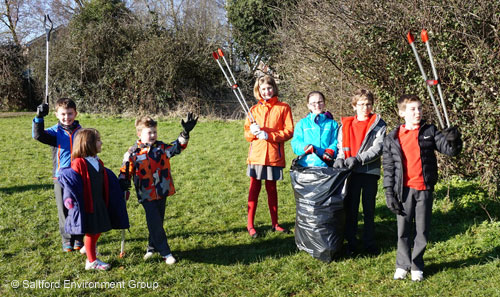
Help from Saltford School pupils to clear litter
was just one of many 2016 highlights for SEG.
Click on each story headline link or scroll down the page:-
December 2016
Proposed Saltford bypass - public meeting 1st December
1972 Saltford bypass route caused angry reaction
Bypass proposed on Saltford's Green Belt!
Geophysics search for Roman dwelling completed!
Saltford Christmas Market, 3rd December
Upcycling Group meeting, 8th December
Saltford Station questions and answers at the B&NES Cabinet meeting, 14th Nov
Development strategies under review
3-wheeled vintage vehicle identified
Helping SUSTRANS on the railway path
Saltford's permissive paths saved for another year
IEA predicts rapid transfer to electric cars and cheaper renewable energy
November 2016
Walking Saltford's history
Don't miss out on the Saltford Calendar 2017
Saltford Heritage Centre latest
Street volunteers sorting out the litter
Upcycling Group meeting in December (8th)
The benefits of allotments and growing your own vegetables
Protecting Saltford's Green Belt: Possible bypass threat in JSP
Sticky tape and wasteful purchasing
Blue Plaque commemorating Admiral Kelly unveiled at Saltford House
October 2016
The Saltford Calendar 2017
SEG's AGM 10th October - come and have your say
75th anniversary of fighter aircraft exploding on impact at Saltford station
B&NES Local Food Map
Create delicate Autumn Leaf Bowls at Upcycling Group, 20 Oct
Litter: Saltford Wombles to trial the allocation of street volunteers
Saltford Heritage Centre: Have your say!
The human response to climate change
Make your home warm and efficient for winter
Helping our dragonflies
Focus on polystyrene and waste
September 2016
Discovering Roman Saltford - next stage in the hunt for the Roman dwelling
The emerging plans for Saltford Heritage Centre
Reducing Saltford's litter
Saltford calendar 2017 is coming soon
Brass Mill open for national heritage weekend (10/11 Sept)
Protecting Saltford's Green Belt: Joint Spatial Plan update
Concrete: friend or foe?
Upcycling in September (12th)
British Food Fortnight, 17th Sept to 2nd Oct
Saltford Santa Dash, 4th December
Bath Big Clothes Swap, 14th September
Globally 2015 was the warmest year on record as upward trend continues
Station Campaign questions B&NES Council's commitment to station
August 2016:
Rabbit coursing, bull-baiting, bare-knuckle fighting - Saltford in the 19th Century!
The big butterfly count (15 July to 7 August)
Protecting Saltford's Green Belt: Joint Spatial Plan update
Businesses can bridge UK electricity capacity gap by 2020 says new report
New Giant Hogweed warning for Saltford's gardeners
A Saltford Heritage Centre?
Waitrose and its customers supports SEG
SEG supports school fair with "Slow Cycle" challenge
July 2016:
SEG to be at the school summer fair, 2nd July
Protecting Saltford's Green Belt: Joint Spatial Plan update
SEG's history project reveals fascinating new insights into Saltford's past
Saltford Upcycling Craft Group in the summer
SCA and SEG to produce Saltford 2017 calendar - want to contribute your photographs?
Tree beekeeping
Living without electricity
June 2016:
Don't mess with Saltford's Admiral Kelly!
Saltford playing field, Manor Rd, public info event, 8 June
Summer Wombling
Be a part of the Bristol Avon WaterBlitz
Thank you for your Waitrose tokens
Annual river clean held in May
Bristol to Bath Festival of Nature coming to Saltford and Keynsham 18 & 19 June
Calling Saltford's photographers
Saltford Upcycling Craft Group - June meeting
Saltford Evening Village Walk, Thurs 23 June
Tick advice
Giant Hogweed warning
Saltford Parish Council elects new Chairman
British public says renewables offer huge economic benefits - and wants more
Publishing Saltford's History Online presentation
May 2016:
Green Belt Latest: Parish and Town Councils discuss Joint Spatial Plan
350+ objections (incl. SEG's) to 250 new houses on Keynsham East's Green Belt
River clean, 15th May
Railway habitat project making great strides
Getting to grips with crochet
20th Century Saltford (and photographs wanted)
Give your mower a rest (& wildlife a chance)
Join Britain's biggest bee survey (19 May to 30 Jun)
National well-being data highlights need to protect the Green Belt
2016 Big Garden Birdwatch results: House Sparrow is tops
April 2016:
Annual Saltford Dawn Chorus Walk, 24th April
Those soaring Buzzards
Saltford Upcycling Craft Group, 21st April
B&NES gets bronze award for sustainable food
Swap clothes during Bath Fashion Week (19 April)
Saltford Spring Clean: Litter pick Sat 16th April
History of Saltford - one year on
Juliana Kelly photograph sought
Children happier outdoors; green open spaces essential for good mental health
River and Canal Water Space Study
Overcoming the politics of climate change denial
Don't expect low oil prices to remain, warns IEA
Fairtrade Fortnight quiz answers
March 2016:
Admiral Kelly - our enigmatic hero
Clearing Saltford's litter as Saltford School shows the way
Giving a new purpose to your old T-shirts
Our local habitat project has new coordinator
Keeping the Green Belt Green: Joint Spatial Plan update
Fairtrade Fortnight (29 Feb-13 Mar): Lots going on!
SEG membership now over 450
B&NES Council maintains its aspiration to open a station at Saltford
SEG submits comments for West of England Joint Transport Study
February 2016:
Let's clear Saltford's litter - village litter-picks 30 Jan & 27 Feb
Producing flowers and hearts with our Upcycling Craft Group (18th Feb)
Joint Spatial Plan and the Green Belt - SEG makes our case
Roman Saltford: Geophysics survey report published
Get in quick to access B&NES home improvement grant
Medieval artefact found on Saltford/Keynsham border
Opportunity to coordinate local habitat project
Parish Council and Saltford station
What's YOUR carbon footprint?
January 2016:
IYP2016: Eat Beans, Peas, Chickpeas and Lentils!
Development on Keynsham's (former) Green Belt near Wellsway School
Upcycling in January
Important rail electrification news
Fracking: Onshore gas exploration stays out of local area for now as National Parks put at risk
Christmas & New Year present from Paris
Big Garden Birdwatch (30/31 January): counting the wildlife that counts on you
The Wondrous Wren (in winter)
Tips on feeding garden birds
Stories start here:-
December 2016
Proposed Saltford bypass - public meeting 1st December
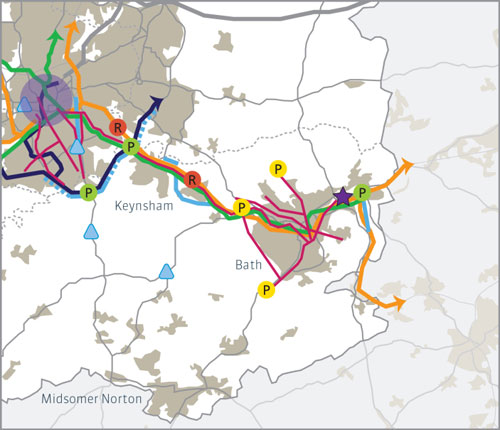
The four West of England councils - Bath & North East Somerset, Bristol City, North Somerset and South Gloucestershire - are consulting on the Joint Spatial Plan and Joint Transport Study from 7 November to 19 December 2016. As we have previously reported, you can see the plans and comment online at www.jointplanningwofe.org.uk.
The Joint Transport Study includes a map of the Bath to Bristol corridor, showing various proposals including a Saltford Bypass (shown in pale blue on the map above). Saltford Parish Council and Saltford Environment Group are in principle opposed to a bypass at Saltford, being detrimental to the Green Belt, the environment, local commerce and the integrity of Saltford as a place. Furthermore, there is a strong concern that if the bypass proposals remain in the JTS this will be a blight on the south side of Saltford for the next 20 years.
The Parish Council has organised a public meeting for Saltford's residents to be held at 7.15pm on Thursday 1st December at Saltford Golf Club. All residents are welcome to attend this important meeting to find out more and give their views.
See our other news stories on this topic below for further background information, the case against a bypass, and how to submit comments/objections to the West of England Partnership.
Return to top of page
1972 Saltford bypass route caused angry reaction
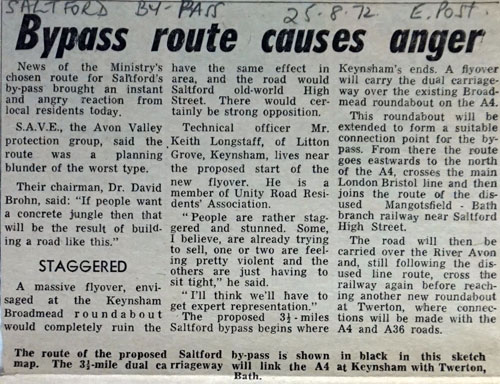
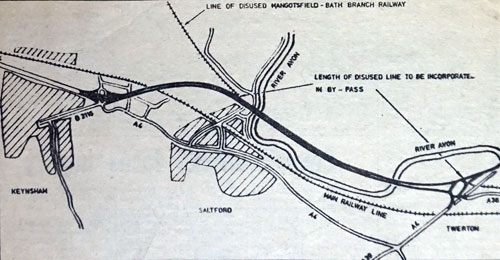
As our History of Saltford project has revealed, earlier proposals for a bypass that came to nothing caused anger at the time. The above article from the Bristol Evening Post (25 August 1972) was published two years after Saltford railway station closed and before the new housing development on the south side of the A4 in Saltford had been constructed. It shows that even then, proposals for a road bypass were proving controversial.
The plans came to nothing and in 1986 the former Midland Railway Mangotsfield and Bath Branch Line was reopened by Sustrans (founded by John Grimshaw) as the Bristol to Bath cycleway (National Cycle Network National Cycle Route 4).
Return to top of page
Bypass proposed on Saltford's Green Belt!

The West of England Joint Transport Study (JTS) describes the Bath to Bristol corridor as having "a high travel demand across car, bus and rail modes". It also "experiences severe congestion throughout the day, and access to and from South Bristol affects people's access to job opportunities, and restricts inward investment and economic regeneration."
The JTS is proposing to introduce a Rapid Transit public transport corridor between Bath and Bristol, to complement improvements on the existing rail corridor, and provide for a "wider range of trip options". This is described as possibly "bus-based but the ambition is for a light rail (tram) solution along the A4 corridor... delivered as a package with highway investment including a Saltford Bypass (see blue line close to the southern edge of Saltford's housing boundary on the above map from the study document), Callington Road (A4174 in Brislington) Link and better links between the A4 and A37 roads".
The study claims the highway schemes would provide new routes for through traffic enabling existing roads to be better used for Rapid Transit, public transport and cycling. Movements between the A4 and A37 could be either improvements to existing roads, new highway or a combination of the two.
The JTS is also proposing further park and ride sites and better cycling facilities to serve both Bath and Bristol, a new road link between the A36 and A46 to the east of Bath (which would help tackle congestion in city centre), and possible further improvements on the A37 into Bristol from the south.
The case against a Saltford bypass
In line with SEG's previously declared policies on a bypass the case against a Saltford bypass as proposed in the JTS is considerable and is as follows:-
- this would create an unacceptable loss of the Green Belt (going against promises made by the manifestos of the elected Councillors controlling B&NES Council in the May 2015 local election);
- release of the existing road capacity constraint at Saltford is likely to lead to more vehicles using the new bypass than use the existing A4 thus creating more commuter traffic than before and creating more congestion backing up down the Keynsham bypass from Hicks Gate roundabout;
- infill development (as the housing development boundary would almost certainly move out to the bypass route) and ribbon development along the outside edge of the bypass would be difficult for planners to resist or prevent thus resulting in more loss of Green Belt, more traffic congestion and Saltford changing from a rural village to a town;
- a Light Rapid Transit (LRT) system on the A4 would reduce road space for existing car-based commuters when there are better transport solutions that can be delivered much more quickly such as re-opening Saltford station;
- if a LRT is an attractive option then better alternative routes should be seriously investigated such as use of the existing LMS (Sustrans) route for an LRT alongside the cycle path;
- the Greater Bristol Strategic Transport Study by Atkins in 2006 said a bypass would "not produce an effective economic performance". Priced then at £72M (2006 prices) it said the release of the capacity constraint at Saltford would create additional traffic in Bath producing further congestion in the area and would achieve only modest time savings between Keynsham and Bath;
- local shops in Saltford would be at risk as a result of losing passing trade;
- the proposed route bypass on the southern edge of Saltford's housing development would result in a majority of Saltford residents being encircled by two main roads resulting in higher levels of noise and air pollution putting a blight on the local housing market;
- a bypass would destroy existing footpaths and bridleways;
- evidence of Roman and Bronze/Iron Age occupation on the southern side of Saltford discovered by SEG and BACAS in 2015 and 2016 requires a full archaeological study and appraisal of Saltford's Green Belt before any consideration to put at risk the local community's heritage by locating a bypass in that area;
- in the 21st Century simply building more roads is not a sustainable solution to traffic congestion. An integrated range of sustainable solutions is required including the re-opening of Saltford station on the existing station site that can be done relatively quickly. Building more roads that increase overall road traffic with higher carbon and other polluting emissions whilst creating traffic problems elsewhere just makes matters worse.
The Parish Council's view
At its 1st November meeting Saltford Parish Council agreed the following statement which will form part of its response to the JTS consultation:
Saltford Parish Council is opposed to a by-pass at Saltford, being detrimental to the Green Belt, the environment, local commerce, and the integrity of Saltford as a place. Saltford Parish Council notes the 2006 Greater Bristol Strategic Transport Study, which concluded that a by-pass at Saltford does not provide strategic benefits and does not represent value for money.
How to comment on the Joint Transport Study (and JSP)
Comments including objections to proposals in the West of England Joint Transport Study can be made online by 19th December via this external link to JTS >> or by post. Written comments on the JSP and JST can be sent to:
West of England Joint Planning Consultation
Corporate Research and Consultation Team
Civic Centre
High Street
Kingswood
Bristol BS15 0DR.
If you want to help SEG and others in Saltford prevent the unwelcome arrival of a bypass thereby turning our rural village into a town and destroying vast tracks of Green Belt land, make sure you submit your comments to the West of England Partnership before the 19th December deadline using planning based reasons (e.g. as given above) to support your objection.
On 27 January 2016 SEG submitted a policy paper 'Very special circumstances and the Green Belt' to the West of England Partnership as its response to the consultation for 'Issues and Options' in the West of England JSP. The Green Belt is a much valued designation the protection of which is increasingly vital. The paper covers these topics:-
- Population growth, food security and protecting our 'natural capital'
- Where do we put new housing?
- Green Belt planning policy
- Democracy and political considerations in B&NES and Saltford
- Sustainable development
You can download SEG's papers from our Green Belt page or here:
'Very special circumstances and the Green Belt' (pdf)
'A road bypass for Saltford? A discussion paper (2013)' (pdf)
Return to top of page
Geophysics search for Roman dwelling completed!
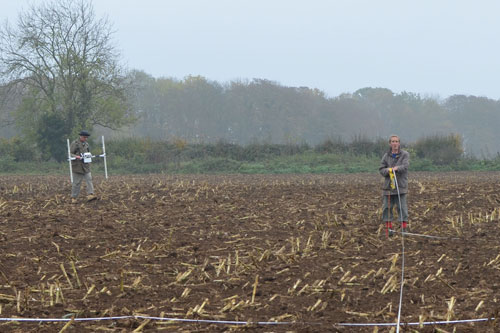
John Oswin (BACAS) & Bob Mordle (SEG) preparing to start the survey.
(1.11.2016)
In autumn 2015 Bath and Camerton Archaeological Society (BACAS) supported by volunteers from SEG carried out a geophysics survey for a significant section of the field on the south side of Saltford where a Roman coffin complete with the skeleton of a young man was found in 1948. In addition to the possible presence of some prehistoric roundhouses in the northern portion of the field, signs of what may be a Roman structure on higher ground to the southern end of the field were discovered.
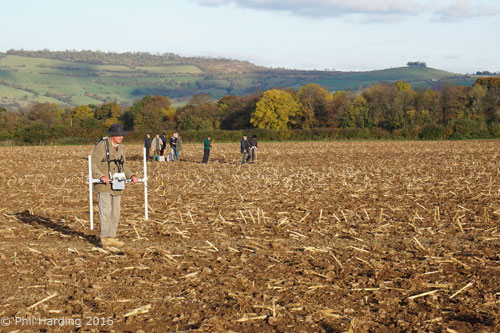
Geophysics surveying on day 2 (2.11.2016).
On 1st November with kind permission of the farmer Adam Stratton the search restarted from where we left off and this was completed on 10th November. SEG is very grateful to our friends and colleagues from BACAS and SEG volunteers for the hard work and dedication in undertaking and completing this fascinating survey.
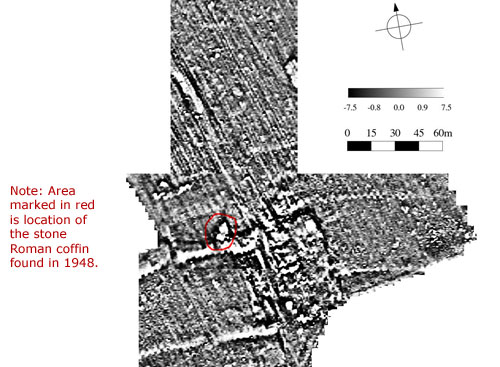
Extract from survey results at end of day 2 (2.11.2016).
The above image is from the survey results at the end of day 2. On the right bottom (south) of the image can be seen what appears to be a very large building, approximately 60 metres x 70 metres. This is very close to where the Roman stone coffin complete with Roman skeleton was found in 1948 and in view of the Roman artefacts found at this location this could well be a Roman building.
To the left (west) of the building are two large ditches running east-west. These might be for retaining livestock, irrigation or some other purpose. We will publish further information when expert analysis from our colleagues at BACAS has been completed and the final survey report published on this website in the coming weeks.
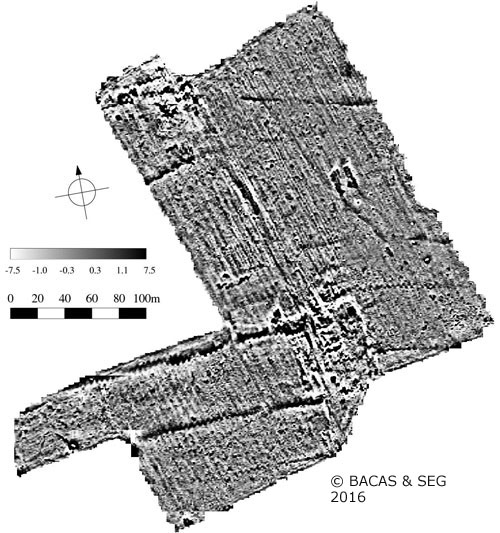
Image showing final geophysics results 10.11.2016.
For further information about Roman Saltford and last year's geophysics survey visit our Online Museum from this link: Online Museum. You will be able to see many fascinating Roman artefacts found in Saltford including a rare Roman gilded brooch complete with black gemstone found near the location where we are searching for the dwelling - the brooch is ear-marked for the new Heritage Centre.
FOOTNOTE: With the landowner's permission for each survey, the field has been the subject of several metal detection surveys in recent years and these have revealed some bronze Roman coins, and other small bronze items that can be found in our history project's Online Museum. Due to those surveys the discovery of further coins etc. of any particular new significance or value is not anticipated.
Return to top of page
Saltford Christmas Market, 3rd December

On Saturday 3rd December Saltford's annual Christmas Market will be held at Saltford Hall from 10am to 3pm, complete with Santa's Grotto and SCA's festive café. There will be a huge variety of stalls selling crafts, toys, plants: you name it, it's probably there.
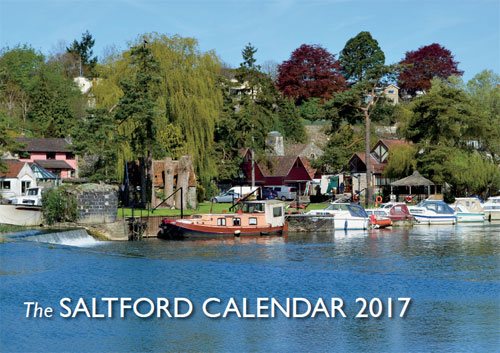
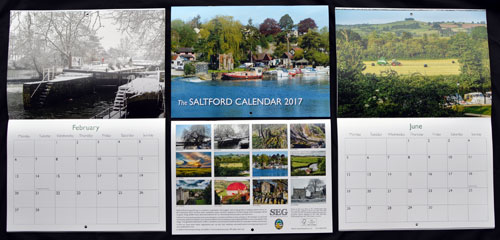
The fabulous 2017 Saltford Calendar and Christmas Cards will also be available to purchase at the Christmas Market on 3rd December. At just £6 each you can also get your calendar(s) from the SCA office at Saltford Hall any morning Monday to Friday.
Come and relax on 3rd December with a glass of mulled wine and a mince pie or SCA's now famous Newton Farm bacon rolls in the café.
Return to top of page
Upcycling Group meeting, December (8th)
Our next meeting is on Thursday 8th December. With Christmas on the way we will be making our own festive wreaths using things we can find in the garden, hedgerows, or recycling boxes.
Decorations can be created from fruit and veg nets, pretty paper and pretty sweet wrappers etc. as well as natural finds (fir cones, berries, seed heads, etc.) and dried oranges etc., depending on where you will display your decoration. Do bring along any withies or bendy branches your can find to form the base circle and greenery to infill.
Let your imagination run riot, traditional or modern to decorate your wreath. We will have some metal bases as well as wire and greenery etc. to add to add to the mix that we all share. Enjoy a fun, relaxing evening with us on the run up to your Christmas.
Frances and Tina are looking forward to seeing you on December 8th, 7-9pm, at Signs of Saltford (works entrance) 559 Bath Road, Saltford. Call Frances Eggbeer on 07789--528834 if you would like to know more about SEG's free Upcycling Group.
Return to top of page
Saltford Station questions and answers at the B&NES Cabinet meeting, 14th Nov

Image © SEG
Two questions concerning Saltford station were asked by Councillor Neil Butters (Lib Dem) for the B&NES Cabinet meeting on 14th November. The answers from Cabinet member for Transport, Councillor Anthony Clarke (Cons), are shown here also:-
Q 12. I understand that the MetroWest Phase1 GRIP 3 Timetable Analysis remit specification only proposes a sensitivity test for "inclusion of call at the proposed Saltford Station". Was it an officer or a Cabinet member who made the decision to exclude Saltford Station at the outset from the substantial study?
A.12.This was an officer decision taken at the MetroWest Phase 1 project board. I and the Leader have met with both GWR and the Saltford Parish Council to understand the technical challenges with this work. It is very frustrating that it is still not clear that a timetable is possible that would support a new station at Saltford. This difficulty has been discussed with the Parish Council on a number of
occasions. A new station to serve the communities in and around Saltford is included within the Joint Transport Vision published by the West of England; this is something for which I have personally argued.
Q 13. Has any Cabinet member contacted GWR and/or Network Rail directly seeking progress of the timetable analysis in relation to Saltford?
A 13. As noted above I regularly meet with GWR and at the last six or so occasions I have specifically requested that time-tabling work should be undertaken. Officers have also requested the information.
Return to top of page
Development strategies under review
B&NES Council is reviewing its Core Strategy and launched a consultation exercise on 7th November to seek views on the proposed content, scope and programme for the Core Strategy Review for the period 2016-2036. The Consultation runs from 7th November to 5pm on 19th December 2016. It will set the revised housing numbers for Bath & North East Somerset and an affordable housing target up to 2036.
Consultation on the Core Strategy Review Commencement Document is taking place at the same time as the West of England's consultation on the Joint Spatial Plan (JSP) and the Joint Transport Study also launched on 7th November. The JSP sets the context for the B&NES Core Strategy review. Further details on the JSP consultation which closes on 19th December can be accessed on the West of England website: www.jointplanningwofe.org.uk.
SEG reported on the JSP consultation and our concerns (loss of green belt agricultural land, loss of wildlife and local landscape character, housing infill, more commuter traffic, etc.) over the re-emergence of proposals for a Saltford bypass in October (see our October newsletter for details).
Public engagement meetings/events for the JSP and Joint Transport Study are planned for each local authority area. For B&NES displays will be in:
- Keynsham
Keynsham library, Keynsham Civic Centre, BS31 1FS, 7-18 Nov.
- Midsomer Norton
The Hollies Reception, Midsomer Norton, BA2 2DP, 21 Nov - 2 Dec.
- Bath
One Stop Shop, Lewis House, Bath BA1 1JQ, 5-16 Dec.
Returning to the Core Strategy Review, this will allocate strategic sites at locations identified in the JSP and other "development opportunities" will be identified and allocated. B&NES Council will also take the opportunity to look again at other policy areas such as renewable energy targets and what infrastructure is needed to support additional development.
Comments on the Core Strategy Review Commencement Document can be made online at www.bathnes.gov.uk/corestrategyreview or via e-mail to core_strategy@bathnes.gov.uk. B&NES have stated that it would be helpful if comments were focussed just on the proposed content, scope and programme for the Core Strategy review at this stage.
The Core Strategy Review Commencement Document can also be viewed at all libraries in the District and the main Council offices during normal opening hours.
Return to top of page
3-wheeled vintage vehicle identified
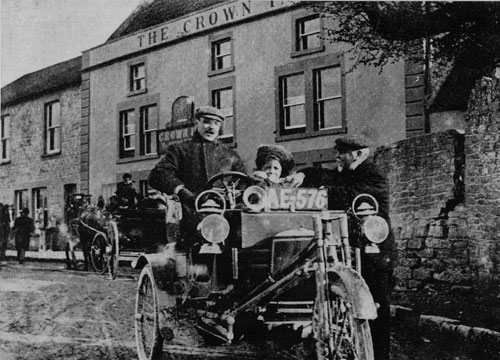
The Crown Inn and 3-wheeled car, early 1900s (estimated 1906-10).
Further to our request posted on our website during November for assistance with identifying the car in this evocative and fascinating photograph of one of Saltford's former coaching inns, The Crown Inn, from the early 1900s we have heard from the highly respected and leading motoring historian and journalist, Michael Worthington-Williams in Carmarthenshire, who has also kindly helped identify other vintage motor cars pictured in our Online Museum.
According to Michael Worthington-Williams the car is an Avon Trimobile built by the Avon Motor Manufacturing Co Ltd of Keynsham, who were in business from 1903 to 1912, latterly with four wheeled cars.
The Trimobile was powered by their own single cylinder water cooled engine with sizes ranging from 4, 4.5, 5 and to 6 hp. The vehicle had a three speed gearbox and chain final drive. Their London agents were the Otto-Bennett Motor Co in Snow Hill, but most sales were local to the Bristol area. Prices ranged from 60 to 95 guineas (the 4-wheeled version was 106 guineas).
Michael Worthington-Williams has also kindly supplied SEG with a copy of the original Avon Motor Manufacturing Co sales leaflet for this vintage vehicle. This and pictures from 1905 of the Avon Trimobile in service as the first motor vehicle used in Bristol for the fast road transport of the Royal Mail can be seen in our Online Museum on the 20th Century page's Transport section.
Return to top of page
Helping SUSTRANS on the railway path
by SEG Committee member, Frances Eggbeer
It's always good to meet up with new people with the same interests and that's what I did on Saturday October 29th. Organised by Emma Downie from Sustrans Bristol East Group and joined by the Sustrans Bath & 2 Tunnels Group with co-ordinator Andy Richman, around 20 volunteers met at 10am on the bridge behind the Bird in Hand ready to clear the vegetation along the margins of both the road and river bridges.
Although the edges of the track look softer with vegetation, the roots can cause damage to the infrastructure of the bridges if left to grow, and as with our own work on the bank further along, digging up the weeds and ensuring larger roots don't take hold makes the job less arduous in the future. It was good to hear about other volunteers' connections to the track and what they enjoy about it. Whilst some cyclists passed us by with heads down, the majority thanked us for the work we were doing and by being highly visible we gave fellow users of the track an appreciation of how some of the maintenance of track is carried out by volunteers.
It wasn't all new faces that morning, I was pleased to meet up with Will Duckworth (SEG's Wildlife Surveyor & Wildlife Conservation Adviser) who was also helping. During our tea and biscuit break Will told everyone about SEG's aims and progress on the bank we are restoring (details from this link) and through this we have recruited some new people to join our working parties.
It was amazing to see what can be achieved in just 3 (short) hours. Do please take a look at the work carried out by Sustrans and SEG which we hope will inspire you to come along and join SEG's working parties. The company is welcoming and friendly and you too can experience the seasons as they progress and see how the work you have done has enhanced the area.
Return to top of page
Saltford's permissive paths saved for another year
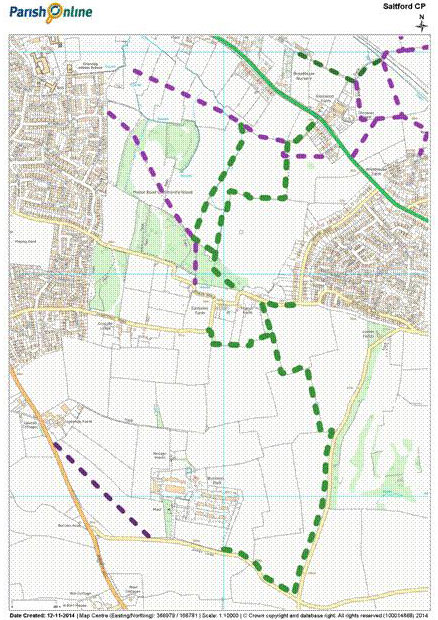
We are delighted to report news from Saltford Community Association that due to generous support from I J McGill Transport, the permissive paths (shown in green on the above map) between Saltford and Keynsham will remain open for another year. SCA passes on a huge thank you to all those who have donated over the last year. Any surplus will be carried over to the following year's appeal, which SCA say is now open.
Return to top of page
IEA predicts rapid transfer to electric cars and cheaper renewable energy
Headline news
As a result of major transformations in the global energy system that take place over the next decades, renewable energy sources and natural gas are the big winners in the race to meet energy demand growth until 2040, according to the latest edition of the World Energy Outlook, the International Energy Agency's flagship publication that was released on 16th November.
A rapid growth in the take up of electric vehicles, and significant reductions in the cost of renewable energy, especially solar PV (photo voltaic), are forecast for the coming decades. Coal consumption barely grows in the next 25 years, as demand in China starts to fall back thanks to efforts to fight air pollution and diversify the fuel mix.
The gas market is also changing, with the share of Liquefied Natural Gas (LNG) overtaking pipelines and growing to more than half of the global long-distance gas trade, up from a quarter in 2000.
Those are the key headlines. Here we provide just some of the detail from the IEA forecasts for electric vehicles and renewable energy.
Electric vehicles ready to move
The projected rise of electricity consumption in road transport is emblematic of the broader trend, as electric cars gain consumer appeal, more models appear on the market and the cost gap with conventional vehicles continues to narrow. The worldwide stock of electric cars reached 1.3 million in 2015, a near-doubling on 2014 levels. In the IEA's main scenario, this figure rises to more than 30 million by 2025 and exceeds 150 million in 2040, reducing 2040 oil demand by around 1.3 million barrels per day.
Although battery costs continue to fall, supportive policies - which are far from universal for the moment - are still critical to encourage more consumers to choose electric over conventional vehicles. If these policies, including tighter fuel-economy and emissions regulations as well as financial incentives, become stronger and more widespread, the effect is to have some 715 million electric cars on the road by 2040, displacing 6 million barrels per day of oil demand.
Renewables break free
The electricity sector is the focus of many pledges for the 2015 Paris Agreement (to limit global average temperature rise to "well below 2degC") ratified during October/November. Nearly 60% of all new power generation capacity to 2040 in the IEA's main scenario comes from renewables and, by 2040, the majority of renewables-based generation is competitive without any subsidies. Rapid deployment brings lower costs: solar PV is expected to see its average cost cut by a further 40-70% by 2040 and onshore wind by an additional 10-25%.
Subsidies per unit of new solar PV in China drop by three-quarters by 2025 and solar projects in India are competitive without any support well before 2030. Subsidies to renewables are around $150 billion today, some 80% of which are directed to the power sector, 18% to transport and around 1% to heat. With declining costs and an anticipated rise in end-user electricity prices, by the 2030s global subsidies to renewables are on a declining trend from a peak of $240 billion.
Renewables also gain ground in providing heat, the largest component of global energy service demand, meeting half of the growth to 2040. This is mainly in the form of bioenergy for industrial heat in emerging economies in Asia; and solar thermal applications for water heating, already an established choice in many countries, including China, South Africa, Israel and Turkey.
The World Energy Outlook report can be found on the IEA website www.iea.org.
Return to top of page
November 2016
Walking Saltford's history
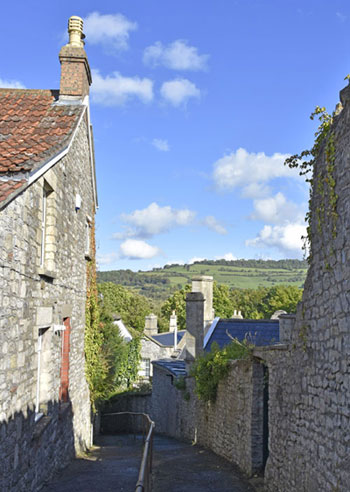
A footpath view near The Batch on Walk 5
('Village footpaths, Brass Mill & The Shallows')
A new feature launched in October from SEG's History of Saltford project is the publication of guided history walks of Saltford. You can view online guides and follow a web page for directions on your smartphone or print off your own pdf version of each walk.
There are 8 walks in the series:-
- Norman Road, northern footpaths and the fish ponds
- Longwood and a Roman dwelling site
- Manor Road Community Woodland and an old road to Keynsham
- Village footpaths, Brass Mill and The Shallows
- Railway path and the Saltford Straight (River Avon)
- Swineford and Kelston Mills
- Saltford's Conservation Area
We also provide links to online guided heritage walks from other organisations. You can find the walks via the history project's A-Z page or directly from this link: Walks of Saltford.
Return to top of page
Don't miss out on the Saltford Calendar 2017

The Saltford Calendar 2017 (front cover)
The production of an annual Saltford Calendar is a joint SEG/SCA initiative. "The Saltford Calendar 2017" is now available to purchase from SCA - with Christmas approaching fast it makes a great gift and celebration of our lovely village.
At just £6 each you can get your calendar(s) from the SCA office at Saltford Hall any morning Monday to Friday or at the Christmas Market on 3 December. Alternatively email events@saltfordhall.co.uk
All net proceeds will be split between SCA and SEG to help further their voluntary work supporting the local community.

If you love Saltford, you'll love this!
Return to top of page
Saltford Heritage Centre latest
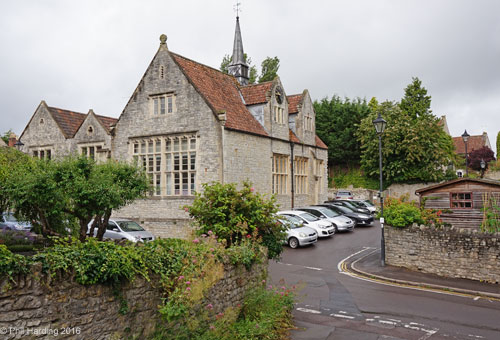
St Mary's Church Hall (2016)
We are delighted to report that Councillor Emma Dixon has thrown her full backing behind the Saltford Heritage Centre project by providing some sponsorship support from her allocation of the 'Ward Councillors Initiative Fund'. We are very grateful to Emma whose very useful support will help us create displays relevant to the needs of Saltford School when the children visit the centre once it is operational - all being well by next June's Saltford festival.
Many thanks also to those who have already completed the online survey about the project. If you haven't done this yet we would really appreciate it if you would take just 2-3 minutes to complete the short online survey at https://www.surveymonkey.co.uk/r/RWPN5JQ to help us steer and develop the Saltford Heritage Centre project. We want to ensure that what is delivered is relevant and accessible. Thank you for your time!
The purpose of a new Saltford Heritage Centre will be to undertake the stewardship of Saltford's history by actively collecting, preserving and interpreting documents and artefacts, and by promoting our heritage. It will provide a useful educational resource and occasionally host history events organised by third parties. It will also incorporate a pop-up-heritage display to take to local events.
The dedicated web page within SEG's online History Project for the proposed Saltford Heritage Centre can be found if you click here: Heritage Centre.
Return to top of page
Street volunteers sorting out the litter

Members will recall Saltford Wombles' new approach to keeping down the litter accumulating in Saltford with the allocation of streets to volunteers (individuals or families) who will regularly check for and clear litter on a street or street route such as a route that they regularly walk.
Already this is proving an effective approach in the areas covered and our thanks go to both the street volunteers and everyone else who does their part to pick up litter in the street where they live or regularly walk. Between us we can make litter less evident in our village.
The growing team of street volunteers are now covering the following streets in Saltford:-
CENTRAL
- Bath Rd A4 from Norman Rd to Beech Rd/Manor Rd crossroads (JS)
NORTH
- Stratton Rd into & including Chelwood Rd to Saltford Hall (SH)
- The rectangle of roads formed by Norman Rd, Brockley Rd & Stratton Rd + Stratton Rd cul-de-sac (JE)
- High Street (IC & PH)
- The Shallows (TH)
SOUTH
- Claverton Rd West (J&LP)
- Anson Close (PH & TW)
- Claverton Rd (PH)
- Manor Rd from A4 to where it meets Golf Club Lane (AS)
- Manor Rd from where it meets Golf Club Lane to Montague Rd & Montague Rd (MW)
- Haselbury Grove (MC)
- Grange Road (D&PC, K&DP)
- Kingston Ave, Lawson Close, Hermes Close & Mansel Close (FE)
- Beresford Close & Somerville Close (JA&F)
- Lanes to Keynsham from the top of Grange Road (TW)
If your street or a street that you regularly walk along is not included and you would like to take responsibility for keeping it litter free, contact SEG. Alternatively if you want to volunteer for a road that is already covered that's great but it is helpful if you let us know.
There will be no organised litter-picks over the winter months as the weather is so unpredictable, but do contact Julie Sampson if you want to borrow a litter-picking tool (although not using a litter-picking tool when out picking up litter shows to other residents and visitors that picking up litter is the normal thing to do - not just an occasional one-off!).
Return to top of page
Upcycling Group meeting in December (8th)
    
There will be a change of date for our next meeting, we will be combining our November and December meetings on December 8th, the second Thursday in the month. Following our UPCYCLING theme with Christmas on the way we will be making our own festive garlands using things we can find in the garden or hedgerows.
The decorations can be created from fruit nets, paper, pretty sweet papers etc as well as natural finds depending on where you will display your decoration. Look out for more information in our next newsletter/website home page.
Return to top of page
The benefits of allotments and growing your own vegetables

From an article published at www.gardenbuildingsdirect.co.uk/blog/allotment-gardening.
Industrialisation brought intensive labour but did little to meet the health needs of the poor. The Victorians saw this and took good notice. Lands were given for factory workers to feed themselves and to promote a healthy lifestyle.
By the end of the First World War, lands were also made available to servicemen to assist them in their return. With the skyrocketing of allotment activities and the number of people getting interested in it, the government passed laws for local authorities to provide sufficient lands in their areas.
Long ago, as in the Anglo-Saxon times, allotments were traditionally measured in rods or poles. A typical allotment measures: 100ft by 30 ft or 250 square metres - about the size of a doubles tennis court.
But this standard measurement wasn't used on a whim; it was said to be sufficient for the annual food needs of a family of four. And people strictly held on to that standard; anyone who suggested a cut in size was met with opposition.
In the UK, the number of poor in cities and large towns increased whilst lands were being enclosed by a few landowners. The obligation fell on local authorities to provide allotments to meet public demand through the Allotments and Cottage Gardens Compensation for Crops Act 1887. The Small Holdings and Allotment Act 1908 provided more allotments and attempted to resolve any anomalies.
But times have changed. With the fast and busy way of modern life gardeners in urban areas particularly find it more manageable to grow in half the size of a standard allotment. Furthermore, smaller allotments mean more gardeners-in-waiting can plant their own food. That might mean less produce per family, but more families are involved in growing food.
Present day situations have also called for some changes to stiffen the law and protect plot holders. The continuing struggle with urban development issues moves allotment holders to rally against their local councils and fight for their piece of "paradise". Some are also calling for more government support of this long-held tradition.
The following listed benefits of allotments apply equally to how we manage our gardens.
1. Food supply all year round
Being the most obvious, getting fresh vegetables and fruit is your top advantage for having an allotment (or vegetable/fruit plot in your garden). You get access to seasonal produce that has been grown using safe organic methods (if, of course, you go for the organic gardening approach). Studies also show that the faster freshly harvested food reaches your table, the better.
2. Find new friends
Gardening alone at home gives you certain peace, but gardening in a community has its advantages, too. There, you get to meet other gardeners, food lovers or neighbours whom you might have never got acquainted with if not for your shared interest. It allows you to socialise, form new friendships or reconnect with old ones, and have fun. (If you don't have an allotment but a large vegetable/fruit garden sharing your excess produce with neighbours and friends is a great way to connect with each other.)
3. Save money
The soil proves to be the closest friend a man or a whole nation can turn to when the economic weather gets challenging. Families learn to grow their own food to save money, which then collectively result in national savings in terms of food supply and health treatment.
4. Reclaim land
Allotments are most often built on neglected large areas. By creating garden plots, these lands become productive and lively with recreational activities.
5. Improve your mental health
Struggling with mood and self-esteem? Studies also show that gardening has positive impact on mental health and general well-being. Just 30 minutes of digging and plant-tending dissolves tension and depression and boosts feelings of happiness.
6. Get physically fit
Physical fitness is also a gardening perk. The Journal of Public Health found that 68% of non-gardening groups are obese as compared with just 47% of gardeners. Gardening, e.g. digging, can be tough calorie-burning exercise.
7. More Vitamin D(!)
Getting exposure to the sun whilst gardening also has its benefits (but be careful to avoid sun burn). 15 to 90 minutes a day of sun exposure, depending on your skin type, can help build up a good level of Vitamin D.
Return to top of page
Protecting Saltford's Green Belt: Possible bypass threat in JSP
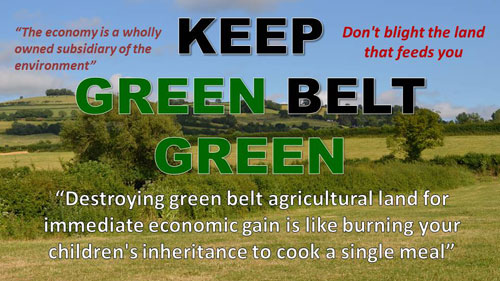
As we have reported previously, B&NES Council has confirmed that development on Saltford's Green Belt was not being proposed for the draft Joint Spatial Plan that is being drawn up by the West of England Partnership comprising the four local authorities of B&NES, South Glos., Bristol, and North Somerset Councils. However the draft proposals include a proposed local Saltford bypass hugging Saltford to the south. The indicative map shows the A4 coming from or near the Broadmead roundabout area at Keynsham, looping around the south of Saltford and returning to the existing A4 somewhere near The Globe.
The map is conceptual and does not show a precise route however we do know that new housing is already planned for the east (Saltford) side of Keynsham by the Broadmead Roundabout. That development could mean that a by-pass route might be even be closer to Copse Road and Grange Road.
SEG published a policy paper in 2013 (this can be found on our Green Belt page) warning of the downsides to a bypass including the loss of green belt agricultural land, wildlife and local landscape character, destruction of existing footpaths and bridleways and a threat to local businesses losing out on passing trade. The paper also highlighted the point that the release of existing capacity constraint on the roads is likely to lead to more vehicles using the new bypass than use the existing A4 thus creating more commuter traffic than before. The infill development (as housing development boundary would almost
certainly move out to the bypass route) would result in more loss of green belt and Saltford changing from a rural village to a town.
There is to be a public consultation on the JSP proposals over a short period of time, from 7th November until 19th December. The website address for making responses once the consultation papers are published on 7th November is www.jointplanningwofe.org.uk.
If you wish to object you will have until 19th December to do so but remember to use sound planning reasons for objecting, rather than just personal reasons, if you want your objection to have effect. Our policy papers give those reasons.
(i) Background to JSP and Transport Study, and
(ii) Policy papers from SEG
Background
The West of England's Joint Spatial Plan and Transport Study (www.jointplanningwofe.org.uk) will
"set out a prospectus for sustainable growth that will help the area (Bristol, North Somerset, South Gloucestershire and Bath & North East Somerset) meet its housing and transport needs for the next 20 years."
Estimates state that the area needs at least 85,000 new homes by 2036, that is 29,000 more than the number already planned in Core Strategies, as well as the transport and other infrastructure needed to support that level of growth.
In B&NES, the B&NES Core Strategy (2014-2029) that was agreed in July 2014 after lengthy negotiations and public consultation is undergoing an early review in tandem with the Joint Spatial Plan (JSP). Once agreed the JSP (2016-2036) will in effect override the B&NES Core Strategy for determining the location and size of new housing developments in B&NES until 2036. The B&NES Core Strategy is being reviewed simultaneously so that its timespan will be extended to match that of the JSP.
Policy papers from SEG
On 27 January 2016 SEG submitted a policy paper 'Very special circumstances and the Green Belt' to the West of England Partnership as its response to the consultation for 'Issues and Options' in the West of England JSP. The Green Belt is a much valued designation the protection of which is increasingly vital. The paper covers these topics:-
- Population growth, food security and protecting our 'natural capital'
- Where do we put new housing?
- Green Belt planning policy
- Democracy and political considerations in B&NES and Saltford
- Sustainable development
You can download SEG's papers from our Green Belt page or here:
'Very special circumstances and the Green Belt' (pdf)
'A road bypass for Saltford? A discussion paper (2013)' (pdf)
Return to top of page
Sticky tape and wasteful purchasing

With Christmas approaching all too fast, we have reproduced extracts from a recent thought-provoking article by Dr Martin Gibson, Sustainable Business Director at the Oxfordshire based Earthly Gains consultancy and former head of a major UK Government programme on reducing pollution and waste. Dr Gibson sheds some light on poor design and our purchasing choices:-
As you probably know, there is a lot of support for transforming our economy into one in which resources are kept in circulation for as long as possible, in other words, a circular economy. In such an economy, production and service systems are designed to maintain the value of resources through many product life cycles.
At the moment most of our systems assume that we extract resources from the Earth, make something with them and then discard the thing we have made once we are finished with it. This approach is depleting resources and we are starting to be constrained by the limits of our planet. If everybody lived the way people in developed countries do, we would need about three planets in order to have a long-term, sustainable economy. So we need to change, and the sooner the change comes, the less disruptive and cheaper it will be.
Most of us interact with the economy when we buy things. A resource efficient economy would need to ensure that consumers were able to minimise the resources associated with their purchases. Purchasing should encourage the choice of longevity of a product. One aspect of this is how easily consumables can be replenished. After all you wouldn't want to throw away your printer every time the ink ran out, would you?
Our current systems are very poor at nurturing resources, particularly for inexpensive items. I was struck by this when I went to buy two simple things yesterday: a roll of sticky tape and a refill for a ball point pen.
I wanted more sticky tape for my tape dispenser. While many shops were happy to sell me a new dispenser with extra rolls of tape, I went into five shops before I found one that just sold the tape. The odd thing was that the tape alone cost about the same amount as the dispenser with spare tape. So apparently the value of the dispenser was negligible. The materials and energy that went into producing it gave no extra cost compared to just producing a roll of sticky tape. Also, if you buy the new dispenser and tape, your existing tape dispenser becomes effectively valueless and is probably thrown away. There is a cost of waste disposal but this is not factored into the purchase decision.
How can our economic system put no value on a product that takes resources and energy to produce and dispose of?
I had a similar issue with a pen. I have a nice ball point pen that takes a simple refill. None of the five shops that I tried sold a simple refill. I could buy a new pen with lots more material, making my nice pen a waste item, but I could not buy just a refill. Refills were available for many pens but these were all more complex and expensive rather than the simple one that I needed. So apparently we can only make a business case for the replenishment of consumables for something expensive. If we want something simple and inexpensive, we have to add unnecessary material with lots of components rather that minimising the use of resources. This also leads to more waste.
Is it just me or does this seem madness to you too?
Return to top of page
Blue Plaque commemorating Admiral Kelly unveiled at Saltford House
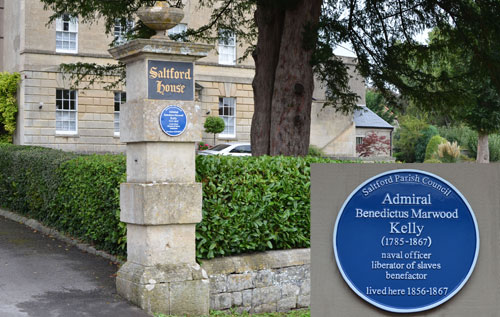
The plaque (inset to show detail) on Saltford House gate post.
On 1st October the MP for North East Somerset, Jacob Rees-Mogg, unveiled a Blue Plaque at Saltford House, High Street, Saltford commemorating Admiral Benedictus Marwood Kelly (naval officer, liberator of slaves, benefactor) who lived in Saltford from 1856 until 1867.
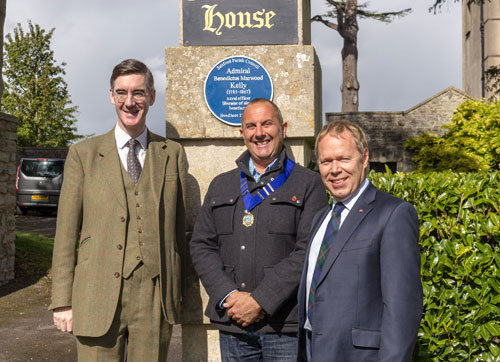
Jacob Rees Mogg MP with Saltford Parish Council
Chairman Chris Warren and SEG Chairman Phil Harding
Photograph © Jess Godfrey 1.10.2016
Jacob Rees-Mogg said "It is important that local communities celebrate and mark those who once lived amongst them and had made a contribution to important issues such as the abolition of slavery. I, therefore, very much welcome the work by Saltford Environment Group and Saltford Parish Council to celebrate Admiral Kelly and to revive his memory in his local community and further afield so that more people may learn about his remarkable life."
Chairman of Saltford Environment Group Phil Harding, who had carried out extensive research on Admiral Kelly, said: "We were astounded to discover what a remarkable life Admiral Kelly had lived, his contribution to help end slavery, and significant support for the education of children in the 19th Century. His lifetime of serving his country and helping those in greatest need can inspire others. We here in Saltford were delighted that Bath and North East Somerset Council gave planning permission for the Admiral's blue plaque to mark this former
resident's important contribution to a better society."
Saltford Parish Council had sought and obtained planning permission for the plaque to be fixed to one of the Grade II Listed stone entrance gate posts at Saltford House. Saltford House was Admiral Kelly's home in Saltford from 1856 until 1867 when he died there. The web page dedicated to Admiral Kelly which carries full details of his remarkable life can be found on SEG's history project web site from this link: Admiral Benedictus Marwood Kelly
Return to top of page
October 2016
The Saltford Calendar 2017

The Saltford Calendar 2017 (front cover)
The production of a high quality and attractive annual Saltford Calendar is a new joint SEG/SCA initiative. "The Saltford Calendar 2017" is now available to purchase from SCA - it makes a great gift and celebration of our lovely village.
At just £6 each you can get your calendar(s) from the SCA office at Saltford Hall any morning Monday to Friday and at the Grand Flea Market on 2 October or at the Christmas Market on 3 December. Alternatively email events@saltfordhall.co.uk
This is planned to be an annual initiative so if you have friends and family around the UK and overseas who appreciate Saltford, this will make a great regular annual gift. All net proceeds will be split between SCA and SEG to help further their voluntary work supporting the local community.

If you love Saltford, you'll love this!
Return to top of page
SEG's AGM 10th October - come and have your say
Members are invited to our 2016 AGM which will be held at Saltford Hall commencing at 7.30pm on Monday 10th October.
This is our annual opportunity to engage with all our members and make sure we're listening to you, and therefore we would be delighted to see you there.
For some of our members this may be an opportunity to see if you might want to get more involved in SEG, either as a potential Committee Member or in a less formal supporting role related to your own specific interest, e.g. history or wildlife.
The agenda will be:
1. Welcome
2. Apologies for absence
3. Matters arising from last AGM (5.10.2015)
4. Reports from the Chairman and Treasurer & Questions
5. Election of Officers: Chairman, Secretary, Treasurer
6. Election of up to 9 Committee members
7. Resolutions from members (to be sent to the Sec. at least 7 days before the AGM)
8. Open Forum on matters of interest raised by members (this is also AOB)
9. Close
Please note that as our newsletters and website keep members informed of our activities, we shall avoid spending time going over in detail all that we have done in the past year but you will of course be able to ask questions on any of our activities.
Nomination forms for joining our Committee are available by email request to the Secretary, Debbie Cini, at mail@deborahwilkes.co.uk. These should be completed and returned to Debbie 7 days before the date of the AGM.
Return to top of page
75th anniversary of fighter aircraft exploding on impact at Saltford station

Westland Whirlwind Mk 1
(Photograph: collection of the Imperial War Museums)
It is the 75th anniversary on 9th October when in 1941 during World War II a Westland Whirlwind fighter aircraft crashed into the weighbridge at Saltford station and exploded on impact, killing the pilot, Ormonde Hoskins of 263 Squadron.
Saltford resident Dave Taylor, then a nine year old lad, was standing on the station platform watching with a friend as the steam trains passed through. The aircraft smashed into the weighbridge in the station yard and exploded on impact, turning into a huge fireball. This was behind the platform opposite to the platform where Dave was crouching having heard the high pitched scream of the rapidly descending aircraft.
Dave was injured by flying debris and re-told his story to SEG 70 years later in 2011 which, as it helped illustrate the role the station had played in village life, we then published as part of our campaign to re-open Saltford railway station.
The crash was caused by the mid-air collision of two RAF Westland Whirlwind fighter aircraft that were out on flight exercises. They were in a group of six returning to base when the last two Westland Whirlwinds collided.
The other pilot involved in the collision was Flight Lieutenant Humphrey Coghlan; he bailed out at 5,000 feet and landed in Weston High Street (on the West side of Bath). His Westland Whirlwind crashed at Kelston.
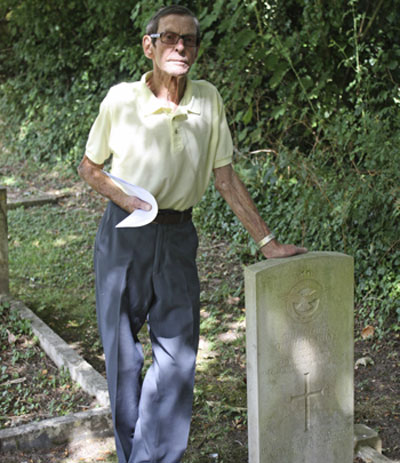
Dave Taylor at the grave in Salisbury of pilot Ormonde Hoskins, 2014.
You can read Dave Taylor's full and illustrated account of the crash and the lasting impression it made on him in our history project Online Museum. Click here to download the pdf: 1941 Westland Whirlwind Crash (pdf, opens in new window).
BACKGROUND NOTE ON THE WESTLAND WHIRLWIND
Information courtesy of en.wikipedia.org/wiki/ (2016)
The Westland Whirlwind was a twin-engined heavy fighter developed by Westland Aircraft. A contemporary of the Supermarine Spitfire and Hawker Hurricane, it was the RAF's first single-seat, twin-engined, cannon-armed fighter.
When it first flew in 1938, the Whirlwind was one of the fastest and most heavily-armed combat aircraft in the world. Protracted development problems with its Rolls-Royce Peregrine engines delayed the project and only a relatively small number of Whirlwinds were built. During World War II, only three RAF squadrons were equipped with the Whirlwind, and despite its successful use as a fighter and ground attack aircraft it was withdrawn from service in 1943.
If you are interested in the Westland Whirlwind, there is a Whirlwind Fighter Project to reproduce a single example of the aircraft. The project's website is at: www.whirlwindfighterproject.org.
Return to top of page
B&NES Local Food Map
BUY LOCAL FOOD BUY SEASONAL FOOD FARM SHOPS SUSTAINABLE FOOD ORGANIC FOOD
SEG has added a link to the new online B&NES local food map from our links page. The new service will make it easier for residents and visitors to find local food producers and retailers in Bath and North East Somerset and to buy local food and drink directly online via an online marketplace and home delivery service.
Return to top of page
Create delicate Autumn Leaf Bowls at Upcycling Group, 20 Oct
How to keep the lovely colours of Autumn alive. October brings out beautiful colours in the leaves and we shall be using them to make a delicate bowl. There are a couple of methods of making these and we are using a bowl to mould our leaves on. You will need to bring along the following items - a bowl or basin plastic or glass would be suitable, (the pictures give you some idea of the shape) it shouldn't get spoilt, but perhaps the best bone china or cut glass is best left at home.

We will be using the outside of the bowl/basin and it would make it easier to have something to stand your upside down bowl on. We will not be able to complete the bowl on the evening as the leaves will need to dry completely before removing the bowl. Using different sized leaves from one tree looks attractive but bring along your choice. Bear in mind that the leaves will be overlapped and allow for this. We have all the other things you will need to make your bowl.
Frances and Tina are looking forward to seeing you on October 20th, 7-9pm, at Signs of Saltford (works entrance) 559 Bath Road, Saltford. Call Frances Eggbeer on 07789--528834 if you would like to know more about SEG's Upcycling Group.
Return to top of page
Litter: Saltford Wombles to trial the allocation of street volunteers

Litter picks organised by Saltford Wombles clear huge volumes of litter in targeted areas but what happens in between the organised litter picks? Many SEG members and other residents pick up litter outside their homes (but many do not) or carry plastic bags to collect litter when out walking on regular school runs or walking the dog and this all helps. Yet nevertheless litter dropped accumulates quite quickly so Saltford Wombles are trialling a new approach to supplement the monthly litter-picks.
This is the allocation of streets to volunteers (individuals or families) who will regularly check for and clear litter on a street or street route such as a route that they regularly walk (we will update the list as more volunteers join the scheme):-
CENTRAL
- Bath Rd A4 from Norman Rd to Beech Rd/Manor Rd crossroads
NORTH
- Stratton Rd into & including Chelwood Rd to Saltford Hall
- The rectangle of roads formed by Norman Rd, Brockley Rd & Stratton Rd + Stratton Rd cul-de-sac
SOUTH
- Claverton Rd West
- Anson Close & Claverton Rd
- Manor Rd from A4 to where it meets Golf Club Lane
- Manor Rd from where it meets Golf Club Lane to Montague Rd & Montague Rd
- Grange Road
- Kingston Ave, Lawson Close, Hermes Close & Mansel Close
- Beresford Close & Somerville Close
If your street or a street that you regularly walk along is not included and you would like to take responsibility for keeping it litter free, contact Julie Sampson (see below). Alternatively if you want to volunteer for a road that is already covered that's fine - the more the merrier and the cleaner your street remains for longer!
This is a shared responsibility we all have to keep our village clean from the scourge of litter. If you are covering a large stretch of street, we can lend you a litter picker. Some of our regular Wombles team find it helpful to carry plastic a bag in their pocket.
If you see a street volunteer picking up litter in your street give them an encouraging "hello" - and when you see litter, help us all by picking it up.
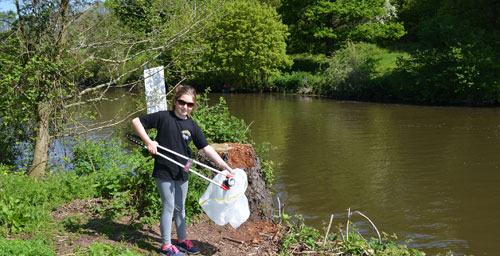
Our youngest street volunteer, Lily, helping during the river clean last June
October litter-pick
The next Saltford Wombles' litter-pick will be on Saturday 8th October (meet 9.30am at The Little Coffee Shop, Manor Road). If you haven't taken part in a litter-pick before, why not come along and see how satisfying it is to clear the litter that spoils our village?
Information about Saltford Wombles is on our "Less Waste" page. If you want to get involved contact Julie Sampson by email to: juliebsampson@gmail.com or tel: 01225--874603 or 07807--671--267.
Return to top of page
Saltford Heritage Centre: Have your say!

St Mary's Church Hall (2016)
Help us to create the Saltford Heritage Centre you want
On 22nd September after several meetings with SEG the Parochial Church Council agreed in principle for the Heritage Centre to be located within St. Mary's Church Hall. The development and planning for the centre is in its early stages. As such we are keen to hear the views of the Saltford community regarding what they would like to see from this volunteer run community resource.
We would appreciate it if you would take the time to complete the short online survey at https://www.surveymonkey.co.uk/r/RWPN5JQ (it will take approx. 2 minutes) to help us steer and develop the project. We want to ensure that what is delivered is relevant and accessible. Thank you for your time!
The purpose of a new Saltford Heritage Centre will be to undertake the stewardship of Saltford's history by actively collecting, preserving and interpreting documents and artefacts, and by promoting our heritage. It will provide a useful educational resource and occasionally host history events organised by third parties. It will also incorporate a pop-up-heritage display to take to local events.
Heritage Centre web page
We now have a dedicated web page within SEG's online History Project for the proposed Saltford Heritage Centre where we will post updates as we develop our plans.
To see the new page click here: Heritage Centre.
Return to top of page
The human response to climate change

The human response to climate change is an interesting aspect of psychology that has exercised the minds of many working in the field of climate science.
A blog from Scientific American by Margaret Hetherman suggests society could be working through the recognised stages of grief - denial, anger, bargaining, depression, and then acceptance. Here we have reproduced some of the key points in the blog.
The deterioration of our planet - our only home - is bound to produce a wide range of emotions in different individuals. Mourning is personal, but as a species, could it be that we are making our way through the stages of grief?
Psychiatrist and climate activist Dr Lise Van Susteren points out that the stages of grief was a response to people who hear devastating news and feel personally very involved, extremely vulnerable and know that the diagnosis is essentially inescapable.
However she maintains that this is not where most people are with climate. "It takes a long time for some people to lay down the sense within that something is true." She describes "a collective anxiety that is insidious, even if we haven't managed to connect all the dots." Society is divided between those who focus on immediate needs, including jobs and reliable energy sources, and those concerned about sustainability for future generations.
"There isn't the slightest shred of doubt in my mind, that everyone on some level is anxious, deeply anxious, about climate change," the forensic psychiatrist says. She attributes her belief to decades of experience with people who have difficulty knowing what they are feeling on a deeper level, and she understands that anxiety comes from many headwaters.
Dr James E Hansen, climatologist and former Director of NASA's Goddard Institute for Space Studies in Manhattan considers timescale. "The problem is that the inertia of the system is not our friend, it has caused the effects to appear only slowly. That has been the fundamental difficulty. It looks like something in the far future."
That, he says, was the point in writing his book, Storms of my Grandchildren. It also inspires his participation as guardian for future generations in a current landmark federal climate change lawsuit against the US government for failing to protect children's constitutional rights to life, liberty, and property - a case that Dr. Van Susteren has collaborated on as well.
"These children are going to be around late in this century, so even though the large effects are not so soon, we can now see that they are going to occur if we don't rapidly phase down emissions," states Dr Hansen. "And I think some of them - mainly the sea level issue - is [coming] sooner than has been assumed by many."
Dr Hansen believes people are moving in the direction of accepting that climate is changing and that humans are at least a factor if not the dominant factor.
But there is also the matter of our wiring. "Denial is something that allows us sometimes to get through the day," says Dr Van Susteren. "And in some cases that's really good, that's adaptive, but in other cases it's going to kill you... and this one's going to kill you."
The full blog can be read here: blogs.scientificamerican...climate-change/
Return to top of page
Make your home warm and efficient for winter
Wasting energy costs the earth
With the arrival of autumn and the prospect of colder days ahead it pays to make sure your home is as well insulated as it can be before the weather turns cold. The Energy at Home scheme from B&NES Council in association with the Centre for Sustainable Energy aims to help residents improve the energy performance of their homes. This is by providing
- free expert home energy advice;
- help with energy saving measures including: boilers and heating systems, different types of insulation, windows and doors, and renewable energy technologies; and
- access to loans or grants to help cover the costs of your installation.
You can contact the Energy at Home scheme by Freephone to 0800 038 5680 or visit www.energyathome.org.uk for details.
Return to top of page
Helping our dragonflies
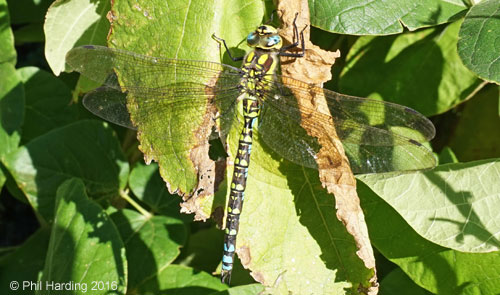
Southern Hawker Dragonfly in Saltford
Interesting fact:
Dragonflies cannot sting but they usefully eat other insects, such as midges and mosquitoes, which bite us!
We often see dragonflies visiting our gardens here in Saltford as in most parts of rural England. Pictured here is a male Southern Hawker (Aeshna cyanea) basking in the autumn afternoon sun on a runner bean leaf in Saltford. This is a very common and large dragonfly usually seen individually. The female of the species is brown with bright green markings in the same pattern as the male. The female's colour scheme is shared by the freshly emerged immature male.
The aerobatic skills displayed of these strong flying insects put almost all birds to shame (only some hummingbirds can match dragonflies' manoeuvrability). Dragonflies can fly at over 20mph and hover as they hunt, defend territories and chase mates on the wing.
Dragonflies are insects in the suborder Anisoptera (meaning "unequal-winged") and in the UK there are about 30 regularly recorded species (versus about 20 of the generally smaller damselflies of the suborder Zygoptera). Hind wings are usually shorter and broader than forewings. These creatures are usually large and can often be found flying well away from water. The eyes are very large and usually touch each other in the centre.
Dragonflies are predators, both in their aquatic larval stage (as nymphs) and as adults. Several years of their lives are spent as nymphs living in fresh water; the adults may be on the wing for just a few days or weeks, and only rarely for more than a few months.
Sadly some evidence suggests dragonfly numbers are declining due to loss of their wetland habitats. You can help stem this loss by creating your own dragonfly habitat simply by digging a garden pond. Dragonflies spend most of their lives underwater in their larval form. Therefore ponds and other water bodies (standing or flowing) are essential for these stunning insects to complete their life cycle. Most importantly, don't put any goldfish, carp or similar fish in the pond or densities of large water plants and small-animal (i.e. dragonfly prey) will be too low for many if any larvae to live through to adulthood.
It is believed dragonflies have been around for 300 million years but with many ponds having been filled in, dragonflies need our help. By digging a pond you will be replacing a habitat that has been lost, and - providing that no hoovering cyprinids are introduced - supporting a whole host of other, less dramatic, animals which have declined dramatically with pond loss.
Submerged plants provide habitats for the developing larvae and have wider environmental benefits, notably put oxygen into the water. Emerging and marginal vegetation provide perching, roosting and egg-laying sites for the adults and emergence sites for larvae. Many species lay eggs into floating plants.
Used in traditional medicine in Japan and China, and eaten in Indonesia, these wonderful creatures are often represented in human culture on artefacts such as pottery, rock paintings, and Art Nouveau jewellery. But they are also a valuable part of our ecosystem and deserve our protection.
Information sources for this article:
www.british-dragonflies.org.uk and en.wikipedia.org/wiki/ (2016)
Return to top of page
Focus on polystyrene and waste
Don't throw anything away.
There is no 'away'
A call to action in a public letter to London Mayor Sadiq Khan on ending the use of polystyrene came in August from top chefs Ed Baines (the founder of Soho seafood restaurant Randall & Aubin's), Hugh Fearnley-Whittingstall, Theo Randall, Mark Hix and food critic William Sitwell.
This comes amid global pressure to address the huge environmental and health problems linked to the use of polystyrene packaging. Packaging made from polystyrene never biodegrades, pollutes waterways, and is manufactured from harmful chemicals like styrene that have been linked to cancer.
When the material pollutes waterways and oceans, it is ingested by fish, hence this makes the issue a particular concern to chefs like Ed Baines and his seafood restaurant.
Polystyrene is extremely difficult and expensive to recycle, which means that millions of tonnes of the material end up in landfill sites every year.
Recyclable, paper-based alternatives to polystyrene such as solid board packaging have increasingly been adopted by chefs and suppliers throughout the UK and Europe seeking to improve their environmental performance, in anticipation of similar legislation to that seen in the US.
Sadiq Khan's mayoral election manifesto emphasised his commitment to reducing London's waste footprint, and outlined his promises to get the city on track to hit the target of 65% recycled waste by 2030. We are doing much better here in B&NES but there is no room to be complacent.
According to data from B&NES Council, in 2015-16, over 45,000 tonnes of Bath & North East Somerset residents waste was reused and recycled. All the material collected for reuse and recycling is sent for recycling within the UK where possible, however, due to demand or market availability, it is sometimes necessary to export some materials overseas. The percentage of materials exported for recycling and reuse for B&NES in 2015-16 was 0.50%.
In total B&NES exported just over 17% of the 45,000 tonnes diverted away from landfill. The majority of this exported waste has been removed from residents' weekly bin waste at a facility in Avonmouth. 24,350 tonnes of waste was sent to this facility in 2015-16, and after all the recyclable and compostable waste has been taken out, the rest is exported for use in energy recovery.
In 2005 B&NES Council agreed the Waste Strategy, Towards Zero Waste 2020. 'Zero waste' means that instead of throwing things away in the bin, where they get sent to landfill, we look to reduce, reuse, repair, recycle and compost what we use so that ultimately we do not end up throwing anything away in the bin.
The B&NES total recycling and recovery rate in both 2014/15 and 2015/16 was 81%. This is a marked improvement on 2012/13 when it was 57% but the challenge to us all is to reduce the amount of waste we each create in the first place.
What we call 'economic growth' is in fact a growth in waste and a decline in the health of natural habitat
Satish Kumar
Information sources for this article:
www.mygreenpod.com and www.bathnes.gov.uk (2016)
Return to top of page
September 2016
Discovering Roman Saltford - next stage in the hunt for the Roman dwelling
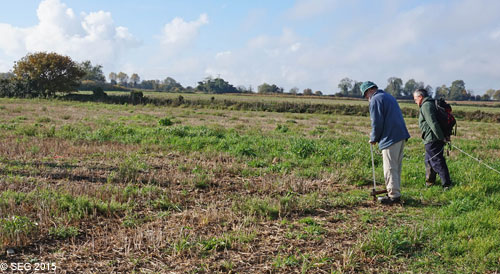
A twin probe resistance meter in use during the
geophysics survey in Saltford, 28 October 2015.
Many members will recall the successful geophysics survey of the Roman coffin field in Saltford by Bath and Camerton Archaeological Society (BACAS) supported by volunteers from SEG in autumn 2015 and the discovery of the apparent corner of a building in our search for the Roman farmhouse of villa. We are now preparing to continue the geophysics survey on the south side of Saltford possibly this October and will need the assistance of volunteers from our membership to help mark the grid lines for the survey equipment.
The search has reached an exciting stage as we are hopeful that on this forthcoming survey we can identify the full extent of the dwelling. We will need to undertake the survey at just a few days' notice as we need to fit in with the harvesting of the crop in the field, the weather and the availability of BACAS geophysics equipment and operator(s). We therefore need to expand our team of 14 able-bodied survey volunteers to ensure we have enough people to help.
If you would like to go on the list and be a potential part of this exciting project please contact our Chairman, Phil Harding. When we are ready to survey an email will be sent to our volunteers list at short notice asking for availability on the few days we expect to undertake the survey during daylight hours.
For further information about Roman Saltford and last year's geophysics survey visit our Online Museum from this link: Online Museum. You will be able to see many fascinating Roman artefacts found in Saltford including a rare Roman gilded brooch complete with black gemstone found near the location where we are searching for the dwelling. Many remarkable Roman artefacts have been added in recent months and much is ear-marked for the new Heritage Centre.
Return to top of page
The emerging plans for Saltford Heritage Centre
Safeguarding Our Past, Guiding Our Future

St Mary's Church Hall (2016)
With the huge success of SEG's history project it is important to have a location for displaying some of Saltford's historic artefacts and to create a learning and educational resource.
The purpose of a new Saltford Heritage Centre will be to undertake the stewardship of Saltford's history by actively collecting, preserving and interpreting documents and artefacts, and by promoting this heritage, for the purpose of learning and providing an educational resource, community building and understanding. It will also incorporate a pop-up-heritage display to take to local events.
Discussions are well underway between SEG and St Mary's Church PCC on a possible joint collaboration to create a new Saltford Heritage Centre within the church hall on the first floor. This would be part of a refresh and update of the facilities at the hall in Queen Square.
With its location at the centre of Saltford's Conservation Area, close proximity to Saltford's oldest built structure (the Anglo Saxon tower of St Mary's church, about 1,000 years old) and St Mary's desire to increase its involvement within the wider community, this has the potential to provide Saltford with a useful showcase of its fascinating heritage.
SEG has recruited from our membership Lottie Smith-Collins MA (Heritage Management) AMA, to assist SEG's Chairman Phil Harding and heritage centre project manager Odette McCarthy to design, plan and deliver the new heritage centre. During August a detailed proposal was submitted to St Mary's Parochial Church Council (PCC) Standing Committee.
The project has endorsements from Saltford Church of England Primary School, Keynsham and Saltford Local History Society and Friends of Saltford Library.
This is all very much at an early stage and we await the PCC's September meeting when the PCC will make a decision on whether or not to proceed. If you want to know more or wish to provide your own ideas do speak to SEG's Chairman, Phil Harding, or to the Rector, Rev. Daile Wilshire.
Return to top of page
Reducing Saltford's litter

Saltford School pupils setting a great example earlier this year
According to Keep Britain Tidy, 62% of people in England drop litter, although only 28% admit to it. Let's buck the trend here in Saltford and by keeping litter clear from the pavements surrounding our homes encouarage each other to keep Saltford tidy.
Saltford Wombles are at the forefront for helping to keep Saltford tidy. They are holding their first autumn litter-pick on Saturday 10th September (meet 9.30am at The Little Coffee Shop, Manor Road). If you haven't taken part in a litter-pick before, why not come along and see how satisfying it is to clear the litter that spoils our village?
Information about Saltford Wombles is on our "Less Waste" page. If you want to get involved contact Julie Sampson by email to: juliebsampson@gmail.com or tel: 01225--874603 or 07807--671--267.
Return to top of page
Saltford calendar 2017 is coming soon
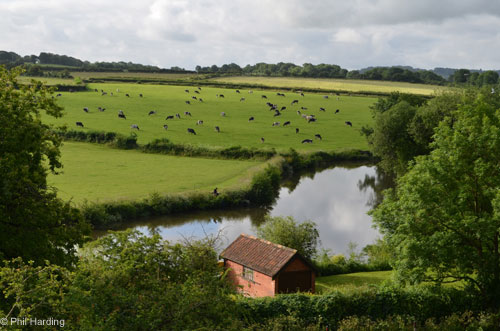
As announced previously in our July newsletter SEG and Saltford Community Association are working together to produce a Saltford calendar each year. Plans for the 2017 calendar are now well advanced and we hope to have this available for sale (from SCA) in October - it will make a great Christmas present and also a keepsake showcasing what makes Saltford such a beautiful place to live.
If you have a great photo of Saltford and haven't submitted it yet there are just a few days left to send it to SEG's Chairman Phil Harding.
The photograph needs to be landscape shape (i.e. the same proportions as a 6" x 4" photograph) and high resolution, preferably at least 300 dpi - unfortunately most smartphones or bridge cameras cannot produce the required picture quality for printing to a high standard of definition. Photographs of lower resolution might still be useable for SEG's website as these are compressed to a lower resolution to enable rapid download time so if in doubt send it in.
Great shots taken in all seasons (this year or in past years) of interesting views, attractive buildings and local landscapes are what we seek. All photographs published on SEG's or SCA's website or the Saltford calendar will name the photographer (unless the photographer wishes to remain anonymous) and the copyright will rest with SEG and/or SCA.
So, get taking those photographs in and around Saltford and build up your own portfolio. If your son or daughter is interested in photographic art or likes photographing the local landscape, wildlife and interesting buildings, do encourage them to get involved. We may even be able to hire out at modest cost (to benefit SEG's funds) a Nikon Digital SLR if your son or daughter is interested in getting started in photographic art and supporting the annual calendar - contact Phil for details.
You're never too young or too old to be a published photographer!
Return to top of page
Brass Mill open for national heritage weekend (10/11 Sept)
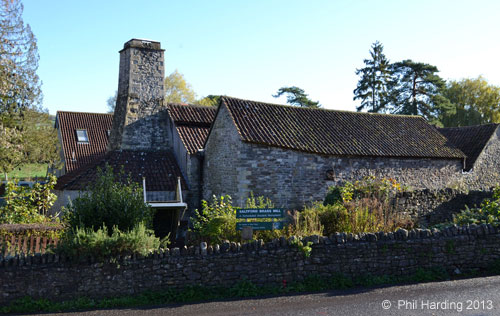
Saltford Brass Mill will be open for the National Heritage Open Days on the weekend of 10/11 September from 10am to 4pm. The Brass Mill is the only surviving building, still with a furnace and working water wheel, remaining from a group of 18th Century mills making copper and brass goods in the Avon Valley between Bristol and Bath.
If you haven't visited the Brass Mill in the Shallows before or recently, this is highly recommended. The Brass Mill is a fascinating part of Saltford's heritage and the volunteer project team who maintain and look after it do a magnificent job. Much time and money has been spent on the mill in recent years to repair and restore it after flood damage.
SEG will have a stand at the mill for the heritage weekend describing our history project and what SEG is doing for the community.
Return to top of page
Protecting Saltford's Green Belt: Joint Spatial Plan update

Councillor Adrian Betts, Saltford Parish Council's Planning Committee Chairman, Councillor Phil Harding, Saltford Parish Council's Vice Chairman (and SEG's Chairman), and Councillor Francine Haeberling, Saltford Ward Councillor (Cons) met with Liz Richardson, B&NES Cabinet Member for Homes & Planning, and senior B&NES Council planning officers on 19th August. This was to receive and discuss an update from B&NES on progress for the West of England Joint Spatial Plan.
The key news from that meeting as it affects Saltford is as follows:-
HOUSING MARKET AREA (HMA)
In summary Saltford is not now being placed in Bristol's HMA but in the HMA for B&NES. This is an important factor for preventing Bristol's housing needs from dictating the level of housing development in Saltford when on sustainable development grounds new housing should be closer to places of employment to minimise commuter travel and road congestion.
The Parish Council has lobbied strongly for ensuring Saltford is part of the B&NES HMA, not in the Bristol HMA, as backed up by 2011 census travel to work data. The data and underlying case was explained again by Adrian and Phil at the meeting and whilst relieved to hear of the change, Phil and Adrian will not feel confident about this until it is put in writing by B&NES.
TIMING FOR JOINT SPATIAL PLAN
Work on producing the Joint Spatial Plan is also behind its original timetable although the consultation process will be revised to allow the original public examination timing (summer - winter 2017) and adoption (early 2018) will remain. The draft plan, originally scheduled to go public in June (2016) will now be a pre-submission plan that undergoes six weeks of consultation with Parish Councils etc. commencing this autumn.
SALTFORD'S GREEN BELT
B&NES Council Leader, Councillor Tim Warren, assured Phil Harding at an informal meeting in early August that development on Saltford's Green Belt was not being proposed for the draft JSP. The 19 August meeting also confirmed this; Phil Harding and Adrian Betts stressed the importance of this being the case as any mention of our Green Belt as having the potential for future development would give rise to speculative planning applications from developers if there are delays in agreeing the JSP (as happened with the fields south of Manor Road that led to an Inquiry in 2013 that the village won after a 2 year campaign).
NEXT STEPS
Further meetings between B&NES and Saltford Parish Council representatives will be held during the autumn, especially as the pre-submission plan is being drafted; SEG will keep members updated.
(i) Background and (ii) Policy paper submission by SEG
Background
The West of England's Joint Spatial Plan and Transport Study (www.jointplanningwofe.org.uk) will
"set out a prospectus for sustainable growth that will help the area (Bristol, North Somerset, South Gloucestershire and Bath & North East Somerset) meet its housing and transport needs for the next 20 years."
Estimates state that the area needs at least 85,000 new homes by 2036, that is 29,000 more than the number already planned in Core Strategies, as well as the transport and other infrastructure needed to support that level of growth.
In B&NES, the B&NES Core Strategy (2014-2029) that was agreed in July 2014 after lengthy negotiations and public consultation is undergoing an early review in tandem with the Joint Spatial Plan (JSP). Once agreed the JSP (2016-2036) will in effect override the B&NES Core Strategy for determining the location and size of new housing developments in B&NES until 2036. The B&NES Core Strategy is being reviewed simultaneously so that its timespan will be extended to match that of the JSP.
Policy paper submission by SEG
On 27 January 2016 SEG submitted a policy paper 'Very special circumstances and the Green Belt' to the West of England Partnership as its response to the consultation for 'Issues and Options' in the West of England JSP. The Green Belt is a much valued designation the protection of which is increasingly vital. The paper covers these topics:-
- Population growth, food security and protecting our 'natural capital'
- Where do we put new housing?
- Green Belt planning policy
- Democracy and political considerations in B&NES and Saltford
- Sustainable development
You can download SEG's paper from our Green Belt page or here:
'Very special circumstances and the Green Belt' (pdf)
Return to top of page
Concrete: friend or foe?
We can constantly make new things but we can't make a new world - Kentaro Matsuura
Concrete is the most widely used material in the world after water. With 4.6 billion tonnes produced annually (2015 data) or over 1/2 tonne produced per person living on the planet per year, the world is slowly becoming covered in it.
Concrete is a versatile construction material that can be formed into any shape. It has strength and durability and is a composite material made from cement, aggregate (both coarse and fine), water and invariably an admixture - an admixture is one of several chemicals used to modify the properties of hardened concrete that helps ensures the quality of concrete during mixing, transporting, placing, and curing that can also reduce its cost.
Its basic ingredients date back to the ancient Egyptians, and the earliest large-scale users of concrete technology were the Romans, with concrete being widely used in the Roman Empire. The Colosseum in Rome, for example, was built largely of concrete, and the concrete dome of the Pantheon that stands in the business district of Rome and was built 18 Centuries ago, is the world's largest unreinforced concrete dome.
After the Roman Empire collapsed, use of concrete became rare until the technology was redeveloped in the mid-18th century. Today, concrete is the most widely used man-made material (measured by tonnage) and large concrete structures such as dams and multi-storey car parks are usually made with reinforced concrete (where steel bars are embedded to provide tensile strength).
But concrete manufacture is very energy intensive and accounts for around 5% of global anthropogenic (manmade) emissions of carbon dioxide and affects a wide range of sustainability issues, including climate change, emissions to air and water, natural resource depletion and worker health and safety (e.g. dermatitis, alkaline skin burns and lung disease from dust inhalation).
For those reasons emphasis worldwide has been increasingly placed on recycling. Rather than sending concrete debris to landfill, recycling of the recovered concrete from demolition sites is increasing due to improved environmental awareness, governmental laws and economic benefits. Recycled concrete can be made into blocks or it can be crushed and reused as aggregate.
Whereas wood is regarded as the most naturally renewable mainstream building material, concrete may never be seen as a green building material. However with more care and attention by its manufacturers, users, and re-users its ecological footprint can be reduced.
Information sources used for this article:
www.concrete.org.uk, en.wikipedia.org/wiki/, Chemistry World, CEMBUREAU
NOTE: SEG members wishing to research and write short, informative, evidence-based articles on topical environmental/sustainability issues for our website and newsletters are invited to contact our Chairman and website editor, Phil Harding.
Return to top of page
Upcycling in September (12th)
The next meeting of the Saltford UPCYCLING Craft Group will be held earlier in the month than usual on MONDAY 12th September, 7-9pm at Signs of Saltford (works entrance), 559 Bath Road, Saltford.
It may only be September but we are thinking about Christmas already. Jewellery always makes a lovely present or a treat for yourself and creating your own unique designs will make it all the more special. Instead of putting pretty paper bags, wrapping paper or colourful magazines out for recycling you can use it to design and make your own jewellery.
Come along on the 12th and learn how, Frances and Tina look forward to meeting you. We have everything you need but do save any paper that takes your fancy. If you would like to know more about our free, friendly group do give Frances a ring on 07789--528834, everyone welcome.
Return to top of page
British Food Fortnight, 17th Sept to 2nd Oct

Now in its 14th year, British Food Fortnight is the biggest annual national celebration of British food and drink, with communities across the country flying the flag for home grown. Taking place from 17th September to 2nd October, B&NES Council is championing our own fresh and fabulous local produce by co-ordinating a lively programme of celebrations and activities throughout the area and launching an online Local Food Directory.
To find more updates about what events are going on in our area for British Food Fortnight, such as the 'Great Bath Feast' visit the B&NES Council webpage.
Return to top of page
Saltford Santa Dash, 4th December
The fourth Saltford Santa Dash will be held on Sunday 4th December starting at Saltford Sports Club. There will be 2 separate runs, a 1 mile dash for under 12s starting at 10am and at 11am the 5 mile dash on roads around Saltford and into Keynsham and back.
The Saltford Santa Dash has raised several thousands of pounds for good causes since it started in 2013. Registration for participants from 1 September and details at www.saltfordsantadash.webs.com.
Return to top of page
Bath Big Clothes Swap, 14th September
Bring your friends and swap not shop!
On average 30% of clothes in our wardrobes haven't been worn in the last year. The Bath Big Clothes Swap will be held on Wednesday 14 September 2016, 6.30-9pm at The Guildhall, High Street, Bath BA1 5AH. You can bring any adult clothes, shoes and accessories that you no longer want that are nice enough to pass on to a friend. Tickets on sale at £5 (includes welcome drink) from B&NES Council Connect 01225 39 40 41 or pop in to one of their One Stop Shops.
The event will include the "Love your clothes road show" with tips and advice on how to:
- make your clothes last longer
- reduce the environmental impact of laundering your clothes
- recycle and pass on your unwanted clothes
- make the most of your wardrobe
Find out more at www.bathnes.gov.uk/textiles.
Return to top of page
Globally 2015 was the warmest year on record as upward trend continues
The National Oceanic and Atmospheric Administration (NOAA) of the US Government in its "State of the Climate" report for 2015 outlines the many climate records broken during the year, with records still tumbling through the first half of 2016.
It is looks increasingly likely that the aim of the Paris Agreement, of keeping global warming to below 1.5 degrees, signed in December 2015 by 195 countries, will be unachievable. 2015 saw the toppling of several symbolic mileposts: notably, it was 1.0 deg C warmer than preindustrial times, and the Mauna Loa observatory in Hawaii recorded its first annual mean carbon dioxide concentration greater than 400 parts per million (ppm). A continuing trend in raised ocean temperatures has also been observed.
For those interested in the technical details and data, the "State of the Climate in 2015" report can be found on the American Meteorology Society website from this external link >>.
Return to top of page
Station Campaign questions B&NES Council's commitment to station
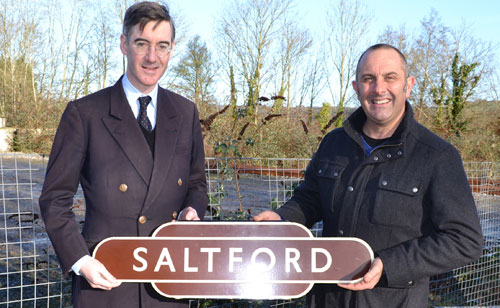
Jacob Rees-Mogg MP with Chris Warren at Saltford station site in January 2015.
In an article in the 4th of August edition of local newspaper The Week In Saltford Station Campaign leader Chris Warren says he has been overwhelmed at the support from the majority of the community in Saltford to the campaign to reopen Saltford station but raises his concern that support has not been forthcoming in action, rather than words, from B&NES Council. Of particular concern is the omission of Saltford from the MetroWest timetable studies.
The campaign will be stepping up its efforts to encourage B&NES Council to match the support given to re-opening the station by our local MP Jacob Rees-Mogg. Two representatives met with B&NES Council Leader Tim Warren on 10th August where an assurance was given that B&NES Council would pursue investigations for timetable space for a half-hourly stop at Saltford in the context of the new MetroWest service.
The article can be found on page 20 of The Week In (issue no. 434, 4.8.2016) from this link: The Week In, Issue 434 (pdf on external site).
Return to top of page
August 2016:
Rabbit coursing, bull-baiting, bare-knuckle fighting - Saltford in the 19th Century!
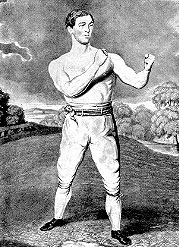
Example of a 19th C prize fighter
During July some fascinating 19th Century stories have been researched and published in SEG's Online Museum that shed light on a society that many of today's older generations would not recognise. The early 1800s were cruel and dangerous times but by the end of Queen Victoria's reign life had changed beyond recognition. Examples of new 19th Century items published that you can now read include:-
- 1821: Bare-knuckle fighter absconds with spectators' money - read how a large expectant audience in Saltford had to move to Bitton to watch a bare-knuckle fight due to the "vigilance of the magistracy" but then one of the fighters nipped off with their stake money and they roughed up the other as he tried to make his get-away; the day concluded with a bull-bait and "many pockets were picked".
- 1836: Brunel in Saltford - when Brunel rode through Saltford in 1836 he was determined not to pay a high price for Saltford House that was standing in the way of his plans for the Great Western railway, so without being recognised he carefully negotiated a better price for the house next door.
- 1863: Concerns over wife beating - new resident Captain Francis Haviland writes a letter to The Bristol Mercury giving his views on wife beating that "it may be read by those unruly members of society who degrade human nature by ill-using Women." On his death in 1880, Francis Haviland, by then a much admired and respected Major, received full military honours at his Saltford funeral - we have published full details.
- 1865: Serious railway accident between Saltford and Keynsham - the account of this train crash graphically describes the terror and panic of passengers as they hear the sound of the oncoming mail train from London Paddington that will smash into their stationery train.
- 1890: Rabbit coursing at Saltford mentioned in the House of Commons - the journalist in writing the account and making his argument in favour of fox hunting also hopes "that no sentimental reader will blaze out into passionate indignation, or rave about the low state of civilisation at Saltford."
You can visit our Online Museum 19th Century page and scroll down the page to find these and many other interesting articles from this link: Online Museum - 19th C.
Return to top of page
The big butterfly count (15 July to 7 August)
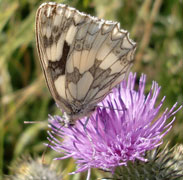 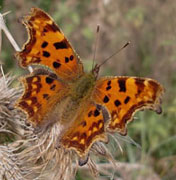 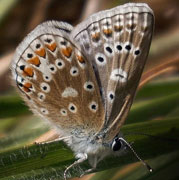
Marbled White, Comma and Common Blue. © Elizabeth Cooksey
The big butterfly count is a nationwide survey aimed at helping us assess the health of our environment. It was launched in 2010 and has rapidly become the world's biggest survey of butterflies. Over 52,000 people took part in 2015, counting over 580,000 individual butterflies and day-flying moths across the UK.
This year's big butterfly count is from 15 July to 7 August and could be something to also get younger members of the family engaged in over the summer holidays. Details at www.bigbutterflycount.org.
Return to top of page
Protecting Saltford's Green Belt: Joint Spatial Plan update

The Draft Joint Spatial Plan was due to be considered by B&NES Council's Planning, Housing and Communities Board (PHCB) on 29th July but this has been delayed until September when it will also go out for public consultation. SEG and the Parish Council are jointly monitoring this closely as we are anxious to ensure Saltford's Green Belt is kept out of the JSP.
Background
The West of England's Joint Spatial Plan and Transport Study (www.jointplanningwofe.org.uk) will
"set out a prospectus for sustainable growth that will help the area (Bristol, North Somerset, South Gloucestershire and Bath & North East Somerset) meet its housing and transport needs for the next 20 years."
Estimates state that the area needs at least 85,000 new homes by 2036, that is 29,000 more than the number already planned in Core Strategies, as well as the transport and other infrastructure needed to support that level of growth.
In B&NES, the B&NES Core Strategy (2014-2029) that was agreed in July 2014 after lengthy negotiations and public consultation is undergoing an early review in tandem with the Joint Spatial Plan (JSP). Once agreed the JSP (2016-2036) will in effect override the B&NES Core Strategy for determining the location and size of new housing developments in B&NES until 2036.
Return to top of page
Businesses can bridge UK electricity capacity gap by 2020 says new report
Manufacturing sites, hospitals and retail stores could provide the equivalent electricity supply of 6 new power stations and address the UK's electricity capacity concerns, says a new report from the Association for Decentralised Energy (ADE) during July.
The new report says that up to 16% of the UK's peak electricity requirement, or 9.8 gigawatts, could be provided by businesses through flexing their electricity demand and making better use of onsite generation.
One part of the solution is to engage energy users to manage their energy use and onsite generation to help the electricity system in return for payments, known as demand side response. By turning down demand instead of increasing supply, and by employing more local, efficient generation, demand-side response reduces emissions and helps the UK meet its carbon targets.
This potential for demand-side response would represent a nearly 10-fold increase and shows the scale of support that business energy customers could provide to help fill the gap in keeping the nation's electricity supply and demand in balance.
As old power stations shut down and new renewable generation like wind and solar are not always available (until better electricity storage technologies are developed) the ability for the nation's electricity supply industry to keep the lights on by 2020 is a cause for concern, but the report shows there are solutions.
The full from ADE report can be downloaded here: Bringing Energy Together - ADE report (external link to pdf, opens in new window)
Return to top of page
New Giant Hogweed warning for Saltford's gardeners
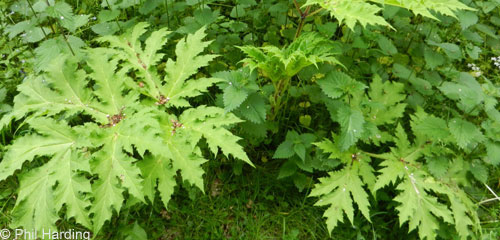
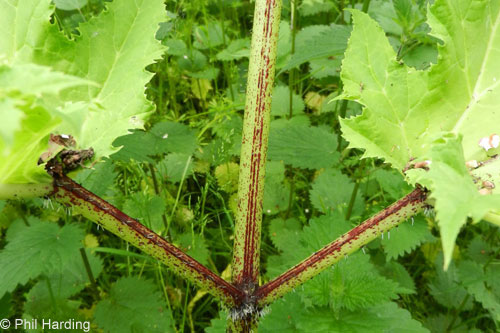
A resident recently discovered three massive Giant Hogweed plants growing in her garden after using locally sourced mulch that contained the plant's seeds. This highly toxic non-native plant has to be treated with care and removed by specialists.
As we have warned in previous news items, contact with its sap or its bristles can cause severe skin burns depending on individual sensitivity. It can sensitize skin to ultra-violet light (sunlight), leading to severe blisters, pigmentation and long-lasting scars; hospitalisation may be necessary. Affected skin may remain sensitive for several years. A minute amount of sap in the eye can lead to temporary or even permanent blindness.
If you find Giant Hogweed growing in Saltford, please advise both the Parish Council and B&NES Council (Council Connect on 01225 39 40 41) as soon as possible - and let SEG know too. For your own safety DO NOT TOUCH or attempt to remove it yourself. When removed, under the Environmental Protection Act (1990) Giant Hogweed is classified as controlled waste. Anyone working amongst Giant Hogweed should wear protective clothing that covers the whole body including gloves, hood and face visor.
More on Giant Hogweed can be found on our wildlife page.
Return to top of page
A Saltford Heritage Centre?
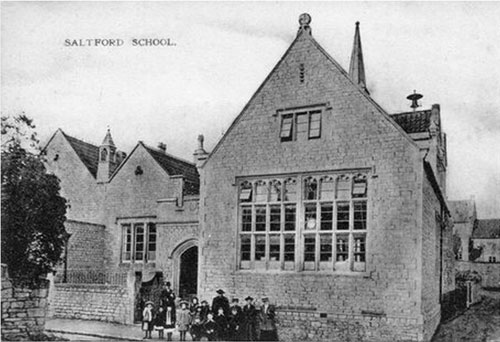

The Church Hall, then Queen's School, in early 1900s (top)
and St Mary's Church Hall as it is today, 2016 (bottom)
Members may recall that when our history project reached its first anniversary in March we said that we were investigating the options for displaying some of Saltford's historic artefacts either in Saltford, our first choice, or elsewhere.
Discussions are underway between SEG and St Mary's Church PCC on a possible joint collaboration to create a new Saltford Heritage Centre within the church hall on the first floor. This would be part of a refresh and update of the facilities at the hall in Queen Square.
With its location at the centre of Saltford's Conservation Area, close proximity to Saltford's oldest built structure (the Anglo Saxon tower of St Mary's church, about 1,000 years old) and St Mary's desire to increase its involvement within the wider community, this has the potential to provide Saltford with a useful showcase of its fascinating heritage.
Saltford Church of England Primary School has informed SEG itfully endorses the proposed Heritage Centre for Saltford. It sees the proposed centre as a valuable asset to the teaching of history at the school and would be used regularly by all staff and children. The school is already using SEG's History of Saltford project, which contains a wealth of information about the history of Saltford and thus enables "staff to have access to a huge range of quality resources including documents and
photographs to allow the children's study of local history to come alive."
This is all very much at an early stage. If you want to know more or wish to provide your own ideas do speak to SEG's Chairman, Phil Harding, or to the Rector, Rev. Daile Wilshire.
Return to top of page
Waitrose and its customers supports SEG
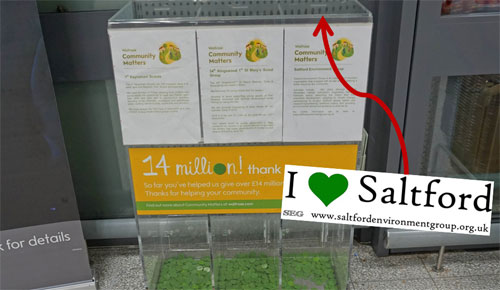
Many thanks from SEG's Executive Committee to everyone who donated their green token to SEG's 'Community Matters' box when shopping at Waitrose in Keynsham during May. Our grateful thanks are due to Waitrose too; on 6th July they handed over to our Chairman a cheque for £360 which is a very useful boost to our funds.
Return to top of page
SEG supports school fair with "Slow Cycle" challenge
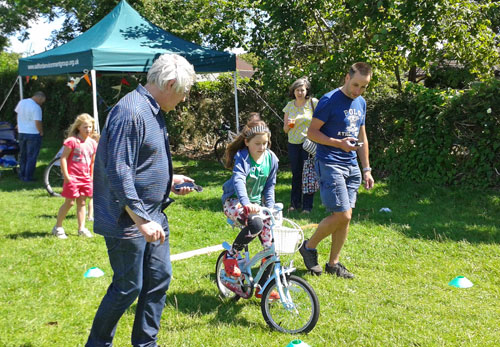
On Saturday 2nd July SEG supported this year's Saltford School PTA Summer Fair with a Slow Cycle challenge. Our Slow Cycle challenge is where you have to cycle a 25 metre stretch as slowly as possible without putting your feet down, so it's all about balance and control.
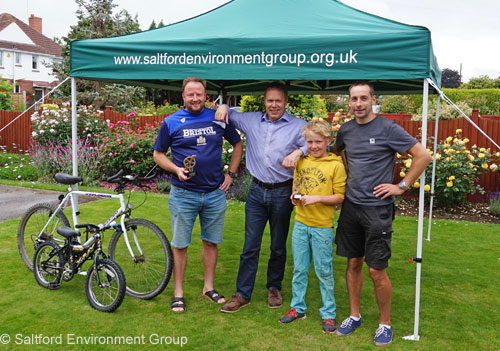
2016 Slow Cycle Challenge winners receive their trophies
from SEG Chairman Phil Harding and SEG's 'Slow
Cycle Challenge' organiser Paul Goddard
(L to R: Ben Scott, Phil Harding, Benny Hodgson, Paul Goddard)
Senior winner was Ben Scott with a remarkable time of 5 minutes and 5 seconds, and junior winner (11 and under) was Benny Hodgson with a time of 44 seconds. A special mention for Ava Gregory in the junior section who after 3 attempts managed a super time of 36 seconds and was the slowest girl.
Return to top of page
July 2016:
SEG to be at the school summer fair, 2nd July
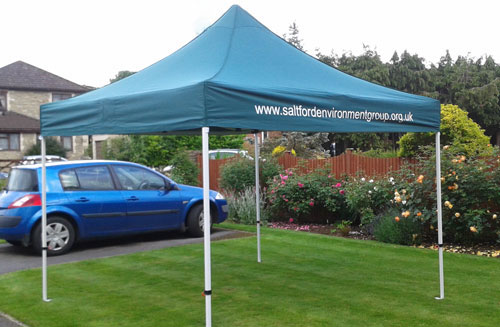
Come and find us under our smart new green gazebo at the school fair.
Saltford School's PTA Summer Fair will be held on Saturday 2nd July 2 pm - 5.30 pm. SEG will be there with our "Slow Cycle" challenge. If you're attending the fair look out for our gazebo and come and say hello (and find out what a "Slow Cycle" is).
Return to top of page
Protecting Saltford's Green Belt: Joint Spatial Plan update

The Draft Joint Spatial Plan is due to be considered by B&NES Council's Planning, Housing and Communities Board (PHCB) on Friday 29th July. We have been informed that it will therefore be publicly available around a week before that date. Following consideration by PHCB it is due to be considered by the Strategic Leaders Board on 2nd September and it is anticipated it will be published for public consultation during September/October.
Background
The West of England's Joint Spatial Plan and Transport Study (www.jointplanningwofe.org.uk) will
"set out a prospectus for sustainable growth that will help the area (Bristol, North Somerset, South Gloucestershire and Bath & North East Somerset) meet its housing and transport needs for the next 20 years."
Estimates state that the area needs at least 85,000 new homes by 2036, that is 29,000 more than the number already planned in Core Strategies, as well as the transport and other infrastructure needed to support that level of growth.
In B&NES, the B&NES Core Strategy (2014-2029) that was agreed in July 2014 after lengthy negotiations and public consultation is undergoing an early review in tandem with the Joint Spatial Plan (JSP). Once agreed the JSP (2016-2036) will in effect override the B&NES Core Strategy for determining the location and size of new housing developments in B&NES until 2036.
Return to top of page
SEG's history project reveals fascinating new insights into Saltford's past
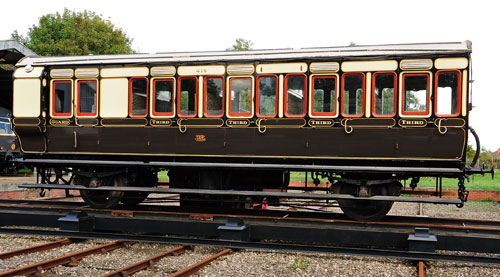
What happened on a coach just like this in 1891?
New material researched, discovered, transcribed and posted onto the history project web pages in June provide a fascinating series of glimpses of Saltford in the 18th, 19th and 20th Centuries. These include the following:-
(NOTE: after clicking on the links you will need to select the featured link on each page you arrive at)
18th Century
19th Century
- The Church Rambler: St Mary's in 1876.
This serious yet unintentionally amusing account of church life and Saltford village in 1876 is a real gem. You can download the account from the St Mary's Church page of the history project here:
St Mary's in 1876.
- 1891 "Adventures in a train"
On a winter's night in January 1891 a prisoner, Edward Skinner, was taken off the Bath to Bristol train at Saltford station and handed over to the Station Master Mr Murrow, the relief station inspector that evening. He escaped and was recaptured by two Saltford men, farmer John James Ollis and Isaac Shepherd. The account given in the Bristol Mercury of the court case that followed makes a great read, just like a mystery play, and is amusing at times. It also reveals a lot about the lifestyle in Bath and Saltford in the 1890s. You can download it from the Online Museum here:
Adventures in a train (1891).
20th Century
- Saltford School Pupils 1932.
A photograph of Headmistress Miss Hockey and her 66 pupils with the names of all but a few shown includes many familiar surnames and relatives of many residents living in Saltford today. If you and/or your family has been living in Saltford since the 1930s this is well worth a look and if you recognise any of the pupils which we have been unable to name, do contact us. The photograph is on the 20th Century page of the Online Museum - scroll down to see from this link:
Select "People" then scroll down to: Saltford School Pupils 1932.
- St Mary's Church magazine, 1975
This gives a fascinating insight into church and village life in the mid-1970s when Saltford was served by a butchers shop on the Bath Road, a food store as well as a fresh fruit and vegetable shop in the High Street, and the Post Office also sold toys, cigarettes, tobacco and confectionary. Rev Stephen Wells was our Rector and Audrey Guthrie was running the Young Wives group and the Sunday School. You can download the magazine from the St Mary's Church page of the history project or the Miscellaneous section of the Online Museum where you can also download the Saltford Cricket Club v Somerset CCC
Programme, 9th July 1995 here:
Online Museum: 20C - Miscellaneous.
Return to top of page
Saltford Upcycling Craft Group in the summer
The Saltford Upcycling Craft Group will be taking a summer break in July, but we will be back on August 18th (7-9pm). We are looking forward to catching up with everyone at our next meeting when we will be learning how to quill using old magazines. All you need is your creativity and enthusiasm, we have have all the equipment you will need. Join us at Signs of Saltford (works entrance) 559 Bath Road, Saltford.
Do ring Frances Eggbeer on 07789--528834 if you would like to find out more about us or come along on the night. Tina and Frances will be there to make you welcome.
Return to top of page
SCA and SEG to produce Saltford 2017 calendar - want to contribute your photographs?

SEG and Saltford Community Association (SCA) have agreed to produce the 2017 calendar of Saltford as a joint venture. SCA produced the 2016 calendar at last year's Saltford Festival; the new venture is to seek to produce a 2017 calendar celebrating what's great about Saltford whilst utilising the photographic skills of our residents, from the youngest to the oldest.
Net profits from the sale of the calendar will benefit SCA and SEG funds. If this proves successful we hope to make this a regular annual feature timed for the festival and/or for the Christmas season.
SEG uses a lot of photographs for its website and will make available suitable stock photographs for the calendar. Members of SEG who are handy with a digital camera and who wish to support this project should get in touch with our Chairman, Phil Harding, so that we can establish a Saltford photographer's list.
We shall be asking for contributions to the calendar in due course (photographs for the 2017 calendar required by the end of September) but if you have any now that you think would be suitable do send them to Phil.
Photographs need to be landscape in shape with the same proportions (ratio) of a 6" x 4" photograph (we can crop if necessary) for the calendar although we do also use portrait shape photographs for website use. They should be submitted as jpeg files and the resolution should be 300 pixels per inch or higher - if you're not sure, don't worry just send them in or contact Phil.
Great shots taken in all seasons (this year or in past years) of interesting views, attractive buildings and local landscapes are what we seek. All photographs published on SEG's or SCA's website or the Saltford calendar will name the photographer (unless the photographer wishes to remain anonymous) and the copyright will rest with SEG and/or SCA.
So, get taking those photographs in and around Saltford and build up your own portfolio. If your son or daughter is interested in photographic art or likes photographing the local landscape, wildlife and interesting buildings, do encourage them to get involved.
You're never too young or too old to be a published photographer!
Return to top of page
Tree beekeeping
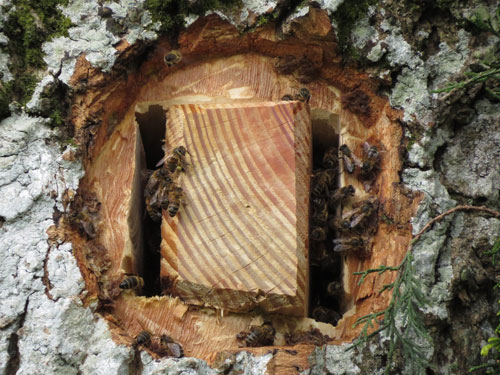
Tree beekeeping is an ancient form of beekeeping where Zeidler (Tree Beekeepers) create cavities inside living trees and then manage the hive for hundreds of years, passing it from one generation of Zeidler to the next.
Historically, the Zeidler never introduced a swarm to a hive, instead they would make the hive as attractive as possible for the bees, respecting their natural preference for warm cavities high in trees, away from interference and the cold of the ground. Many modern forests are too barren and devoid of places for bees to nest, forage or collect food.
A movement to restore the craft of the Zeidler is rapidly taking hold across Europe, but the task of the new Zeidler is to not only entice the bees to the many new tree hive cavities, but to also find habitats where the owners cherish the earth and foster its renewal. The Natural Beekeeping Trust recently created the first "Zeidler" tree hive at Pertwood Organic Farm in Wiltshire; you can see their short video about it at www.youtube.com/watch?v=vSpQm4Oj7Ns.
Return to top of page
Living without electricity
Do you and your family, including elderly vulnerable relatives, take the constant availability of electricity supplies for granted?
Extreme weather events arising from climate change can cut electricity supplies that have many consequences. Storm Desmond in December 2015 flooded a local substation, leaving 61,000 properties and over 100,000 people in Lancashire and Cumbria without electricity for over 24 hours. The resulting cascade of failures provided a rare insight into the many impacts of a major storm.
The loss of power quickly affected many other services that we all take for granted. Life had reverted to a pre-electronics era.
Most mobile phone coverage and text messaging was lost within an hour; this meant that Lancaster University, for example, had no way of communicating with its 7,000 students about what to do. Internet, television, and DAB radio were all knocked out. During the floods and the loss of the electricity supply, local radio was the best way of finding out what was going on.
The first challenge for many people was to find a battery or wind-up radio capable of receiving the FM band, as the local DAB radio transmitter was off-air. The second challenge was to find suitable batteries. The third was to decide which of the dozen or so FM channels available in Lancaster was most likely to include local news.
On a traditional radio, of the sort you find in the attic, there is no digital display of channel name and normally the only way to look up frequencies is to use the internet. It is perhaps ironic that, in a society with huge commitment to digital infrastructure, the most reliable source of news was a commercial station using technology that would have been familiar to the engineers on the 1960s Radio Caroline pirate radio ship.
Electronic tills and most ATM machines stopped working, which along with non-functioning freezers, meant that many shops could not do business. By 4pm, there were still many people wanting to buy groceries but, to comply with Sunday trading regulations, the supermarket closed.
Gas-fired central heating did not work because control systems and pumps need electricity. Homes with all-electric cooking were unable to heat food. High-rise buildings lost power for their lifts and upper floors lost water supplies. No traffic lights were working and garages could not sell fuel as pumps are driven by electricity.
The railway line was working as it is powered from outside the affected area but the station was closed at 4pm for safety reasons as there was no platform lighting. The local hospital, which has back-up diesel generators, was able to function as normal but vulnerable people in their homes and homeless people on the street were more seriously affected.
The situation was probably helped by the timing of the power cut (10.45pm on Saturday) and by the mild and sunny weather the following day that gave people time to plan what to do. Had it occurred during the working week, after parents had dropped off their children at school and gone to work, the situation would have been more stressful.
The failure of the power supply in Lancaster was an important reminder that things will occasionally go wrong and we need to regularly review our own contingency plans at home and at our place of work for such events. Perhaps something to contemplate over the summer before the autumn/winter months arrive...
Information source: Royal Academy of Engineering report "Living without electricity - One city's experience of coping with loss of power" (May 2016).
Return to top of page
June 2016:
Don't mess with Saltford's Admiral Kelly!
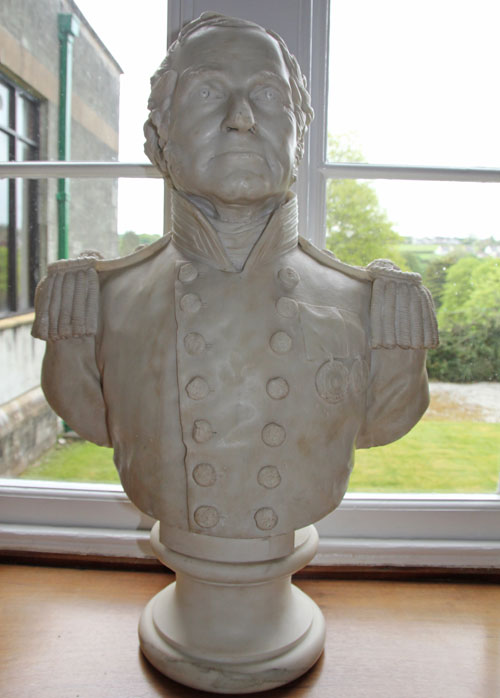
The bust of Admiral Benedictus Marwood Kelly (photographed at Mount Kelly)
During May our Chairman visited Mount Kelly (formerly Kelly College) in Tavistock to photograph the portrait of Admiral Benedictus Kelly hanging high up on the wall of the school library, at Kelly Church (Devon) to photograph Admiral Kelly's grave and commemorative window, and then called next door on Kelly House where he met the current (31st) Squire of Kelly House, Warin Kelly.
This was a highly productive fact-finding tour, revealing further fascinating information about Admiral Kelly. If you visit our history project page dedicated to Admiral Kelly you will find as you peruse the page:-
- an account of how he went ashore from HMS Pheasant at Dutch Accra (Ghana) in 1820, demanded the release of captive slaves and, when this was refused, returned to his ship which then proceeded to bombard the town. The bombardment continued for two hours until a message was sent agreeing that the slaves (totalling 50) would be handed over. This raises the known tally of slaves he rescued to over 350 and shows that he was not someone slave traders should mess with(!);
- a new and imposing photograph of Admiral Kelly, taken in the 1850s (our oldest photograph of a Saltford resident). The close resemblance to his portrait painted 20 years earlier in Florence is easy to see whilst his top hat is great to see and was doubtless worn around Saltford;
- photographs of his grave (the churchyard was so overgrown it was difficult to find - the grass was cleared away from the plaque for the photo!) and of the commemorative stained glass window he funded and that that was moved in 1900 from the front to the rear of the church;
- Kelly's links with Brunel as steam replaced sail for sea travel. As one of its first Directors Kelly helped establish the Royal Mail Steam Packet Company for transporting Her Majesty's mail. Brunel's SS Great Western built at Bristol in 1838 was the first ship to cross the Atlantic by steam power, directly led to the creation of the Royal Mail Steam Packet Company, and Brunel's SS Great Western was subsequently purchased by that company;
- an unexpected link (for art lovers) between Admiral Kelly and JMW Turner's famous and stunning 1838 painting of "The Fighting HMS Temeraire". HMS Temeraire fought magnificently in the 1805 Battle of Trafalgar and saved the stricken HMS Victory from certain destruction; our Admiral Kelly at age 19 served on HMS Temeraire as a Midshipman the year before. In 2005 Turner's evocative oil painting was voted the nation's
greatest painting in a poll organised by BBC Radio 4's Today programme. We have a photograph of the painting on Admiral Kelly's page; and
- an 1878 drawing of the hugely impressive Kelly College and its surroundings by the architect Chas F Hansom.
There are also other new aspects to Admiral Kelly's life published in his feature page during May. This continues to grow into a significant tribute to our humanitarian hero as we continue our research into his life as a philanthropist here in Saltford and his remarkable life before then.
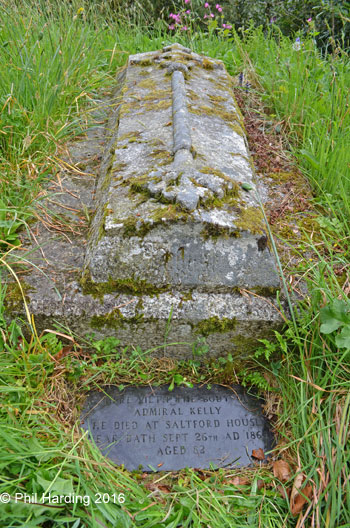
Admiral Kelly's grave,
Parish Church of St Mary, Kelly, Devon PL16 0HH.
You can visit Admiral Kelly's page in our History Project via this link: Admiral Kelly.
Return to top of page
Saltford playing field, Manor Rd, public info event, 8 June
As many will be aware, Saltford Primary School is planning to replace the temporary classroom buildings with a new permanent classroom block. The new classrooms will be built on a small area of the school field and will thereby reduce the recreational and sports provision currently enjoyed by the school.
To mitigate for this loss it is proposed by B&NES Council that the school will have exclusive access to an area of the adjoining public playing field during school time for sports and outside recreation. The area available to the school will be enclosed to prevent dog access and a formal football pitch set out.
This enhanced sports provision will be available to the community when not used by the school. In addition and in conjunction with the Council's Open Spaces team the field will be landscaped and provision made for picnics and informal play as well as improvements for dog walkers that use this popular area.
A schematic of the plan for the field will be available to view at the school on Wednesday 8th June at 6pm. Both school staff and Council officers will be available to answer any questions.
Return to top of page
Summer Wombling

Lily showing litter is not wanted in Saltford, especially by the river.
Saltford Wombles will be taking their customary break from organised litter-picks during the summer but SEG members wishing to sort out a litter problem near where they live or regularly walk can borrow litter pickers, gloves, high viz jackets and bin bags from Julie Sampson. You can contact Julie by
email to: juliebsampson@gmail.com or tel: 01225--874603 or 07807--671--267.
If you're wishing to encourage your children to take a more active pride in Saltford and do something for the local community, why not organise a family litter pick and see how much litter you can collect in an hour or two?
Return to top of page
Be a part of the Bristol Avon WaterBlitz
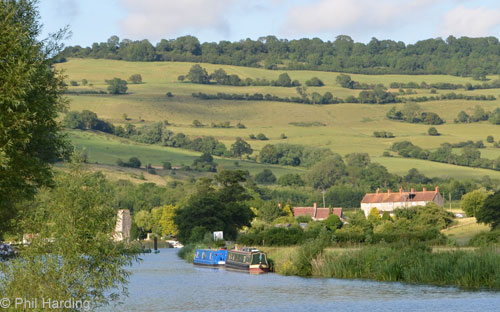
Whether you are a school, community group, business, organisation or member of the public, you can take part in the Bristol Avon WaterBlitz to help capture a snapshot of the condition of the water environment. The aim is to collect 500 water samples across the Bristol Avon Catchment.
Just visit www.wessexwater.co.uk/waterblitz to sign up and find out more. Once you have registered you will be contacted about receiving your free water testing kit.
Return to top of page
Thank you for your Waitrose tokens

Many thanks from SEG's Executive Committee to everyone who donated their green token to SEG's 'Community Matters' box when shopping at Waitrose in Keynsham during May. We won't know the outcome for a little while yet but SEG's box did really well competing against two from Keynsham so we are hopeful for a significant financial support grant from Waitrose.
The text on our token collection box in Waitrose was as follows:-
Saltford Environment Group is a voluntary organisation that engages with all age groups in seeking a better future for the community.
Defending the Green Belt from unsuitable development, Saltford Wombles litter picks, supporting Saltford's Fairtrade status, habitat restoration, campaigning to re-open Saltford railway station, researching and publishing Saltford's history, and providing environmental advice and guidance is what we do. Further information at www.saltfordenvironmentgroup.org.uk.
Return to top of page
Annual river clean held in May
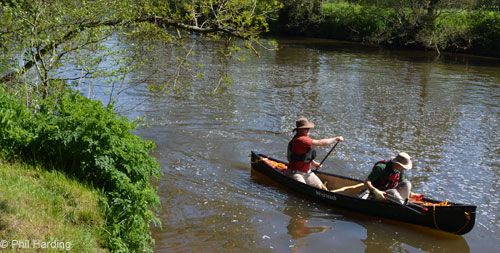
The annual 'river clean' gets underway in The Shallows
A big 'thank you' from SEG and our Wombles to the canoe and kayaking clubs including Canoe Avon, Avon Outdoor Activity Club and the Cheeky Friday Paddle Club who got together to clean our river on Sunday 15th May.
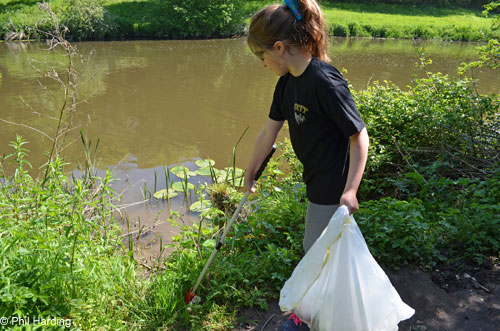
One of our young Wombles, Lily, helping to clear the riverbank during the river clean
The annual 'river clean' has now become an annual event and this activity to clear the litter and other debris that accumulates shows that many of our river users really do care about the environment here in Saltford.
Return to top of page
Bristol to Bath Festival of Nature coming to Saltford and Keynsham 18 & 19 June
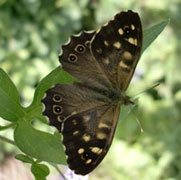 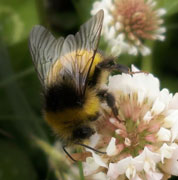 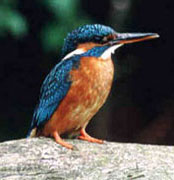
The Festival of Nature from 11th to 25th June is organised by the Bristol Natural History Consortium and will be the UK's largest free celebration of the natural world. It will be two weeks of free events along the river Avon for wildlife lovers of all ages.
The festival will include on Sat 18th and Sun 19th June a chance to have a guided tour of the Saltford Sewage Works and learn how waste water is treated so it can be safely released into the River Avon.
Keynsham Memorial Park is also playing host to the Festival of Nature on Sun 19th June (1-4pm) where you can visit nature themed stalls and activities in the Festival marquee, listen to 'Wind in the Willows' performances from the bandstand and join in with nature themed workshops around the park.
Further details about the festival can be found at www.bnhc.org.uk/festival-of-nature/.
Return to top of page
Calling Saltford's photographers
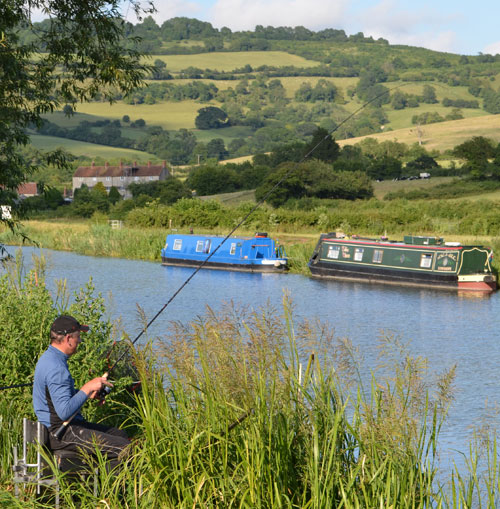
We're fishing for photographs...
Much of what SEG does is to promote what's great about Saltford and the natural environment here. We want members and others visiting our website to be inspired not just by what we as a community-based organisation do, but what makes Saltford such an amazing place to be.
So, if you're into photography, live in or visit Saltford, and would like to contribute spectacular or interesting photographs you have taken of Saltford and its surrounding countryside for us to use, contact our Chairman and website editor, Phil Harding.
We are particularly interested in young photographers to help and encourage them to develop their hobby.
Return to top of page
Saltford Upcycling Craft Group - June meeting
We are still making arrangements for June's Saltford Upcycling Craft Group meeting so please take a look at SEG's news page in a week or so to get confirmation of the date. It is possible we may have to change the date to the 3rd Friday (17th) when we will be continuing with the crochet theme and making flowers, a great way to use up odds and ends of wool.
If you would like to find out more about us you are welcome to phone Frances on 07789--528834 or come along on the day 7-9pm, Signs of Saltford, 559 Bath Road, (works entrance) and enjoy a free, friendly craft session. Frances and Tina look forward to seeing you.
Return to top of page
Saltford Evening Village Walk, Thurs 23 June
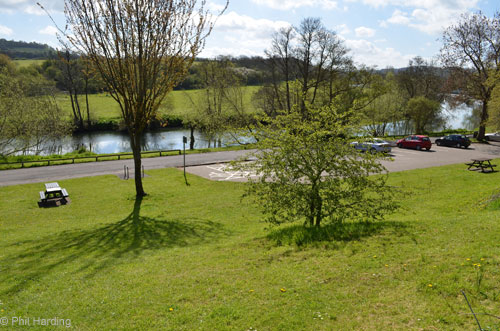
Starting point: The Shallows car park
The annual village walk on the beautiful footpaths around the village will take place on Thursday 23rd June starting at 7.00 pm from The Shallows car park. The walk will be led by Brian Cooper and will last approximately 2 - 3 hours.
Everyone is welcome, no need to book, but please wear suitable footwear, and put all dogs on leads.
Return to top of page
Tick advice
Whilst out and about enjoying Saltford's wildlife it is important to be aware of ticks, the bloodsucking, disease-carrying arachnids, that are on the rise in the UK due to milder winters. Residents and visitors to Saltford will need to be careful when walking in long grass or wooded areas where deer may have been present. Ticks may even appear in your garden as has already happened to one resident in Saltford this spring.
Tick bites can go unnoticed although with most people they itch within hours of the tick biting and the tick can remain feeding on your blood for several days before dropping off. The longer the tick is in place, the higher the risk of it passing on Lyme disease, a very dangerous bacterial infection that is spread to humans by infected ticks.
The advice from the NHS is that if you do find a tick on your or your child's skin, remove it by gently gripping it as close to the skin as possible, preferably using fine-toothed tweezers, and pull steadily away from the skin (don't twist or jerk the tick; this can cause the mouth-parts to break off and remain in the skin).
Never use a lit cigarette end, a match head or essential oils to force the tick out. It is important to be aware that using incorrect methods (twisting the tick, using chemicals or a lit cigarette) may cause the tick to spasm and vomit back into your skin and bloodstream, greatly increasing the risk of infection.
We provide further advice on this topic including the advice from the NHS on signs to look out for concerning Lyme Disease if you have been bitten by a tick on our wildlife page.
Return to top of page
Giant Hogweed warning


Giant Hogweed - early season prior to the production of flowers (top photo)
& (below) the bristles that can severely burn you if they puncture your skin
With the arrival of the spring growing season, the highly toxic and invasive alien Giant Hogweed is growing again in the same two areas of Saltford where it has appeared since at least 2014. This is where SEG has discovered and reported it for treatment each year - along the side of the railway cycle path towards Bitton and by the riverbank in The Shallows.
As we are discovering, it can take several years to finally eradicate the plant. The objective is to kill it each time it re-appears before it maims or blinds anyone who touches it and before it produces and spreads seed.
SEG has taken rapid action and had a site meeting with the Team Leader for Parks and Trees at B&NES (on 29th April) - the plant will be injected with an appropriate poison by B&NES staff wearing protective clothing.
We have pictures and information about this plant on our wildlife page including how to report its discovery. However, we wish to remind you that if you see it growing elsewhere in Saltford please also let SEG know (inform our Chairman) so that we can monitor it each year and, for your own safety, DO NOT TOUCH or attempt to remove it yourself.
When removed this plant is so dangerous that under the Environmental Protection Act (1990) it is classified as controlled waste. Anyone working amongst Giant Hogweed should wear protective clothing that covers the whole body including gloves, hood and face visor.
As before we do not publicly announce or highlight the precise location of this plant to avoid the risk of older children using it as a play weapon without realising that the sap from this plant can permanently blind or cause severe skin burns and scarring. If you have a need to know where it is, contact our Chairman by email and supply your telephone number.
Return to top of page
Saltford Parish Council elects new Chairman
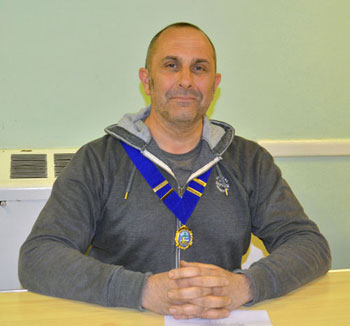
Chris Warren, Chairman of Saltford Parish Council for 2016/17
At its monthly meeting on 3rd May, the first anniversary meeting since the Parish Council took office after the Parish Council elections in May 2015, Councillor Chris Warren was unanimously elected to serve as Chairman of Saltford Parish Council for 2016/17.
Chris Warren, who many SEG members will know as leader of our Saltford station campaign, replaced Councillor Duncan Hounsell who had decided to stand down from holding the position. The Parish Council thanked Duncan Hounsell for all his work and guidance in steering the new Parish Council through its
first year. At the meeting Councillor Phil Harding was unanimously re-elected as Vice Chairman of the Council for a second year.
Return to top of page
British public says renewables offer huge economic benefits - and wants more

There are jobs, money and survival in renewable
energy. Our only safe future is sun power
Dave Hampton
New official Government statistics published by the Department of Energy and Climate Change (DECC) show that the British public believes that renewable energy provides tangible economic benefits - and they want clean energy projects built in their area.
The Public Attitudes Tracking from DECC shows that 70% of people see clear economic benefits to the UK from renewable energy. The survey also showed that 56% would be happy with a large-scale project in their local area.
Hugh McNeal, Chief Executive of renewable energy trade association RenewableUK, said: "It's great that the British public sees how renewable energy is helping to grow the UK economy. Renewables are delivering investment and jobs throughout our country".
These surveys of public attitudes are carried out annually (since 2012). Support for renewable energy has been consistently high since 2012 at around 75-80%. This pattern has continued in 2016 with 81% expressing support for the use of renewables with support lowest amongst those aged 65+ (74%).
Opposition to renewables was very low at 4%, with only 2% strongly opposed.
For 2016 an additional question was asked about people's opinion on three statements about renewable energy. Nearly eight in ten agreed that renewable energy developments should provide direct benefits to the communities in which they are located (77%), whilst seven in ten (70%) agreed that renewable industries and developments provide economic benefits to the UK.
Just over half said they would be happy to have a large scale renewable development in their own area (56%).
The DECC Public Attitudes Tracking survey (wave 17) can be found at www.gov.uk/government/statistics/public-attitudes-tracking-survey-wave-17.
Return to top of page
Publishing Saltford's History Online presentation
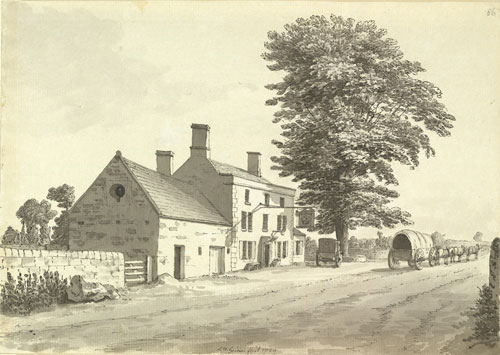
The Crown Inn, 1789
Chairman of Saltford Environment Group, Phil Harding, gave an illustrated talk on "Publishing Saltford's History Online" to the "Friends of Saltford Library" group on Friday 6th May. Phil took the group through SEG's popular history project, revealing hitherto
unknown but fascinating aspects of Saltford's illustrious past.
If your local group would like a similar talk, contact Phil.
Return to top of page
May 2016:
Green Belt Latest:
Parish and Town Councils discuss Joint Spatial Plan
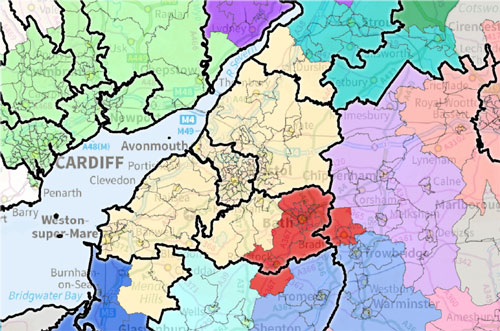
JSP map showing Bristol's "projected" Housing Market Area (in yellow)
B&NES Council held its second Joint Spatial Plan Working Group meeting on Saturday 23rd April for Parish and Town Councils in the Keynsham, Saltford and Chew Valley area of B&NES. Saltford Parish Councillors Adrian Betts and Phil Harding attended the meeting. For background information on the Joint Spatial Plan and its implications for housing numbers see below.
The purpose of the meeting was to give representatives from Parish and Town Councils the opportunity to discuss and identify constraints and issues and then look at aspirations and opportunities.
The conclusion reached by the Parish and Town Councillors present was that after brownfield site development had been completed and if there remained a genuine need for additional new housing in the Bristol Housing Market Area, then the Joint Spatial Plan should look at a new settlement (e.g. in South Gloucestershire) properly designed with sustainable development principles - i.e. a "Garden City/Town". Furthermore, there was a need for Bristol to show that it was doing everything it could do to solve its own housing issues.
The overwhelming feeling of the meeting was that the constraints to further housing development in B&NES meant B&NES could not take any more new housing developments over and above the developments already planned for in the existing B&NES Core Strategy.
The timing and content of the 350+ objections submitted against the proposed 250 houses on the Green Belt at Keynsham East during April (see next story) was fortuitous as B&NES can be in no doubt of the very real concerns and depth of feeling against further unsuitable and unsustainable development in this area.
The Joint Spatial Plan meeting on 23rd April was separate from discussions that unitary councils in the West of England (e.g. B&NES) are having with developers.
The draft Joint Spatial Plan should emerge by the end of May or in early June; the Working Group will meet again then to provide initial feedback on the early draft. It is then we will know if developers have been successful in persuading B&NES to identify Green Belt land for housing development with the attendant risk that speculative planning applications from developers will follow.
The current Joint Spatial Plan timetable, as we previously reported, is:
- June 2016 - Spring 2017
Consultation
- Spring 2017
Pre-submission Plan
- Summer 2017
Submission to HM Government
- Summer/Autumn 2017
Examination by Government Inspector
- Winter 2017
Report by Government Inspector
Background
A huge volume of work and lobbying went into agreeing the housing plans in the B&NES Core Strategy adopted in July 2014. The Core Strategy set out the plans to cover housing needs in B&NES from 2014-2029 and did not identify Saltford's Green Belt for development.
However, a new plan is now being drawn up to replace the housing plans in the B&NES Core Strategy. This is the West of England Joint Spatial Plan covering the 20-year period 2016-2036. Once again the community shall need to make the case to keep the Green Belt safe from inappropriate development.
The Joint Spatial Plan is likely to seek an additional 29,000 new homes over and above existing plans by 2036 across the whole of the West of England, i.e. Bristol, N Somerset, B&NES and S Gloucs.
SEG publishes on our Green Belt page the evidence we submit and other relevant information about the Joint Spatial Plan and its potential impact on the Green Belt whilst we will update our home page (News) with the latest Joint Spatial Plan news affecting Saltford.
Return to top of page
350+ objections (incl. SEG's) to 250 new houses on Keynsham East's Green Belt

On 11th April SEG submitted a formal objection to Development Control at B&NES Council for the the proposed 250 new houses and associated development at Keynsham East (outline planning application 16/00850/OUT).
The deadline for comments was 14th April and over 350 objections including SEG's were received by B&NES. The target decision date is 10th June 2016.
In its objection SEG commented that the development would have a negative effect on an already over-stretched road transport system at peak times on the A4 between Bristol and Bath and will remove Green Belt open land that has an important purpose of separating the two distinct communities of Keynsham and Saltford. We said that the application also ignored all five purposes of the Green Belt in the National Planning Policy Framework (NPPF).
SEG's other points were as follows:-
The very regrettable decision to overrule sustainable development principles and permit Green Belt development at Keynsham in the Core Strategy has happened. The gradual loss of Green Belt land in the B&NES area is slowly creating cumulative negative consequences; transport congestion highlights that fact. It is thus incumbent on B&NES Council to ensure that transport problems are addressed BEFORE the development proceeds and not wait to see how bad things get before it is forced to act.
The transport statement (777 pages) associated with this outline planning application makes no real effort to address the fact that the existing and often extreme transport problems during peak travel periods between Saltford and Keynsham will be made worse by access to the A4 by inhabitants and visitors to and from the new development. One snapshot of traffic flows in April 2013 taken by the consultants KTC Limited at this location is not representative of the many problems faced by weekday commuters at different times of the day, different weekdays and throughout the year.
New housing needs to be located near to jobs to reduce the need for commuter travelling and should not create more problems for existing communities. A new development like this simply creates more overloading of transport systems and reduces air quality arising from higher traffic volumes and congestion (Saltford and Keynsham each have Air Quality Management Areas). It also puts local services under increasing strain, reduces recreational green spaces, the loss of Green Belt depletes natural habitats including wildlife corridors, local tourism/leisure
businesses are put at risk, and agricultural land is permanently lost for food production purposes.
We concluded that those impacts underline why it would be extremely difficult to describe the proposed development as sustainable development.
Saltford Parish Council response to planning application
At its Planning Committee meeting on 5th April, Saltford Parish Council agreed the following response to B&NES Council on the outline planning application from Macktaggart and Mickel Homes Ltd (Land Parcel 7200, Bath Road, Keynsham ref 16/00850/OUT) to build 250 new houses in Keynsham (near Wellsway School) between Saltford and Keynsham in the Green Belt:
"Whilst we regret the decision made to develop the Green Belt between Keynsham and Saltford in the Core Strategy as this extends urban sprawl, we are also concerned that the road transport infrastructure between Saltford and Keynsham is already saturated at peak times of the day creating extended delays to journey times and raising levels of air pollution (ref. a section of the A4 in Saltford is an Air Quality Management Zone). Saltford Parish Council would therefore not wish this development to proceed without
satisfactory measures to address traffic issues."
The planning application can be found on the B&NES Planning Control website (enter 16/00850/OUT in the search criteria).
Return to top of page
River clean, 15th May
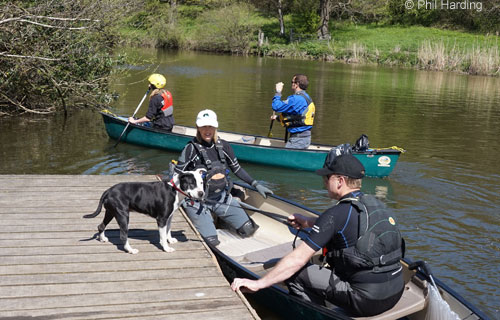
Canoe Avon members + hairy helper(!) during the successful river clean in 2015.
The activist is not the man who says the river is dirty.
The activist is the man who cleans up the river
Ross Perot
We would welcome your help when Canoe Avon, Avon Outdoor Activity Club and the Cheeky Friday Paddle Club hold this year's river clean on Sunday 15th May commencing (with coffee) at 10.30am from the Saltford Rowing Centre. This annual event is held in collaboration with Saltford Wombles. Members of SEG (especially Saltford Wombles) are invited to come along and help clean the riverbank (landside).
If you would like to be part of this (on dry land!) please contact Julie Sampson so that Julie can log your interest and confirm details closer to the event - we can lend you litter pickers, gloves and high viz jackets. Please contact Julie on 01225---874603 or by email to juliebsampson@gmail.com if you are able to support this important annual initiative.
Even if you can only spare an hour or two, helping to keep Saltford clean shows you care.
Return to top of page
Railway habitat project making great strides
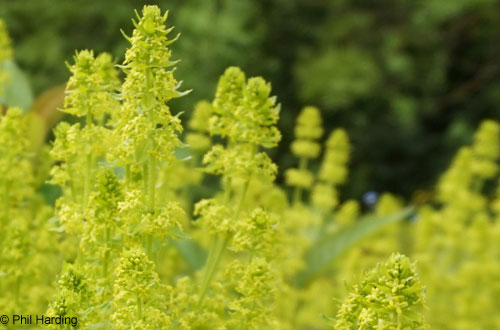
Crosswort growing on the railway habitat restoration project area.
Our project to regenerate the habitat beside a stretch of the cycle path, along the old LMS railway line, has made a great start this spring. The plan is to recreate a habitat similar to that in the 1960s when railway gangers used to maintain the embankment slopes. At that time there were very long lengths of rough grassland, rich in herbs, wild flowers and the insects associated with them.
Having cleared a section of trees a couple of years ago there are now splendid views to the west over the river. Sunlight now reaches the bank allowing grasses to flourish. Already some flowering plants are returning; there is a large area of ground ivy and several patches of crosswort (which isn't found any where else on Saltford).
However, the sunlight enjoyed by walkers, cyclists and flowering plants is also enabling nettles and brambles to grow strongly, which could smother the target species. This is where volunteers come in. So far this spring we have been out several times, using a brush cutter to trim a large area at the top of the bank and hand pulling unwanted plants from around the ground ivy and crosswort patches.
We are looking for more volunteers to help cut back the vigorous growth of nettles and brambles. Our next session will be on Saturday 21st May at 4pm. If you would like to join us please contact the project coordinator Odette McCarthy via our Chairman.
Return to top of page
Getting to grips with crochet
The Saltford UPCYCLING Craft Group is a great way to meet people who enjoy getting together to share and learn UPCYCLING ideas. With the help of the more experienced members some
of us learnt to crochet at last month's meeting. Having seen what can be made using old T-shirts and wool on May 19th we will be building
on the things we practised last month and try some new patterns.
Everyone is welcome to come along to our free, friendly evening, experienced or not. If you have any odds and bods of wool or crochet
needles do bring them along but we have everything to get you started.
Tina and Frances are looking forward to seeing you if you would like to join us on May 19th from 7-9pm at Signs of Saltford (works entrance), 559 Bath Road, Saltford. Phone Frances Eggbeer on 07789--528834 if you would like to find out more.
April 2016
Return to top of page
20th Century Saltford (and photographs wanted)
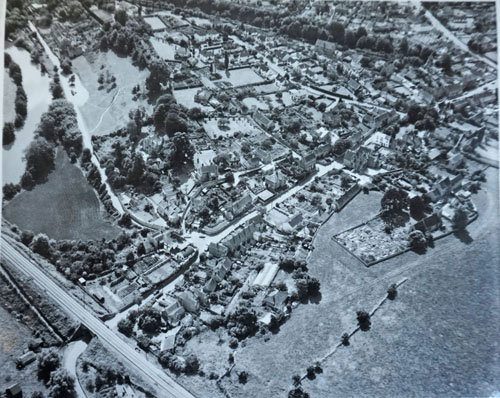
Reproduced by kind permission of © Historic England
Above is an aerial photograph taken in the late 1960s of Saltford viewed from the north-east side of the village. St Mary's church is on the right where a small field can be seen between the churchyard and High Street cottages and the closed LMS railway is bottom left (this became the Sustrans cycleway). A much larger version of this photograph can be viewed in our Online Museum.
We have made some interesting additions and changes to our history project's popular Online Museum during April, partly as a result of a visit to the Somerset Heritage Centre in Taunton.
The 20th Century was a time of great change, probably more than at any other time in human history, and Saltford saw many changes too. To make it easier to see and follow how Saltford develped and changed, we have re-structured the 20th Century page of the history project's Online Museum by grouping photographs and images by subject headings (e.g. People, River, Buildings, etc.).
During April we have obtained and published 8 new aerial photographs of Saltford making a total of 13 aerial photographs dating from 1936 to 2000 in the 20th Century page. Most can be enlarged and show just what Saltford was like when open fields preceded many of today's houses and tree cover (including Elm trees) was different than from today.
The Online Museum 20th Century page can be visited from this link. Do check out other pages of our Online Museum too - another addition in April, for example, was an evocative description of Saltford published in 1791(!) when several apple orchards existed between the Turnpike road (A4) and the river.
Photographs Wanted
Do you have any photographs of street parties in Saltford from the 70s (e.g. the 1977 Silver Jubilee), 80s or 90s for the Online Museum? If so we can scan and return them to you - please contact our Chairman Phil Harding.
Return to top of page
Give your mower a rest (& wildlife a chance)
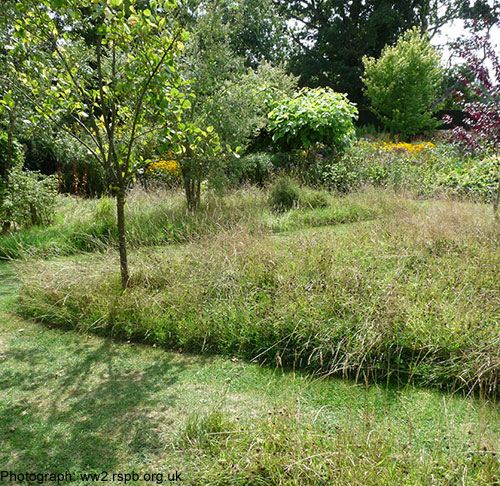
Ever thought about the wildlife benefits of NOT mowing your lawn? The RSPB advice is to give your grass mower a rest as mowing your lawn less, and letting parts of it grow long, saves you time and helps give nature a home. The grasses will set seed, wildflowers will be able to bloom, and the longer stems will create a sheltered microclimate - a mini jungle through which beetles and other small creatures can wander.
You'll see all sorts of insects roving through the long grass, pollinators coming to the flowers in the lawn, and hopefully sparrows and goldfinches coming to feed on the seeds whilst other wild birds will feed and thrive on the insects.
The RSPB advises that you can continue to give the mower a rest into autumn. But cutting it at the end of summer, say at the end of August, also mimics the hay meadows of past decades that made our countryside such a haven for wildlife.
If you are concerned about what the neighbours will think, don't worry as it will still look like you care for your garden if, for example, you create a neatly-edged block of longer grass in the middle of the lawn and continue to mow around it.
Your no-mow area can be any size or shape, however for best results try and make it at least a metre-squared. If you are able to locate your no-mow zone away from flowerbeds it is less likely that it will be invaded by garden plants.
Some further advice from the RSPB:
Create paths that look presentable. The trick is in mowing paths through the longer grass. They can be straight paths in a regular pattern, curving paths, or a mini-maze. Kids will love to run along them. There is extra wildlife incentive for mowing paths - there's evidence that creatures actually like using the short paths to move through the meadow, darting into the longer grass to get food.
Create a spring meadow. Leave your areas of long grass until July, and then mow through until the grass stops growing in late autumn.
and/or:
Create a summer meadow. Mow once in late March or early April and then leave it until September before mowing once or twice in the autumn.
On a warm day in summer, get down at ground level and look closely. See what flowering plants were in your lawn all along but never had the chance to flower, such as daisies, clovers and speedwells.
Remember, it is the less tidy areas of our gardens that allow wildlife to flourish whereas the over-tidy areas are virtually wildlife deserts - especially where non-native flowers, trees and shrubs are grown as these provide little or no food or habitat for insects (both our gardening and wildlife pages advise on the use of native plant species).
Return to top of page
Join Britain's biggest bee survey (19 May to 30 Jun)
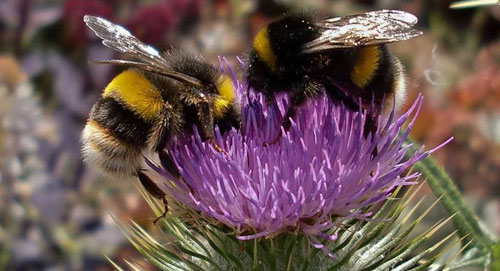
Photograph © Elizabeth Cooksey
Britain's bees make a huge difference to our lives. We can thank them for our food, garden plants, and crops. But our bees are under threat and they need our help. You can join the Great British Bee Count with a FREE and improved smartphone app. Each bee you identify will help the experts build a better picture of the health of our bees.
Details about how to get involved in the "Great British Bee Count 2016" can be found from this link: https://www.foe.co.uk/page/great-british-bee-count-2016-sign-up.
Return to top of page
National well-being data highlights need to protect the Green Belt (- the Government didn't say that, we did!)
A snapshot of life in the UK today was published by the Office for National Statistics (ONS) at the end of March under its Measuring National Well-being programme.
According to the ONS, overall the nation's well-being has improved but, with potential consequences for our future well-being, natural resources have declined. Of the 41 measures, assessments of change show that 17 have improved while 8 have deteriorated and 11 have stayed the same over the 3 year period. Comparisons have been made in most instances with data from 3 years ago.
What's getting better?
Improvements continue to be seen in personal well-being, increases in the proportion reporting very high ratings for their overall life satisfaction, their happiness yesterday, the sense that things in our lives are worthwhile, and those reporting very low anxiety levels.
Areas of life which are also getting better include our personal finances and the economy, a fall in the unemployment rate, healthy life expectancy continues to rise for both men and women, and the number of crimes against the person has fallen.
Improvements have also been seen across some environmental measures. Greenhouse gas emissions have fallen, the extent of areas designated as 'protected' has grown and a growing proportion of us accessed the natural environment. More energy has been consumed from renewable sources in the last year than in previous years and recycling rates have risen, but it is too early to say whether these are indicative of long term changes.
What's getting worse?
Despite increases in overall personal well-being, the proportions satisfied with their health, accommodation, household income and leisure time have all fallen over the three year period, though satisfaction with income and leisure time remain unchanged during the latest year. Population mental well-being scores fell as did adult participation in sport over the three year period. The number of people with a spouse or partner, family member or friend to rely on if they have a serious problem also fell.
A sustainable future?
The data shows that "human capital" rose when looking at things such as education, skills and competencies in the labour market. However the latest data for "natural capital", i.e. the value of natural resources such as woodlands and rivers and the ecosystem services that they provide, shows a long term decline.
The decline in natural capital reminds us why communities in the West of England including Saltford need to protect the area's Green Belt and agricultural land from development as the protection of such land remains paramount for a sustainable future. As Simon Barnes, columnist for The Times, wrote in 2013 "a living countryside is not a luxury but a necessity for the human population."
If you want to look at the report from the ONS in detail, it can be viewed from this external link.
Return to top of page
2016 Big Garden Birdwatch results: House Sparrow is tops
8,262,580 birds were counted in 2016 Big Garden Birdwatch held on the weekend of 30/31 January. The top ten most commonly observed birds across the UK were:-
1. House Sparrow
2. Starling
3. Blue Tit
4. Blackbird
5. Wood Pigeon
6. Goldfinch
7. Chaffinch
8. Great Tit
9. Robin
10. Long-tailed Tit
For England the top five were:-
1. House Sparrow
2. Blue Tit
3. Starling
4. Blackbird
5. Wood Pigeon
The Blackbird was the the most widespread garden bird, appearing in 88% of gardens. However, their numbers have declined since the first Birdwatch in 1979. The Long-tailed Tit was a new entry in the top 10 for 2016, arriving at 10th position. The House Sparrow kept its place at the top spot this year, with around four appearing in each garden.
According to the RSPB, January's mild weather might account for more smaller birds surviving the winter to be counted thus explaining the appearance of more Long-tailed Tits, Coal Tits and Goldcrests. And though natural food sources were plentiful, it's clear these birds still rely on the food we put out in our gardens. There were more sightings of the tiny Goldcrest this year. Along with its cousin, the Firecrest, it's Britain's smallest bird.
Song Thrush numbers halved between 1970-1995. Song Thrushes are relatively short-lived birds. They live an average of 3-4 years, but a few can reach quite an advanced age. Loss of hedgerows and wet ditches means feeding and nesting sites have been removed, while increased land drainage and tillage are likely to have reduced the number of earthworms and other crucial invertebrate prey available to Song Thrushes on farmland.
But you can help bring back this garden favourite - see our gardening page for advice on wildlife friendly gardening.
You can see the 2016 Big Garden Birdwatch results on the RSPB website from this link: RSPB - Birdwatch. If you are interested in learning more about the birds that are regularly observed in Saltford, these are listed on the right hand side of our wildlife page and each bird species listed is a link to full details on the RSPB website.
Information source: RSPB
Return to top of page
April 2016:
Annual Saltford Dawn Chorus Walk, 24th April
If you are able to get yourself up early, why not join our friends at the Keynsham and Saltford Branch of the Avon Wildlife Trust for a few hours listening to, and watching the birds get up after a night's roosting? This year's Dawn Chorus will be held on Sunday 24th April 4.30am - 8.00am, starting at Saltford Shallows car park.
This really is a great way to learn how to identify from their songs the many birds that are found in Saltford. Songs of all common species will be pointed out and their identification features clarified. The walk will follow the railway path cycle track towards Bitton, and back again. Wrap up warm as it can be very cold that early. Binoculars and a bird identification guide will be helpful for once it gets light. Above all you need good ears to be able to pick out the 30+ different species the annual walk normally finds! A hot flask of your favourite beverage is recommended.
For further information and to confirm your attendance, contact Dave Sage on mobile 07899--716068 the week before the event.
Return to top of page
Those soaring Buzzards

The Buzzards (Buteo buteo) that we increasingly hear and see gliding, soaring and diving in the sky above Saltford are now the commonest and most widespread bird of prey in the UK, pushing the Kestrel (Falco tinnunculus) into second place. In Saltford, the Buzzard underwent a dramatic change in status in the last few decades.
In the 1940s-1960s it was exceptional to see a Buzzard here, but in the late 1970s it became a regular, although infrequent visitor. Although one or more birds had evidently settled in Tennant's Wood (alongside the railway cycle path below Kelston) by 1981, up to about 1984, the only reliable way to see the species was to scan the Kelston-North Stoke ridge with binoculars. But by the end of the 1980s it had become a daily sight in Saltford itself, and by the end of the 1990s double-figure gatherings were commonplace under appropriate conditions. Populations have remained at this high level ever since.
Here are some facts about this magnificent raptor's natural history.
The Buzzard's national increase is a return to 'natural' conditions. During the Victorian era of generalised mass-slaughter of predators, it was eradicated from all but the most remote parts of Britain. Chances of a resurgence, with the mass deployment of keepers to the wars, were thwarted, and the species brought even nearer to national extinction, during the peak myxomatosis years (1950s/60s) when its main diet of wild Rabbit was drastically reduced. However, as the Rabbit population has re-established itself as a result of increasing genetic resistance or immunity to myxomatosis, so has the Buzzard population.
Populations tend to be densest where the fields are smallest, because it favours abundant hedgerows and small woods. Although Saltford lost many hedges during the 1960s-1980s, those which remain, particularly north of the residential area, are tall, wide and often associated with ditches, providing excellent conditions for prey.
Despite its medium-large size, the Buzzard is not a major predator, preferring a diet of carrion (dead and decaying flesh) and earthworms supplemented by live large insects, reptiles, frogs, small mammals and birds (including occasionally pheasants and partridges).
A slow almost lazy flier with little chance of catching its prey on the move, a usual tactic is to perch motionless on a branch of a large tree - or even on a lamp post. Where perches are scarce, or where it wants a broader view, it scans from the air. Its markings make excellent camouflage whilst perched in a tree and a Buzzard will wait patiently, sometimes for hours at a time, until a prey animal passes underneath. It will then swoop down and snatch the unsuspecting prey.
Resident in most of Britain, as the spring breeding season arrives Buzzards can be seen engaging in spectacular aerial displays, soaring, tumbling and even performing loop the loop. The most exhilarating displays are on days of fine weather, when hot air is rising. The species has a variety of rather plaintive mewing calls. The contact call can be heard from high in the sky, particularly during display, but is given year-round. For a few weeks in late summer more insistent, longer calls can be heard from newly fledged juveniles repeatedly calling for food from their parents.
Much foraging is solitary, but this is flexible. Indeed, the most obvious feeding activity in Saltford is generally during and immediately after grass-cutting and ploughing, when up to a dozen will gorge on the exposed small animals, amid gulls doing likewise. Two or three soaring birds often come close together for a few minutes at any time of year, but particularly during the period when young leave their natal territory, flocks of up to 20 soar round and round in thermals for longer spells, before peeling off singly or in small groups to all points of the compass.
With a lifespan of up to 25 years, Buzzards commence breeding in their third year, laying a single clutch of 2-3 eggs. Breeding pairs usually construct their nests in a large tree on a fork or branch, usually close to the edge of a wood, and have an interesting habit of decorating their nests with fresh green foliage. The female is larger than the male (as with most birds of prey).
The local history of the Buzzard looks set to be repeated by another large raptor almost eradicated from Britain by the Victorians: the Red Kite (Milvus milvus). This is now at the stage in Saltford of the Buzzard in the late 1970s, with multiple records each year (over a dozen in 2015). Most birds are fly-overs in March-June, with none yet having settled, even for a day. Thus, over the next few months, an eye to sky, mid-morning onwards on calm, cloudless, warm days will almost guarantee sightings of Buzzard and, just possibly, Red Kite.
Article by Phil Harding and Will Duckworth
Information sources:
Will Duckworth, RSPB, birdsofbritain.co.uk, Hawk and Owl Trust.
Return to top of page
Saltford Upcycling Craft Group, 21st April
What: It's free, easy, fun and everyone is welcome to come along and participate.
When: 7-9pm, Thurs April 21st.
Where: Signs of Saltford (works entrance), 559 Bath Road, Saltford.
Intrigued? Then phone Frances Eggbeer on 07789--528834 to find out more - or just come along on 21st April.
Return to top of page
B&NES gets bronze award for sustainable food
To achieve energy, food & economic security,
we need to keep asking the right people
the right questions
Good news! Bath and North East Somerset has achieved the bronze Sustainable Food Cities award for the entire district - much credit goes to Sophie Kirk, Corporate Sustainability Officer (Food) and her colleagues at B&NES for co-ordinating and driving forward this agenda.
The Sustainable Food Cities Awards are designed to recognise places that are taking a joined-up holistic approach to food and are achieving significant outcomes on a range of health and sustainability issues such as healthy diets, food poverty, community activities, food procurement including Fairtrade (Saltford is a Fairtrade village), and waste.
A broad range of businesses, community groups and organisations have contributed to the achievement of the award. The bronze award has got B&NES off to a good start since its Local Food Strategy was adopted in 2014 - here's hoping for further progress. If this topic interests you visit www.bathnes.gov.uk/localfood for further information.
Information on Sustainable Food Cities can be found at www.sustainablefoodcities.org.
Return to top of page
Swap clothes during Bath Fashion Week (19 April)
I base my fashion sense
on what doesn't itch
Gilda Radner
On average 30% of clothes in our wardrobes haven't been worn in the last year. So you are invited to bring any adult clothes, shoes and accessories that you are proud to pass on to others to the Bath Big Clothes Swap.
During Bath in Fashion Week the Bath Big Clothes Swap organised by B&NES Council is taking place
on Tuesday 19 April at Komedia, 22-23 Westgate Street, Bath 6pm-9pm.
The event will include the "Love your clothes" road show with tips and advice on how to:
- make your clothes last longer
- reduce the environmental impact of laundering your clothes
- recycle and pass on your unwanted clothes
- make the most of your wardrobe
Upcycling and repair demonstrations/stalls for you to visit during the evening. More details for this event can be found at: www.bathnes.gov.uk/textiles.
Return to top of page
Saltford Spring Clean: Litter pick Sat 16th April
It's our village, let's keep it clean
Saltford Wombles' next litter pick will be on Saturday 16th April starting at 9.30am, meet at The Bird in Hand (Note: change of date from 9th April). The target area will be along the river and the cycle track.
Why not come along and show your pride in Saltford by helping to clean-up the village? Litter picking is rewarding in itself and all generations can and do take part; it really is satisfying to clear litter from our streets, footpaths and public areas.
If we can keep accumulated litter down we can deter those who carelessly drop it; dropping litter in a clean and litter-free area stands out much more as anti-social than when an area is already heavily littered.
If you can't make 16th April but wish to womble yourself in April to clear an area that needs attention, perhaps as a family activity, please let Julie Sampson know and we can lend you litter pickers, gloves and high viz jackets. Please ring Julie on 01225---874603.
Information about Saltford Wombles is on our "Less Waste" page
- click here >>
March 2016
Return to top of page
History of Saltford - one year on
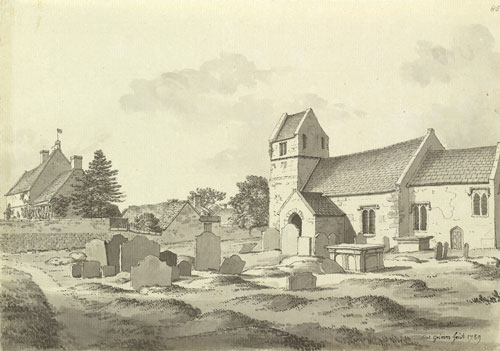
St Mary's (& Saltford Manor) in 1789, 146 years after a group of Roundheads
vented their anger on the church in 1643 during the English Civil War.
We have proved that Saltford has a fascinating past,
unsurpassed by any other English village.
We launched SEG's History of Saltford Project a year ago in March 2015 and brought to the public's attention the Saltford Carthaginian Coin from the Iron Age (dated 300-264 BC) in April 2015, so it's a good time to provide an update.
Firstly, we'd like to thank everyone who has given or lent us photos, artefacts, books and information or shared their ideas and theories concerning Saltford's history.
We have proved that Saltford has a fascinating past, unsurpassed by any other English village. We've built up an extensive resource on the website attracting many 100s of page visits each month. With the project now containing over 350 images and photographs of people, places and archaeological finds, there is much to see and read as you delve into Saltford's history through this unique project.
We have researched and published for the first time many aspects of Saltford's past and its people. These include the French battling, anti-slavery patrolling Admiral Kelly of Saltford House, the 1861 census, the Domesday Book entry for Saltford, the detail of Saltford Manor's medieval domestic wall paintings, and we have filmed and published aerial videos of Saltford so that we record history in the making.
But we have done much more than that. Last October/November Bath and Camerton Archaeological Society (BACAS) assisted by SEG volunteers kindly undertook for us a geophysics survey of the Roman Coffin field on the north side of the village, the first geophysics survey of this field. The survey indicated the possible presence of some prehistoric roundhouses in the northern portion of the field and signs of what may be a Roman structure on higher ground to the
southern end of the field. We hope there will be a follow-up survey to reveal more later this year.
With landowners' permission SEG members have also carried out metal detection surveys around Saltford and one surprising find last December was the medieval Pilgrim's Lead Ampulla. This and many other artefacts discovered in Saltford over many years and not seen before by most residents are featured in our Online Museum.
What next?
We have given talks on this innovative project to audiences in Saltford and Bath and more are planned. If your organisation would like an illustrated talk about the project and its findings, contact our Chairman.
We are currently discussing and investigating the options for displaying some of Saltford's artefacts either in Saltford, our first choice, or elsewhere. We are also creating self-guided history walks so that you can walk Saltford's past with your smartphone.
We are researching and publishing new material on a continuous basis so we welcome your old photographs, maps, and stories of Saltford.
You can find links to our history project from our website's home page or visit the project from this link.
Return to top of page
Juliana Kelly photograph sought
Do you have an old photograph or portrait picture (from the late 19th Century) of Juliana Kelly (b.1803, d.1896, née Boyd and known locally as Mrs Admiral Kelly)? She was a local philanthropist who helped the poor in the village and paid for the re-building of Saltford School but we have no photograph of her for our feature page on her husband, Admiral Benedictus Kelly.
Portraits of Benedictus and Juliana were displayed at Saltford House when they lived there and whilst we have been successful in locating two portraits of the Admiral, we have not been so fortunate with Juliana. Do contact our chairman if you can help. You can read about Juliana's generosity on the Admiral Kelly page from this link.
Return to top of page
Children happier outdoors; green open spaces essential for good mental health
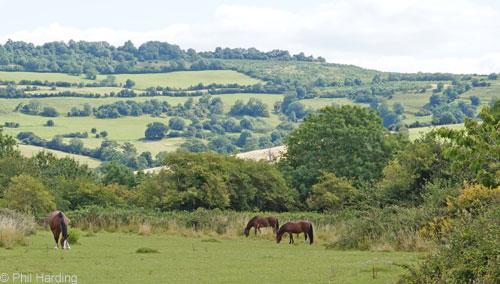
"Nature can do more than physicians" - Oliver Cromwell
A recent survey of 2,000 British parents carried out by outdoor retailer Mountain Warehouse has revealed that British children spend just 4 hours a week playing outdoors, half the time that their parents did. TV presenter, wildlife lover and all-round champion for the outdoors, Steve Backshall, is now getting behind a campaign with Mountain Warehouse (external link) to
help get children back outside.
The survey found that:-
- 22% of British children have never climbed a tree;
- 40% have never played conkers;
- 20% have never flown a kite or made a daisy chain;
- 60% have never built a treehouse or a swing;
- 80% of British parents admit they prefer to keep their children indoors for reasons of safety; and
- 50% of British parents admit to sometimes relying on school to ensure their children play outside.
The survey also revealed that 89% of British parents say their children are generally happier after playing outside. This confirms other research findings (e.g. Exeter University Medical School, 2014) that parks and other green spaces are essential for the quality of life and good mental health.
This underlines the need to protect Salford's Green Belt and open spaces; the National Planning Policy Framework (NPPF) that determines national planning policy states (para 73) "Access to high quality open spaces and opportunities for sport and recreation can make an important contribution to the health and well-being of communities".
As spring and summer beckons, Saltford is a great place to be outdoors for adults and children alike. There are many outdoor sport and recreation facilities and activities in and around the village including tennis, cricket, football, walking, jogging, golf, cycling, horse riding, angling, kayaking, rowing, and sailing. These facilities are also popular with visitors
from the surrounding area; Saltford's Green Belt provides an outdoor location that is important to the quality of life for a much greater population than just our own.
Return to top of page
River and Canal Water Space Study

The River Avon at Saltford
A study looking at new ways to use the river and canal system around Bath was launched on 14 March. B&NES Council, the Canal & River Trust, the Environment Agency and Wessex Water will work together in the jointly funded Water Space Study with the "aim of identifying projects to transform and revitalise the waterway network in the area". The project partners will be working with local consultancy firm Atkins.
The study will gather new evidence about how the waterways are used nowadays, where historically rivers and canals were heavily used for industry, business and trade, they are now used increasingly for sports and leisure. Engaging with local communities, it will look at regeneration, development and environmental opportunities along the River Avon between Bath and Keynsham, and along the Kennet and Avon Canal between Deep Lock and Limpley Stoke Viaduct.
The study will look at all aspects impacting on the river and canal, including how land is managed, boat moorings, river navigation by boats, leisure and recreation opportunities and environmental gains.
The project is due to conclude its recommendations in March 2017. Opportunities for public engagement are being planned for summer 2016.
Information on the river and canal Water Space Study can be found at www.bathnes.gov.uk/riverandcanal.
Return to top of page
Overcoming the politics of climate change denial

When President Obama signed the climate change agreement with 194 other nations in Paris last December, it was a significant victory for clean energy advocates worldwide. But it will be the next US President in charge of the world's second biggest carbon emitter (China being the biggest), who will largely carry the task of reducing that nation's carbon emissions.
Yet the different stances on climate change taken by the candidates for this November's US Presidential Election range from complete denial, even describing it as a hoax, to a strong awareness and desire for action.
Many studies have attempted to discover which factors most heavily influence individuals' beliefs about climate change and a new analysis* published in February in the journal Nature Climate Change looked at 25 polls and 171 academic studies across 56 nations. The lead author was Matthew Hornsey, a psychology professor at the University of Queensland in Australia.
* "Meta-analyses of the determinants and outcomes of belief in climate change" by Matthew J Hornsey, Emily A Harris, Paul G Bain and Kelly S Fielding (and summarised by Chelsea Harvey, www.washingtonpost.com).
Two broad conclusions emerged:
First, many intuitive assumptions (such as education, gender, subjective knowledge, and experience of extreme weather events) were overshadowed by stronger influences, i.e. values, ideologies, worldviews and political orientation.
Second, climate change beliefs have only a small to moderate effect on the extent to which people are willing to act in climate-friendly ways.
Political affiliation was the demographic variable most strongly correlated with people's beliefs about climate change, with people who vote for more liberal political parties being more inclined to agree with scientists that climate change is manmade. More importantly a person's political ideology, i.e. a person's overall general set of consistent political beliefs and thus a different measure than the party a person may intend to vote for, was less of a predictor, although still a significant factor.
The report's authors concluded that this suggested that acceptance of climate change is more aligned to specific identification with political parties than to underlying political ideologies.
"What caught my attention was the role of ideologies and worldviews, and how much scientists are swimming upstream by trying to change the mind of people with a certain political mindset," lead author Matthew Hornsey said. "There's a school of thought out there that rather than just repeating the evidence, you need to focus on these underlying worldviews and then make your message seem friendly to those worldviews... For instance suggesting that environmentalism is patriotic or important for national security may help the idea resonate with some audiences".
There is also the case that many people with strong beliefs about climate change are nevertheless not inclined to support policies that may come at a personal cost to themselves. "There is a chunk of people who believe in climate change and want something done about it, but in a similar way that they want something done about third world poverty," Hornsey said. "It's something that 'the world' should deal with, but not necessarily in a way that requires personal sacrifice."
Editor's comment:
The findings of the study perhaps hold few surprises but they can help focus our minds on how we lobby those we seek to influence and the best way to overcome long held views that hold back our progress towards a cleaner, more sustainable future.
Whilst we might accept that some views are so entrenched we may never change them (and few people, including politicians, like to admit they have been wrong), we can work round them and use different approaches. For example rather than dwelling on the downsides or debating whether the climate changes we are experiencing are a result of human activity, we can promote the positive outcomes from taking action such as energy security, cleaner air, food security, more jobs, economic benefits, and greater resilience.
These thought-provoking statements are worth bearing in mind when we attempt to converse with those in denial about climate change:
"We know for sure that human activity is influencing the global environment, even if we don't know by how much. We might still get away with it: the sceptics could be right, and the majority of the world's scientists wrong. It would be a lucky break. But how lucky do you feel?"
- New Scientist article 'Climate Change: Menace or myth?' (2005)
"Make sustainable development so desirable it becomes normal"
- Futerra (Sustainability communications consultancy)
Return to top of page
Don't expect low oil prices to remain, warns IEA
"It is easy for consumers to be lulled into complacency by ample stocks and low prices today, but they should heed the writing on the wall: the historic investment cuts we are seeing raise the odds of unpleasant oil-security surprises in the not-too-distant-future"
IEA Executive Director Fatih Birol (February 2016)
Global oil supply growth is plunging as an extended period of low prices reduces investment in oil exploration and production capital expenditures in response to the current glut that is pushing down prices, the International Energy Agency (IEA) has reported in its annual Medium-Term Oil Market Report (MTOMR) released in February.
The IEA report notes that while oil prices should start to rise gradually once the market begins rebalancing, the availability of resources that can be easily and quickly tapped will limit the scope of rallies - at least in the near term. However, the report points to the risk of an oil price spike in the later part of the outlook period (to 2021) arising from insufficient investment as a direct result of low oil prices now.
"Switching to 'Renewables' generates jobs, skills, purpose, power, wealth, future, resilience, autonomy, freedom, unity: Sustainable Society"
Dave Hampton, Carbon Coach (2011)
That report shows the stark difference between the outlook for fossil fuels and clean renewable energy where, according to Al Gore, founder and chairman of The Climate Reality Project, in his recent and latest Technology, Entertainment, and Design (TED) lecture he showed why we can be optimistic (but not complacent) about renewable energy.
He said that at a global level renewable energy is growing exponentially with growth significantly beating expert projections. With the cost of solar energy having come down around 10% every year for the past 30 years, this expansion means the renewable energy transition could very well be the biggest business opportunity in the world right now. And around the world, from China to India to the US, countries are adding more and more capacity in renewable energy (e.g. 69% of new electrical capacity added in the US last year came from renewables).
The change to clean renewable energy is happening - what matters now is the speed of implementing that change.
Return to top of page
Fairtrade Fortnight quiz answers
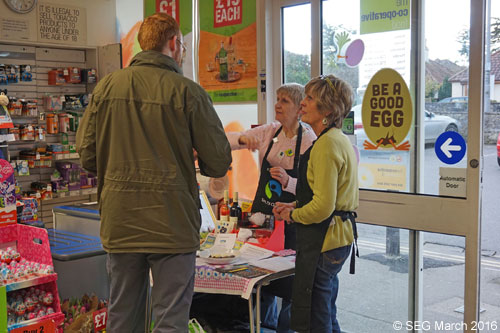
Frances and Stella at the Fairtrade Group's stall, Co-op, 5th March 2016
The Saltford Fairtrade Group had a stall at the Co-op store in Saltford during Fairtrade Fortnight on 4th and 5th March to help spread the Fairtrade message. Here are the answers for the quiz sheet handed out from the stall:
- The first Fairtrade product sold in the UK was a banana.
- The Co-operative's first own-brand product converted entirely to Fairtrade was chocolate.
- Fairtrade Fortnight is held each year over two weeks in February and March.
- Fairtrade products are now sold in over 125 countries.
- Saltford gained Fairtrade Village status in 2013.
For more about Saltford's 'Fairtrade Village' status visit our Fairtrade page. If you want to know how you, your shop, school, business, community group or club can get involved then please contact our local Fairtrade Group by
email to saltfordfairtrade@hotmail.co.uk.
Return to top of page
March 2016:
Admiral Kelly - our enigmatic hero

(Montage of much larger images from our Admiral Kelly feature page)
Fighting the French from his early teens, holding directorships for two railway companies, and funding education, Admiral Kelly was probably Saltford's most remarkable 19th Century resident. But what was not known in Saltford until now was his important role in rescuing African slaves whilst facing great personal danger and then providing graphic and harrowing evidence in court that was used thereafter by a prominent campaign against slavery backed by Queen Victoria.
During February 2016 our research has uncovered extraordinary information about Admiral Kelly's anti-slavery patrols before he came to live at Saltford House (from 1856 to 1867). This is now published in detail as an illustrated feature item within our online history project.
Here is a short summary; there is a link to the full feature at the end of this article.
"Ever be bold, the port to hold"
"fortiter occupa portum" - Kelly College motto
Admiral Benedictus Marwood KELLY was born in 1785, at Holsworthy, Devon and died in 1867 aged 82 at Saltford House. Having joined the Royal Navy at just 13 Benedictus rose to the rank of Admiral (on the reserve list) in 1863 after active service in the French Revolutionary and Napoleonic Wars and, as we have recently discovered, in the anti-slavery patrols.
He was posted as Captain to command HMS Pheasant on anti-slavery patrols off the west coast of Africa between 1818 and 1822. These patrols were dangerous and Captain Kelly lost several of his men. Some were murdered by Portuguese slave traders in a successful escape bid and others including the ship's surgeon died from yellow fever. It is likely that Captain Kelly contracted it too as he retired from active service on health grounds after this posting.
Captain Kelly and his men rescued over 300 African slaves from Portuguese slave traders. But it was his graphic and compassionate evidence to the Court of Sierra Leone of the horrendous conditions suffered by 71 slaves held on the Nova Felicidade when it was seized by HMS Pheasant in 1819 that proved especially influential thereafter.
His evidence was reproduced in several publications during the 1820s and was helpful for those seeking the complete abolition of the slave trade. Some 20 years later it was repeated in the 1840 prospectus for the "Society for the Extinction of the Slave Trade and the Civilization of Africa". The society's President was HRH Prince Albert. Prince Albert and his new wife Queen Victoria were each individually listed as financial supporters of the society.
Admiral Kelly was also a supporter of education. He made a grant of £100 to Saltford School in 1864 and, more famously, when he died in 1867 he bequeathed £200,000 for the establishment of Kelly College that was built in Tavistock, Devon. This opened in 1877 as a boarding school for the "sons of Naval Officers and other gentlemen" (Kelly College merged with Mount House and became Mount Kelly in 2014).
He died without children but his widow Juliana, a local philanthropist, survived him for a further 29 years. Juliana generously paid for the re-building of Saltford School in Queen's Square in 1874. Juliana died in 1896 and bequeathed financial gifts under the care of the Rector of Saltford to benefit poor parishioners.
You can read and see much more about our humanitarian hero and his many exploits on our history project special feature page: Admiral Benedictus Marwood Kelly >>
Return to top of page
Clearing Saltford's litter as Saltford School shows the way
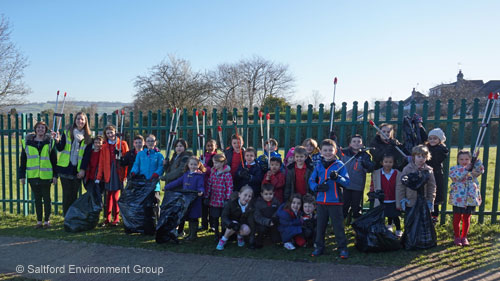
Saltford School's enthusiastic Green Team led by Miss Jupp
(second left) after clearing the playing field of litter.

Members from Saltford School's Green Team with litter they had collected.
A litter pick was held by Saltford School's Green Team with assistance from Saltford Wombles on 25th February, this was for the 'Clean for the Queen' initiative. We congratulate and thank the Green Team led by Miss Jupp for demonstrating such a community spirit and shared pride in our village.
The enthusiasm of the children was great to see and in just 50 minutes they picked up over 3 complete sack-fulls of litter on the playing field by the school and in Manor Road.
Saltford Wombles are planning a litter-pick for Saturday 27th February (meet 9.30am at The Little Coffee Shop, Manor Road).
With two litter picks having been held at the end of February, Saltford Wombles' next litter pick after those will be on Saturday 9th April (9.30am, meet at The Little Coffee Shop).
However if you wish to womble yourself in March to clear an area that needs attention, perhaps as a family activity, please let Julie Sampson know and we can lend you litter pickers, gloves and high viz jackets. Please ring Julie on 01225---874603.
Information about Saltford Wombles is on our "Less Waste" page - click here >>
Return to top of page
Giving a new purpose to your old T-shirts
What can you do with a pretty coloured T-shirt that is not good enough to wear or give to a charity shop? Come along to the friendly, free Saltford UPCYCLING Craft Group and find out how to re-purpose your old T-shirts, we think it will surprise you.
Join us on March 17th, 7-9pm at Signs of Saltford (works entrance) 559 Bath Road, Saltford. If this sounds like fun ring Frances Eggbeer on 07789--528834 to find out more or come along with an old T-shirt if you have one (the bigger the better). Don't worry if you haven't got one, we have some to work on. Frances and Tina are looking forward to seeing you.
Return to top of page
Our local habitat project has new coordinator

Crosswort growing on the railway habitat restoration project area.
We are pleased to announce that recently recruited SEG member Odette McCarthy is our new railway path habitat restoration project coordinator. This will enable us to take the
project to its next phase, primarily to prevent the area from reverting back to scrub and trees, obscuring views and shading some of the rare sun-loving plants that have recently returned.
This local project has seen some notable successes:
- The return of a number of rare and unusual plants to the area.
- Fantastic views recreated across to the village and the river.
- Thanks and congratulations from Railway Path users.
- Some first class efforts from our team of community volunteers and from Saltford's Guides, Beavers and Scout groups.
- Removal from the upper and middle slope of the previous large population of the unwelcome alien invasive Himalayan Balsam.
Anyone wishing to join the project volunteer list should contact Odette via our Chairman.
Return to top of page
Keeping the Green Belt Green: Joint Spatial Plan update
Don't blight the land that feeds you
We reported in January and in our February newsletter the need to defend the Green Belt from the forthcoming West of England Joint Spatial Plan (JSP) where 29,000 additional new homes over and above existing plans are sought by 2036. We highlighted our submission paper of 27th January (on our Green Belt page) that details the case against such development both on Saltford's Green Belt and on the Green Belt more generally.
SEG's Chairman Phil Harding met with our local MP Jacob Rees-Mogg on 6th February and discussed the strong planning and local democracy reasons for not permitting Green Belt development and the need for more imaginative ways of using existing brownfield sites.
They also discussed how best to overcome the problems arising from the pressure to build more houses. If a genuine need (not demand) for more housing really did exceed the brownfield land available, then consideration of a single-hit new "Garden City" (or town) approach could be a more sustainable solution worth investigating. Such an approach would be preferable to gradually destroying piece by piece the Green Belt agricultural land around existing communities whilst making peak time congestion even worse on over-loaded transport routes.
Jacob Rees-Mogg has agreed to write to the leader of B&NES Council, Cllr Tim Warren, on this matter.
At its 2nd February meeting, Saltford Parish Council agreed to participate in the North/West Area working group proposed by B&NES Council to discuss issues and proposals relating to the JSP and Transport Plan. The working group does not have formal terms of reference as it will be mainly concerned with information sharing whilst work on the JSP progresses; it will run for a short period between February to May.
Timetable
The current JSP timetable is:
- June 2016 - Spring 2017
Consultation
- Spring 2017
Pre-submission Plan
- Summer 2017
Submission to HMG
- Summer/Autumn 2017
Examination by Government Inspector
- Winter 2017
Report by Government Inspector
The housing plans in the B&NES Core Strategy (2014-2029) adopted in July 2014 after lengthy and extensive consultations, negotiations and examination will be replaced by the new West of England Joint Spatial Plan (2016-2036). The JSP website is at www.jointplanningwofe.org.uk.
SEG publishes on our Green Belt page the evidence we submit and other relevant information about the JSP and its potential impact on the Green Belt whilst we will update our home page (News) with the latest JSP news affecting Saltford.
P.S.
In December 2015 the Government launched a consultation on some proposed changes to the National Planning Policy Framework (NPPF) primarily dealing with definitions of affordable housing, increasing residential density and development on brownfield land. SEG became aware of this on 19 Feb 2016 and submitted comments on the deadline, 22 Feb 2016.
There were two questions posed by Government of particular concern:
- "Should local communities have the opportunity to allocate sites for small scale Starter Home developments in their Green Belt through neighbourhood plans?" and
- "Should planning policy be amended to allow redevelopment of brownfield sites for starter homes through a more flexible approach to assessing the impact on openness?".
In addition to addressing those questions in our response we also answered
questions on a proposal to amend the definition of affordable housing in national planning policy to include a wider range of low cost homes, and the benefits of strengthening policy on development of brownfield land for housing.
If this topic interests you (or you have difficulty sleeping at night!) you can see the comments submitted to DCLG by SEG by clicking on this link: SEG comments on NPPF consultation, 22 Feb 2016 (pdf opens in new window). For future reference this can be found in the policy section of our Green Belt page.
Return to top of page
Fairtrade Fortnight (29 Feb-13 Mar): Lots going on!
Sit down for breakfast, stand up for farmers!
Millions of farmers and workers in developing countries work hard every day to grow the food we eat. Yet many don't earn enough to know where their next meal is coming from.
During Fairtrade Fortnight (29 February - 13 March), the Fairtrade Foundation will be encouraging organisations, businesses and schools to inspire Big Fairtrade Breakfasts in their community - and wake others up to the challenges facing farmers and workers. By offering Fairtrade products your
business, workplace or organisation can be part of the solution to food insecurity. Take the opportunity this Fairtrade Fortnight to help your customers, staff and students to understand what your commitment to Fairtrade means.
More about Fairtrade Fortnight can be found at: http://www.fairtrade.org.uk/fortnight.
Saltford Fairtrade Group
During Fairtrade fortnight Saltford Fairtrade group will be joining forces with Saltford Co-op. During the fortnight the Co-op will be running a raffle behind the counter.
On Friday 4th and Saturday 5th March from 2-4pm the Fairtrade group will have a stall outside the Co-op (weather permitting) in support of this event. There will be tastings and a quiz for the kids. Please come and say hello and show your support.
Event at University of Bath
In conjunction with B&NES and Bath Spa University, the University of Bath will be holding a Fairtrade event on their campus at 13.00 on Wednesday 9th March.
The event is hosted by their Pro-Vice Chancellor Professor Peter Lambert and attended by special guests Ana Marie, a Nicaraguan Fairtrade Producer, Chairman of B&NES Council, the Mayors of Bath and Bradford on Avon and the Chief Executive of the Fairtrade Foundation.
It will be held at The Edge, starting with a 30-minute canape reception for staff and guests. They expect representatives from various business organisations, Saltford Fairtrade Group, and councillors from Bath and Bradford on Avon to attend as well as staff, students and members of the public.
The Fairtrade event itself is a 3 part session (1.5 hour):
- part 1: Ana Maria, a Nicaraguan Fairtrade producer will give a talk
- part 2: Talk by Michael Gidney, Chief Executive, Fairtrade Foundation
- part 3: Roy Maconachie's (a Bath Uni researcher) film on his project on the impact of Fairtrade policies on female producers in Ghana followed by an academic debate/panel discussion.
There will be an interesting assortment of stalls including the Saltford Fairtrade stall, an Environment stall, a Co-op stall, a local final year student's Fairtrade chocolate stall, Traidcraft stall, Shared Interest stall and a display of Liz Earle's Fairtrade Gold.
Please contact Su Steenberg (ss25052@bath.ac.uk or call 01225--386510) to register interest in attending. Visitors will be welcomed on the day without prior registration.
Return to top of page
SEG membership now over 450
During February our membership grew to pass the 450 mark. If you live or work in Saltford and would like to join (membership is free) you are encouraged to do so - or if you know someone who might be interested, do suggest they join us.
2016 will be an important year for Saltford as SEG and the Parish Council will be making the case for protecting the Green Belt from development in the forthcoming Joint Spatial Plan; a large membership base helps strengthen the case we make.
Instructions on how to join SEG can be found in our Contact section.
Return to top of page
B&NES Council maintains its aspiration to open a station at Saltford
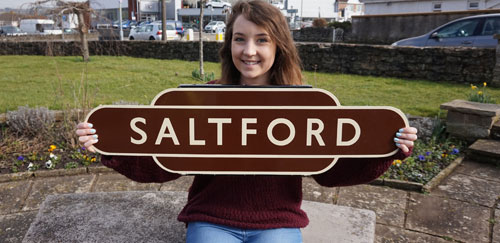
A reopened Saltford station will be of greatest benefit to Saltford's younger generation.
The following is an extract from B&NES Cabinet background papers for its 10th February meeting (Metro West Phase 1 Update Report):-
"The Council has an aspiration to open an additional station at Saltford, which can potentially be achieved after Metro West Phase 1 has been implemented. However, it is dependent upon the Metro West Phase 1 project delivering a workable timetable that will improve
services at Keynsham and Oldfield Park to a half-hourly frequency. Unfortunately, the above GWR timetable work for Phase 1 has been delayed by a couple of months. As soon as this work has been completed the Council can then continue to undertake further feasibility work on the Saltford Station proposal."
Return to top of page
SEG submits comments for West of England Joint Transport Study
On 27 January 2016 SEG submitted comments to West of England Joint Transport Study. The local councils of Bath & North East Somerset, Bristol, North Somerset and South Gloucestershire were seeking people's views on how and where transport should be provided over the next 20 years as part of the Joint Spatial Plan.
Our comments were as follows:-
Saltford Environment Group strongly supports the development of the Metro West rail project and re-opening a railway station at Saltford as part of Metro West.
Saltford Environment Group recognises that transport congestion and a reduction in air quality is already a major problem at peak periods for existing settlements and communities. Saltford is a typical example as it has high levels of traffic congestion at peak times and part of the A4 through Saltford has been designated an Air Quality Management Area due to periodic and dangerously high levels of Nitrogen Dioxide from vehicles. For that
reason, improved transport solutions should be developed to cope with existing problems quite apart from serving new housing developments all of which should be located close to public transport and main centres of employment to reduce commuting times and distances.
To help encourage healthier lifestyles and less use of the car, especially for commuting, we recommend that the creation of more cycle paths and the joining together of existing cycle paths should be a priority for all local authorities in the West of England. More locally to Saltford, a cycle path along the Keynsham bypass (A4) should be a priority to enable cyclists to safely use that route into Brislington and Bristol whilst moving
east towards Bath a cycle path from Saltford along the A4 to join the cycle path from the Globe Inn along the A4 dual carriageway would be a worthwhile project to implement.
Return to top of page
February 2016:
Let's clear Saltford's litter - village litter-picks 30 Jan & 27 Feb

A lot of litter has accumulated recently all around the village and Saltford Wombles are proposing a village litter-pick on the following two Saturday mornings: Jan 30th and Feb 27th. These will commence at 9.30am and meet outside 'The Little Coffee Shop'.
The areas we need to concentrate on are:-
- A4 from Waitrose to The Glen
- Manor Road
- Playing fields by Saltford Hall
- School playing fields
If you are not able to come along on either of these dates but wish to womble yourself, please let Julie Sampson know and we can lend you litter pickers, gloves and high viz jackets. Please ring Julie on 01225---874603.
Information about Saltford Wombles is on our "Less Waste" page - click here >>
Return to top of page
Producing flowers and hearts with our Upcycling Craft Group (18th Feb)

No green fingers will be required on February 18th, just your imagination. Each flower and heart fashioned by you will be unique and can be displayed and used in many decorative ways. Just by using different paper such
as old books, colourful magazines, wrapping paper etc. you can have different flowers whenever you like.
Your flowers can then be used to decorate anything from hearts, picture frames or to give your presents that special personal touch when you wrap them.
To find out more come and join our friendly, fun upcycling group between 7-9pm at Signs of Saltford, 559 Bath Road (works entrance). Frances and Tina are looking forward to meeting you.
If you would like more information give Frances a ring on 07789--528834.
Return to top of page
Joint Spatial Plan and the Green Belt - SEG makes our case
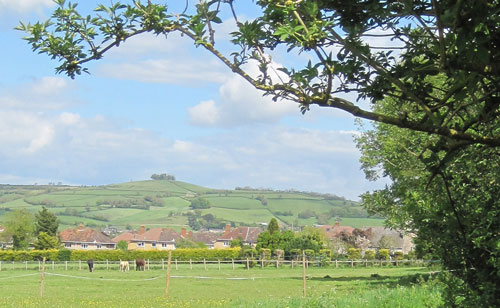
Fields by Manor Road that were the subject of the Saltford Green Belt Inquiry in 2013.
Estimates state that the West of England area needs at least 85,000 new homes by 2036, that is 29,000 more than the number already planned in Core Strategies, as well as the transport and other infrastructure needed to support that level of growth.
Many in Saltford will recall the long and successful campaign to protect Saltford's Green Belt from developers before, during and after the 2013 Public Inquiry and in the consultations leading to the B&NES Core Strategy in 2014.
It will therefore come as no surprise that we are now about to embark on a new defence of Saltford's Green Belt as developers seek to have parcels of our Green Belt removed from the Green Belt for housing development in the forthcoming West of England Joint Spatial Plan.
We have published an article on our Green Belt page (link) about the West of England Joint Spatial Plan (JSP) and SEG's response 'Very special circumstances and the Green Belt' made on 27 January to the consultation for 'Issues and Options' in the JSP that is currently being drafted for initial consultation in June 2016. SEG is and will be working closely with the Parish Council to resist this.
Our submission paper 'Very special circumstances and the Green Belt' makes a detailed case concerning the need to protect food security, and demonstrates that planning policy and the democratic mandates of our political leaders in this area rule against new developments on the Green Belt and agricultural land; a much valued designation the protection of which is increasingly vital. The paper covers these topics:-
- Population growth, food security and protecting our 'natural capital'
- Where do we put new housing?
- Green Belt planning policy
- Democracy and political considerations in B&NES and Saltford
You can download and read 'Very special circumstances and the Green Belt' on our Green Belt page (link). Do share this paper with those who share our view that the Green Belt in this area and elsewhere in the West of England should be protected from development.
A major priority and activity for SEG in 2016 will be defending Saltford's Green Belt in the context of the Joint Spatial Plan. We shall aim to keep members informed and advise if there is anything you can do to help SEG and the Parish Council defend the Green Belt. Do encourage friends and neighbours in Saltford to join SEG.
Return to top of page
Roman Saltford: Geophysics survey report published

A twin probe resistance meter in use during the geophysics survey in Saltford, 28 October 2015.
Between 27 October and 4 November 2015 Bath and Camerton Archaeological Society (BACAS) supported by volunteers from SEG carried out a geophysics survey for a significant section of the field on the south side of Saltford where a Roman coffin complete with the skeleton of a young man was found in 1948. The survey report is now published on SEG's website (Online Museum). We have produced a summary of the findings here.
The year after the coffin was found, some trial trenches were dug to determine whether there was any other evidence of Roman occupation. The excavations unearthed pottery fragments, coins, nails and utensils as well as 'oyster shells too numerous to record'. There was a suggestion that there may have been a road in this location, but whether this was of Roman origin was unable to be determined. This survey carried out in 2015 at SEG's request is the first time a geophysics survey has been made of this field.
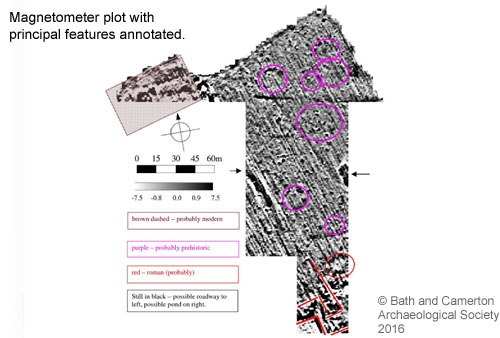
Image (minimised) from the survey report of the
magnetometer plot with principal features annotated.
The 2015 survey indicated the possible presence of some prehistoric roundhouses in the northern portion of the field. These possible roundhouse drip gullies suggest Iron Age settlement in the area (Note: a late bronze age axe blade was discovered in this field in 2014). Interestingly, possible evidence of roundhouses was found by BACAS in 2013 on a similar latitude due east on Saltford Golf Club land being surveyed in connection with the planning application for a new golf academy.
Of particular interest and thus linked to the Roman coffin were signs of what may be a Roman structure on higher ground to the southern end of the field. The lines are quite sharp, of limited length and are set at right angles to each other. Any Roman structure of this nature in this part of the country would most likely be built of stone. To the north-east of this is a sub-circular feature which appears too strong to be another round house, and is assumed to be part of the Roman complex.
Other findings & acknowledgements
In the north western corner of the field, there are signs of disturbance but it is possible that this may be modern. Although there are lines in this area which look a little building-like, they are perpendicular to the ploughlines, which suggests they may just be marks related to this ploughing. These blocks appear to be of the order of 5m wide, suggesting they are relics of older ploughing techniques, perhaps post-medieval 'narrow rig'. A trackway running up the west side of the field is visible over part of its length. There also
appears to be a feature, possibly an ancient pond (now filled in), approx 45m within the field on the eastern edge of the area surveyed.
An area of over 2 hectares was surveyed over the course of four days in late autumn on a stubble field. However, time was a major constraint, so a large portion of this field was left untouched and will need further work when it is next available if an indication of the size and scale the Roman structure is to be revealed.
SEG is very grateful to the landowner, Adam Stratton, for allowing access to the field, to BACAS for carrying out this geophysics survey and for the assistance of survey volunteers from BACAS and SEG named in the report.
The full report can be downloaded from our history project Online Museum - Roman Saltford section (link).
Footnote 1: Equipment used for the geophysics survey
Two types of geophysics equipment were used over numerous grids marked out by volunteers, a magnetometer and a resistance meter (x2 to save time). The magnetometer measures anomalies in the Earth's magnetic field whereas the twin probe resistance meter works by injecting a small electrical current into the ground and calculating the resistance to it that is affected by buried stone walls etc. The resistance readings complement the magnetometer readings
which detect minute magnet field anomalies that can be made by buried archaeology.
Footnote 2: Metal detection surveys
With the landowner's permission for each survey, the field has been the subject of several metal detection surveys in recent years and these have revealed some bronze Roman coins, and other small bronze items that can be found in our history project's Online Museum. Due to those surveys the discovery of further coins etc. of any particular new significance or value is not anticipated.
Return to top of page
Get in quick to access B&NES home improvement grant
B&NES Council currently has a grant of up to £6,000 available through the Energy at Home scheme to help you make energy saving improvements to your home.
The grant can be used to help cover the costs of improvements such as:
- improved heating systems (including gas and oil fired systems, and electric storage heaters);
- internal, external, or cavity wall insulation, and loft insulation;
- upgraded glazing including secondary glazing, double glazing and external doors; and
- renewable energy technologies.
Installing measures like these can help improve your home's energy performance, reduce the amount you spend on your energy bills, and help keep your home warm and cosy over the winter.
This grant is available to all home owners, private landlords and privately renting tenants. You do not need to be on a low income or an elderly person to be eligible for this grant, but you do need to be signed up before the end of February.
Details from www.energyathome.org.uk or contact the Energy at Home Advice Service on 0800 038 5680.
Return to top of page
Medieval artefact found on Saltford/Keynsham border
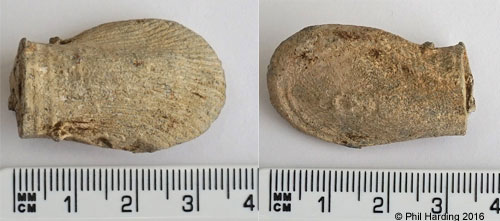
This image shows both sides of the ampulla
This medieval Pilgrim's Lead Ampulla (c.1175 - c.1500) featuring a scallop shell was discovered in December 2015 on the Saltford/Keynsham boundary, due west of Grange Road. It is now featured in our history project's Online Museum (5C - 16C page).
A lead pilgrim's ampulla is a miniature vessel (phial) used to hold holy water dispensed to pilgrims at holy shrines. These mass produced items were also pilgrimage souvenirs giving pilgrims an outward display of proof of travel, experience or affiliation when worn around the neck on a cord or chain as a pendant. Scallop shells were also commonly used as the design motif for pilgrim badges and featured as the design for some ampullae.
Coming into use in the last quarter of the twelfth century, ampullae were, in England, almost the only kind of pilgrim souvenir to be had during the 13C. They were available at a number of shrines and having been brought back by returning pilgrims, or sold by entrepreneurs, probably featured as secondary relics in many 13C English parish churches.
The scallop shell, in different shapes and sizes, has long been the symbol of the Camino de Santiago - the name of any of the pilgrimage routes to the shrine of the apostle St. James in the Cathedral of Santiago de Compostela in Galicia in NW Spain. Scallop shell artwork can be seen (2016) on the ancient doors and on the archway above the doors of the cathedral.
FOOTNOTE & FURTHER THOUGHTS:
This unusual relic gives a fascinating glimpse into the past history of the local area and illustrates just how widely travelled some people were all those years ago.
In medieval times the journey from Bristol to Santiago (NW Spain) was a popular pilgrimage route. Also St Anne's Well (a healing well) and the chapel of St. Anne in the Wood, at Brislington, were an important and popular medieval pilgrimage destination - as popular then as Canterbury and Walsingham. Although records from that period are scant and the chapel itself has long since disappeared, it is thought that the chapel was owned and run by Keynsham Abbey. The Abbey was operational until the dissolution of the monasteries in 1539.
Perhaps a pilgrim returning to Saltford over 700 years ago on his way back either from Spain via Bristol or from Brislington was riding his horse or walking across the fields, the cord/chain holding the ampulla broke and he lost it or he was set upon by thieves and during the ensuing scuffle the ampulla was lost.
Or maybe there is another explanation of how it arrived on the borders of Saltford and Keynsham...
Acknowledgements/Information sources:
Ampulla found by Bob Mordle 29.12.2015.
Lead Ampullae: http://en.wikipedia.org/ and https://finds.org.uk/ (2016).
Return to top of page
Opportunity to coordinate local habitat project

Crosswort growing on the railway habitat restoration project area.
Saltford Environment Group is looking for a volunteer to be our railway path habitat restoration project coordinator to take the project to its next phase. This local project has seen some notable successes:
- The return of a number of rare and unusual plants to the area.
- Fantastic views recreated across to the village and the river.
- Thanks and congratulations from Railway Path users.
- Some first class efforts from our team of community volunteers and from Saltford's Guides, Beavers and Scout groups.
- Removal from the upper and middle slope of the previous large population of the unwelcome alien invasive Himalayan Balsam.
The area needs some concerted effort over the next 2-3 years to prevent the area from reverting back to scrub and trees: obscuring views and shading some of the rare sun-loving plants that have so recently returned. This work is likely to involve:
- Regular practical volunteer sessions during the growing season - pulling invasive weeds such as nettles and brambles (3 - 4 sessions per year).
- Monthly strimming sessions (during the growing season) - shared between volunteers.
Saltford's Guides and Beavers are keen to do practical volunteering sessions in the spring and autumn and SEG has a list of further volunteers who are also willing to help.
The role of the project coordinator will be:
- To work with our volunteer wildlife advisor to agree priorities and plan activities.
- To organise volunteer parties with local Guide, Scout and Beaver Groups and with our team of volunteers.
- To organise, and share with other project members, a rota for strimming activities during the summer months.
This is a great opportunity for someone with good organisational skills to help deliver a really exciting project: restoring a rare and beautiful habitat and bringing the community together through fun, practical activities.
No prior experience of wildlife conservation projects is required and there will be plenty of opportunities to learn more about the rare and beautiful plants and animals which would otherwise disappear from our area, to make new friends and learn new skills along the way.
If this opportunity to manage a small yet interesting and local outdoor project appeals to you, to express an interest please contact our wildlife adviser by email via our Chairman Phil Harding (see Contact SEG).
Return to top of page
Parish Council and Saltford station
At its monthly meeting on 5th January Saltford Parish Council unanimously agreed the following request that it would put to B&NES Council:
Saltford Parish Council reminds B&NES Council of its role since 2011 as the official promoter of the station and asks B&NES Council to make an effective and renewed commitment to engage with the West of England Local Transport Body, GWR and Network Rail to seek the re-opening of Saltford station and to make every effort to secure a place for Saltford station in the Metro West timetable.
Saltford Parish Council notes that the public leaflet produced by the West of England Partnership Metro West - Investing in our local rail network (June 2014) stated that a Saltford Station could be in Metro West phase 1 subject to the business case. Saltford Parish Council therefore wishes to express its concern that B&NES Council did not seek to include Saltford Station in the current Metro West timetable studies being
carried out by GWR on behalf of the West of England Local Transport Body. Saltford Parish Council wishes to express its dissatisfaction that reasons given for this include comments on time-table constraints which would have been better determined by Saltford actually having been included in these studies.
Saltford Parish Council notes that while alternatives need to be considered as part of the Department for Transport's TAG (Transport Analysis Guidance) process and also to fulfil a past resolution of B&NES Council, there remains a consensus that the existing site is the preferred site option.
Return to top of page
What's YOUR carbon footprint?

Ever wondered how big your own personal environmental footprint is? The term "environmental footprint" refers to the environmental impact including carbon emissions and other pollution, creation of waste, resource depletion etc. that your lifestyle choices have on the planet. Our "carbon footprint" is a similar measure as most activities lead to some level of carbon dioxide and/or other pollutant emissions into the environment.
The WWF 'Carbon Footprint Calculator' at http://footprint.wwf.org.uk/ enables you to calculate your personal carbon footprint using the answers you provide to a simple 5 minute questionnaire. The website calculates your carbon footprint as a result of your lifestyle choices and provides tips and ideas for how you can shrink your footprint.
It doesn't take long and the on screen report gives a simple breakdown of your footprint between what it calls Food, Home, Travel, and Stuff. It even shows how you compare to the UK and world average (see image above).
Give it a go, see how you compare and discover what you can do to shrink your impact: http://footprint.wwf.org.uk/
Whatever we do to nature, we do to ourselves
Kurt Heidinger
For future reference we have a link to the WWF carbon footprint calculator from our energy page (under the "Energy in the home" section) where we also have some tips on how you can save energy and money.
Return to top of page
January 2016:
IYP2016: Eat Beans, Peas, Chickpeas and Lentils!
2016 has been declared by the United Nations as the International Year of Pulses (IYP2016). The main objective of IYP2016 is to increase awareness of pulses globally, and to increase demand, utilisation, and production of pulses worldwide. Using events, campaigns, websites and social media, the project will ensure that by the end of 2016, more people will know about pulses.
Pulses, also known as grain legumes, are a group of 12 crops that includes dry beans, dry peas, chickpeas, and lentils. They are high in protein, fibre, and various vitamins, provide amino acids, and are hearty crops. They are most popular in developing countries, but are increasingly becoming recognised as an excellent part of a healthy diet throughout the world.
The following information is from the IYP2016 website:-
- Pulse crops are one of the most sustainable crops a farmer can grow. It takes just 43 gallons of water to produce one pound of pulses, compared with 216 for soybeans and 368 for peanuts. They also contribute to soil quality by fixing nitrogen in the soil.
- Though pulses are a very popular crop in the developing world, there is a massive gap in productivity between pulse crops inside and outside the developing world. With the introduction of improved varieties and promotion of better management techniques, pulse crops can continue to be an excellent choice for farmers in the developing world.
- Up to 25% of pulses are used as feedstuff, particularly for pigs and poultry. As a steady source of nutrition, feed for animals, and soil sustainability, pulse crops play a major role in food security, a role which will only grow in the future.
The IYP2016 website has lots of information and ideas for things people can do, how to get involved, learn more about pulses etc. It's at: http://iyp2016.org.
Return to top of page
Development on Keynsham's (former) Green Belt near Wellsway School
The Mactaggart & Mickel plans (phase 1) for building up to 250 homes and a primary school on Green Belt land east of Keynsham which were allowed in the 2014 B&NES Core Strategy are published for public consultation until 15th January and can be found on the Mactaggart & Mickel website at www.macmicgroup.co.uk/land/england/east-keynsham.
At this point the timing of the submission for outline planning permission and commencement of the development's construction is not known.
Several members may recall that Mactaggart & Mickel also sought, unsuccessfully, inclusion in the B&NES Core Strategy (2014) a proposed development on Saltford's Green Belt west of Saltford. This would have been through a westward expansion of Saltford from Grange Road and, in effect, merging Keynsham and Saltford.
The position that SEG took, and on which we and others lobbied during the Core Strategy examination by an independent inspector, was that the national and local planning policy case against the development on the Green Belt west of Saltford was extremely strong.
Members will be concerned that the east of Keynsham development will worsen peak time congestion on the A4, and represent partial erosion of the open space between Saltford and Keynsham. However, our case against developing the remaining Green Belt space between Saltford and Keynsham remains strong and is not weakened by the east of Keynsham development.
SEG is helping Saltford Parish Council formulate the Parish Council's response to the current consultation for 'Issues and Options' in the West of England Joint Spatial Plan* so that a robust case is made for the continued protection of the Green Belt from development.
*The West of England's Joint Spatial Plan and Transport Study (at https://www.jointplanningwofe.org.uk) will set out a prospectus for sustainable growth that will help the area (Bristol, North Somerset, South Gloucestershire and Bath & North East Somerset) meet its housing and transport needs for the next 20 years. Estimates state that the area needs at least 85,000 new homes by 2036, nearly 30,000 more than the number already planned in Core Strategies, as well as the transport and other infrastructure needed to support that level of growth.
Return to top of page
Upcycling in January
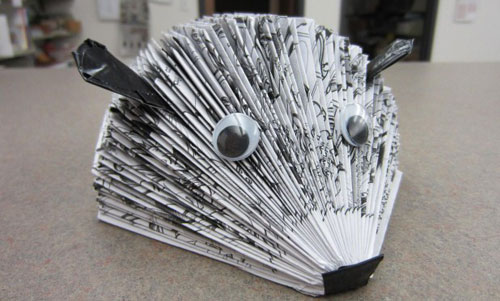
Think crafty thoughts for 2016. Come along to The Saltford UPCYCLING Craft Group workshop on January 21st when we will be crafting hedgehogs from old books. These cute hedgehogs are something that children can help make and once you start there are endless possibilities to let your imagination take over. Our workshops are fun and friendly with everyone sharing their ideas and learning together. You won't look at recycling or throwing away bits and pieces the same way again.
WHEN: 7 - 9 pm, Thursday 21st January
WHERE: Signs of Saltford (works entrance), 559 Bath Road, Saltford (hosted by Tina Curtis)
If you would like to join us or hear more about our group Frances Eggbeer would love to hear from you on 07789--528834.
Return to top of page
Important rail electrification news
At the Network Rail in Saltford on 15th December at St Mary's Church Hall information was shared with residents about the planned works at and near Saltford as Network Rail continues to prepare for the electrification of the main-line. Passengers will notice structural changes to the platform and canopies at Keynsham station beginning in January 2016.
Keynsham station and the line itself will be closed from 2nd to the 10th of April 2016 whilst the track bed and platforms are lowered and foundations laid for the overhead electric pylons. Replacement buses will operate throughout this period. Fortunately, and thanks to Brunel, Saltford Tunnel underneath Tunnel House is high enough to accommodate the overhead cables and gantries without requiring additional engineering work.
The Network Rail website with more information concerning this work is at www.networkrail.co.uk/great-western-route-modernisation/.
ACKNOWLEDGEMENT: Our thanks go to Parish Council Chairman Cllr Duncan Hounsell for providing this information.
Return to top of page
Fracking: Onshore gas exploration stays out of local area for now as National Parks put at risk
The 2nd and final tranche of the 14th landward oil and gas licensing awards was announced by the Government on 17th December. Licences for a total of 159 blocks were formally offered to successful applicants under this licensing round. The blocks that were offered for our immediate area (ST 55, 56, 65, 66, 75 and 76) were not awarded. This maintains the position from when the 1st tranche was announced on 18th August 2015.
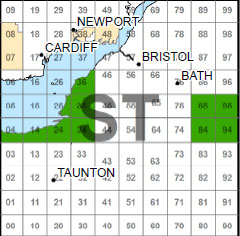
Map image from Oil and Gas Authority, 2015
The map above shows the blocks concerned (blocks marked green have been licensed in the 14th round and those marked beige were already licensed).
Further information on oil and gas licensing rounds can be found at https://www.gov.uk/oil-and-gas-licensing-rounds.
To the huge disappointment of anti-fracking campaigners, especially coming so soon after the Paris agreement to decarbonise the world's energy supplies, MPs voted on 16th December to allow fracking under Britain's National Parks. Ministers used secondary legislation (a statutory instrument) to push through the new rules without the requirement for a debate in the House of Commons. MPs voted 298 in favour to 261 against. These new rules
will allow fracking 1,200 metres below National Parks and sites of special scientific interest (SSSIs), as long as drilling takes place from outside those protected areas. This is despite the Government having previously pledged not to use fracking to extract shale gas in these areas.
At a time when renewable energy sources are becoming cheaper and likely to require no subsidies within a few years whilst the position for fossil fuels is likely to be the reverse as the cheaper more recoverable reserves have been extracted, it remains to be seen whether fracking will prove to be a realistic and viable option for the UK.
Return to top of page
Christmas & New Year present from Paris
After two weeks of deliberations and four years of failed attempts, on Saturday 12 December the world's nations agreed the first climate deal to commit all countries to cut carbon emissions at the UN climate summit (COP21) in Paris attended by 195 nations.
It may not be the perfect deal and the success or otherwise of the "Paris agreement" will be determined by action taken hereinafter, but nevertheless the agreement is recognised as a major step forward by most commentators.
The key measures in the Paris agreement include:
- To reach peak greenhouse gas emissions as soon as possible and achieve a balance between sources and sinks (absorption) of greenhouse gases in the second half of this century.
- To keep global temperature increase "well below" 2C and to pursue efforts to limit it to 1.5C.
- A long-term goal of net zero emissions by the end of the century, showing that the world is committed to decarbonising. Progress against this goal will be independently assessed in 2018 and then every five years.
- A legal obligation to make new post-2030 commitments to reduce emissions every 5 years, from 2025. For the first time, all countries will be held accountable by independent review for acting according to their pledges.
- $100 billion a year in climate finance for developing countries by 2020, with a commitment to further finance in the future.
Furthermore the agreement emphasised the enduring benefits of ambitious and early action, including major reductions in the cost of future mitigation and adaptation efforts.
It is not radical or naïve to seek a future where the climate is more stable, food security secured, affordable clean renewable energy heats and lights our homes and powers our industry and transport systems, and wildlife flourishes. As we enter 2016 perhaps we can have reasons to be hopeful that the world's Governments can finally work together to do the right thing and avert disaster before it is too late.
If the ambitions set by the Paris agreement are realised sooner rather than later this will bode well for the future well-being of not just present generations but for our children, our grandchildren and their children. The alternative is too ghastly to contemplate but should not be ignored; we all have a responsibility to maintain pressure on national and local Governments to make the transition to a low carbon economy sooner rather than later.
Links:-
Return to top of page
Big Garden Birdwatch (30/31 January): counting the wildlife that counts on you
The next Big Garden Birdwatch organised by the RSPB takes place over the weekend of 30 and 31 January 2016. This can involve all members of the family. All you need to do is count the birds that land in your garden or local park for one hour over that weekend and then tell the RSPB what you see. Record the highest number of each type of bird you see at the same time and don't count the total over
the hour as you may get the same birds visiting more than once.
Even if you don't get as many birds as you expected, your 'regulars' don't appear or even if you saw nothing, do still please let the RSPB know as it is all useful information that helps paint a picture of the nation's bird life.
For further information visit the RSPB Big Garden Birdwatch web page at www.rspb.org.uk/birdwatch/ - you will be able to log your bird count online from that link.
Local teachers or classroom assistants at Saltford School might be interested in the RSPB's Big Schools' Birdwatch from 4 January-12 February 2016. This is an educational activity that gets a class closer to nature. It takes just an hour and works for all ages and abilities. A bird ID poster is available free from the RSPB. Details at: www.rspb.org.uk/schoolswatch/.
Return to top of page
The Wondrous Wren (in winter)
One of the smallest woodland birds to visit our gardens, the Wren (Troglodytes troglodytes), can be seen and heard all the year round in Saltford and is one of our most fascinating songbirds. It is in winter when we are most likely to see it in our gardens.
These dumpy and active little birds are easily recognised by their rich brown plumage and perky short tail that is sometimes cocked vertically. Despite the Wren being one of our commonest birds it is easy to miss as it moves under cover around bushes, roots and low branches searching for food.
Here are some interesting facts about the Wren:-
- Wrens feed on spiders and insects which they find searching along the ground and bushes etc. probing into crevices with their long thin bill. They prefer cover so are rarely seen visiting bird tables. In the winter when food is in short supply they are less cautious and are seen more frequently in our gardens.
- In Britain the Wren population of approx. 8 million breeding pairs can be drastically culled by a severe winter. Fortunately their high egg productivity, with as many as 8 or 9 fledglings from one nest, means that numbers can usually recover after just a few years, especially after a run of mild winters.
- From 1937 to 1960 the Wren appeared on the reverse of the farthing (a quarter of a pre-decimal penny), then the smallest British coin.
- It is also known as Jenny Wren.
- The smallest British bird is not the Wren but the Goldcrest. However the Wren is the shortest and, for such a diminutive bird, has a surprisingly loud song that usually ends in a distinctive trill.
- The male Wren will build several nests (can be as many as 12), but only one is chosen and used by the female who then lines the nest with moss, leaves and/or feathers. Wrens will nest in all sorts of nooks and crannies and its scientific name, Troglodytes, means "cave dweller". Nests found without a moss or feather lining will be one of several built by the male; don't remove it as it may be accepted by the female, lined and used later.
- Wrens will sometimes use open-fronted and tit nest boxes which they fill with a ball made of moss, leaves and grass for nesting and, in winter, for roosting (in large groups to keep warm).
- Male Wrens are polygamous, mating with more than one female, and rarely help rear the young.
- The maximum recorded lifespan is 7 years.
To see the Wren and hear its song on the RSPB website click here: RSPB - Wren.
The best way to assist Wrens and attract them into your garden is by planting native species of shrubs and trees that will benefit insects and wildlife more widely. It is also helpful to create habitat for insects such as piles of logs, sticks and/or rocks. If your garden is over-manicured there is less habitat for insects that Wrens and other birds will feed on.
Information sources: www.bto.org, www.livingwithbirds.com, blogs.scottishwildlifetrust.org.uk
Return to top of page
Tips on feeding garden birds
With winter upon us, albeit a mild one, we have reproduced here some tips from our wildlife page on feeding garden birds:-
Although winter feeding benefits birds most, food shortages can occur at any time of the year. By feeding the birds year round, we give them a better chance to survive the periods of food shortage whenever they may occur.
Winter and cold spells in autumn are times when birds can go really hungry. If birds get used to feeding from your garden bird feeder and you then stop re-filling the feeder during cold weather, birds can waste precious energy getting to your feeder if there's nothing there on arrival.
Certain foods do more harm than good. For example peanuts, fat and bread in spring/summer can be harmful if an adult bird feed them to their young. Did you know that it's unwise to feed bread to birds? Its nutritional value is relatively low (an 'empty filler'), uneaten bread can attract rats, and a bird that is on a diet of predominantly or only bread can suffer from serious vitamin deficiencies, or starve. This is one reason why the National Trust, for example, asks visitors not to feed bread to ducks at its properties.
Feeder hygiene is important; salmonella can kill your garden guests. Use boiling water or buy specialised cleaning products that don't harm wildlife whilst avoiding regular detergents. Peanuts and fat balls are often sold in nylon mesh bags which can trap birds by their feet or beaks. The RSPB recommends always cutting off the netting before putting out the food. You might like to consider writing to the manufacturer to let them know how dangerous these bags are so that together we can stop this dangerous packaging from being sold.
Water for garden birds
A bird bath in your garden, whether a ready-made purchased one or homemade provides a great service to garden birds from the much needed water they need to drink or to help them keep their feathers in good condition.
According to the RSPB, ideally bird baths should have shallow sloping sides (so avoid steep sided bowls and dishes), be no more than 10cm deep and be as wide as possible, and at least 30cms across. Remember that birds are vulnerable while they're drinking or bathing, so have a think about where to place it. Think of it as a "puddle on a stick". It is ideal to put it about a couple of metres from any bushes where a predator might lurk, but not too far out in the open. Check that the inside of the bird bath is not too smooth (slippery). If it is the birds might slip into the water so
put some pebbles or rocks in the water to give them a better grip.
Return to top of page

© Saltford Environment Group
W3C compliant website
|

















































































